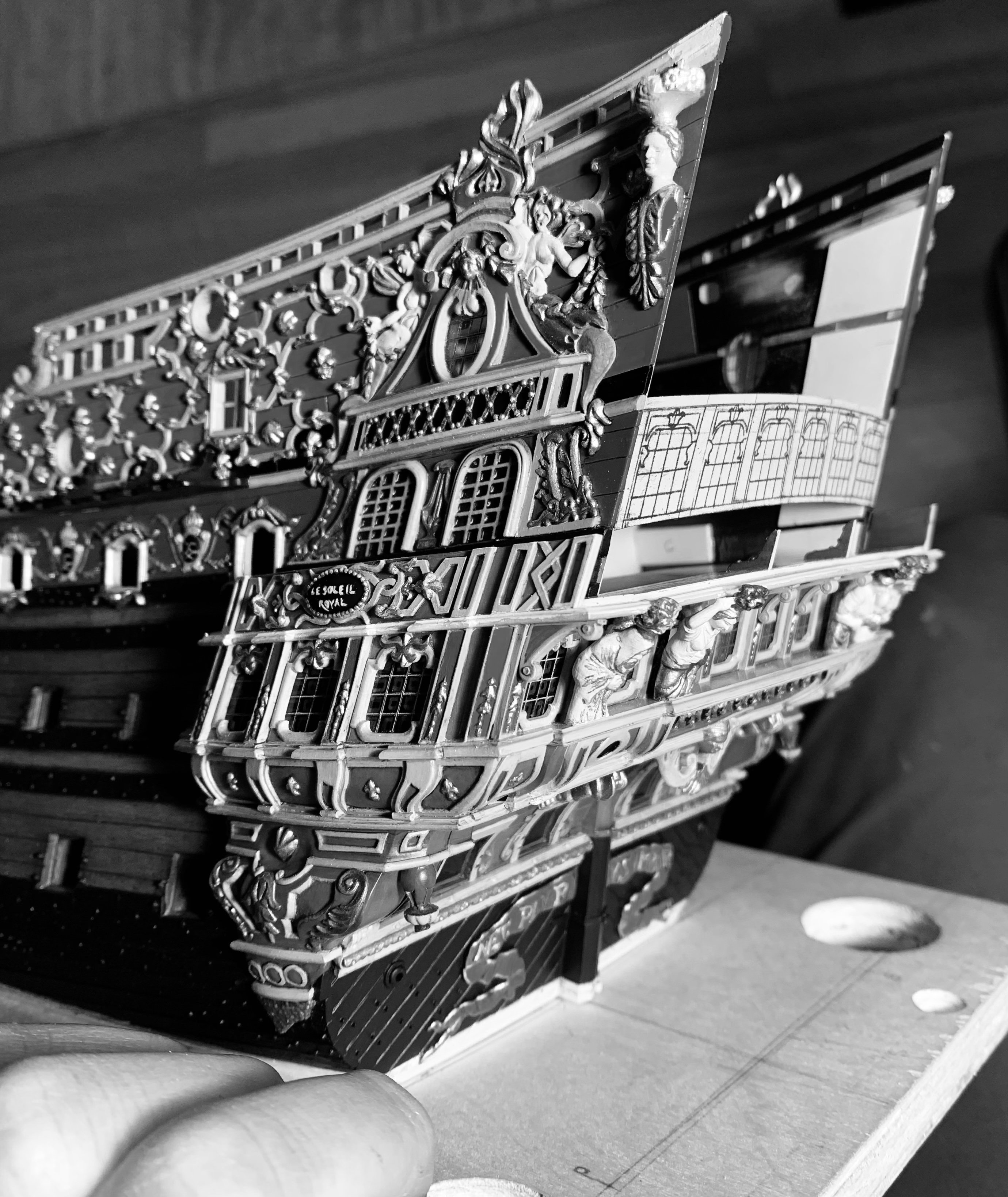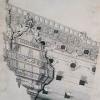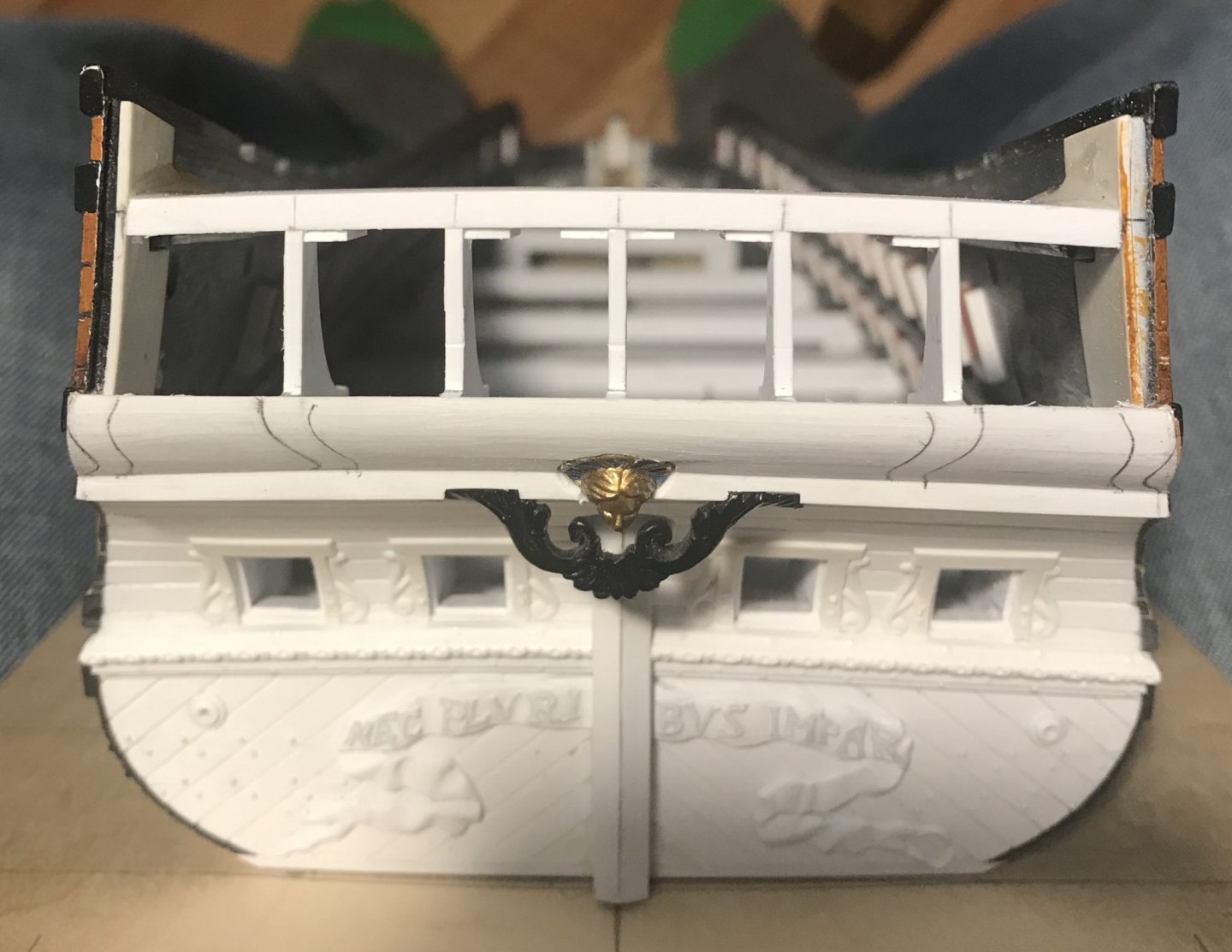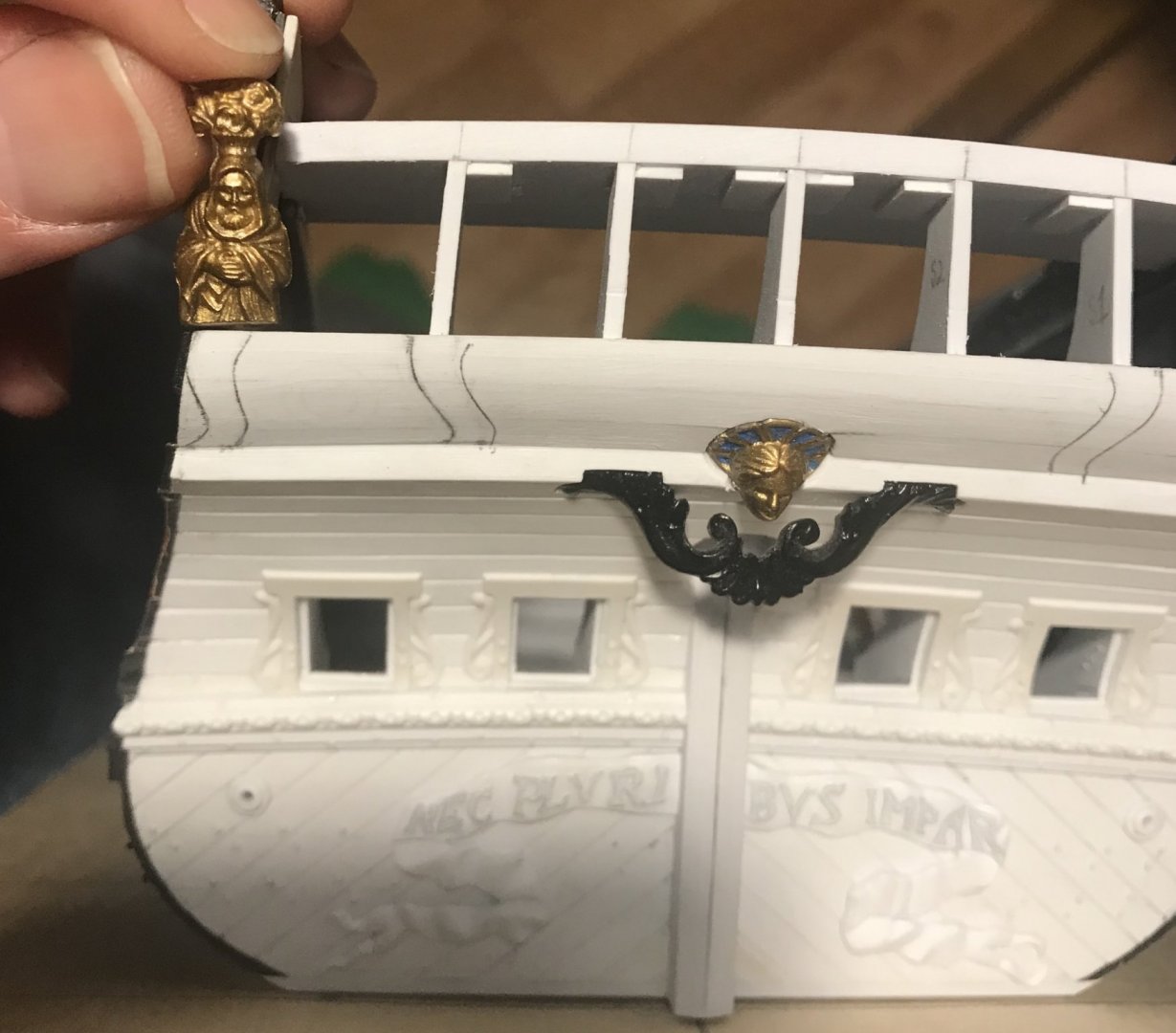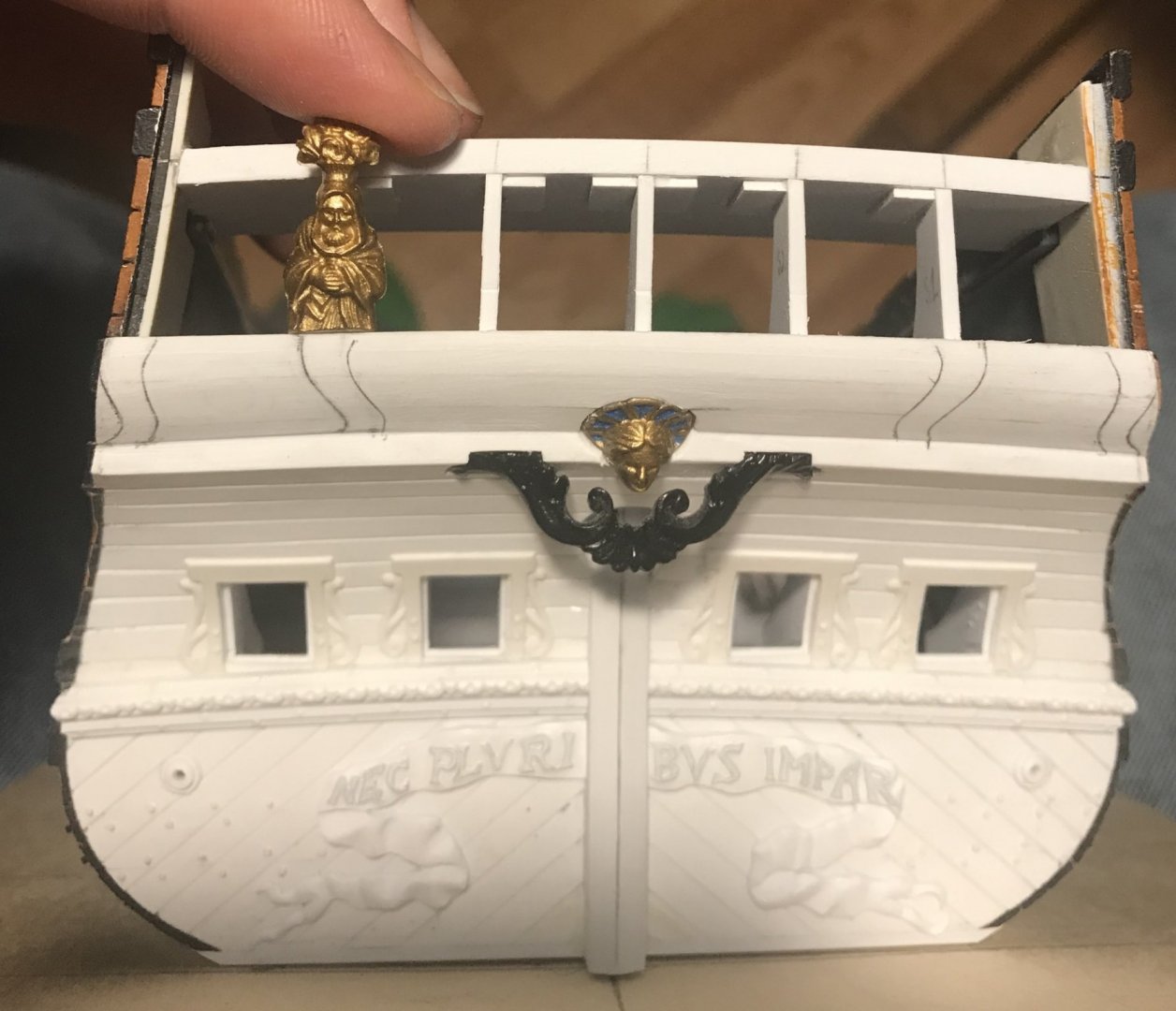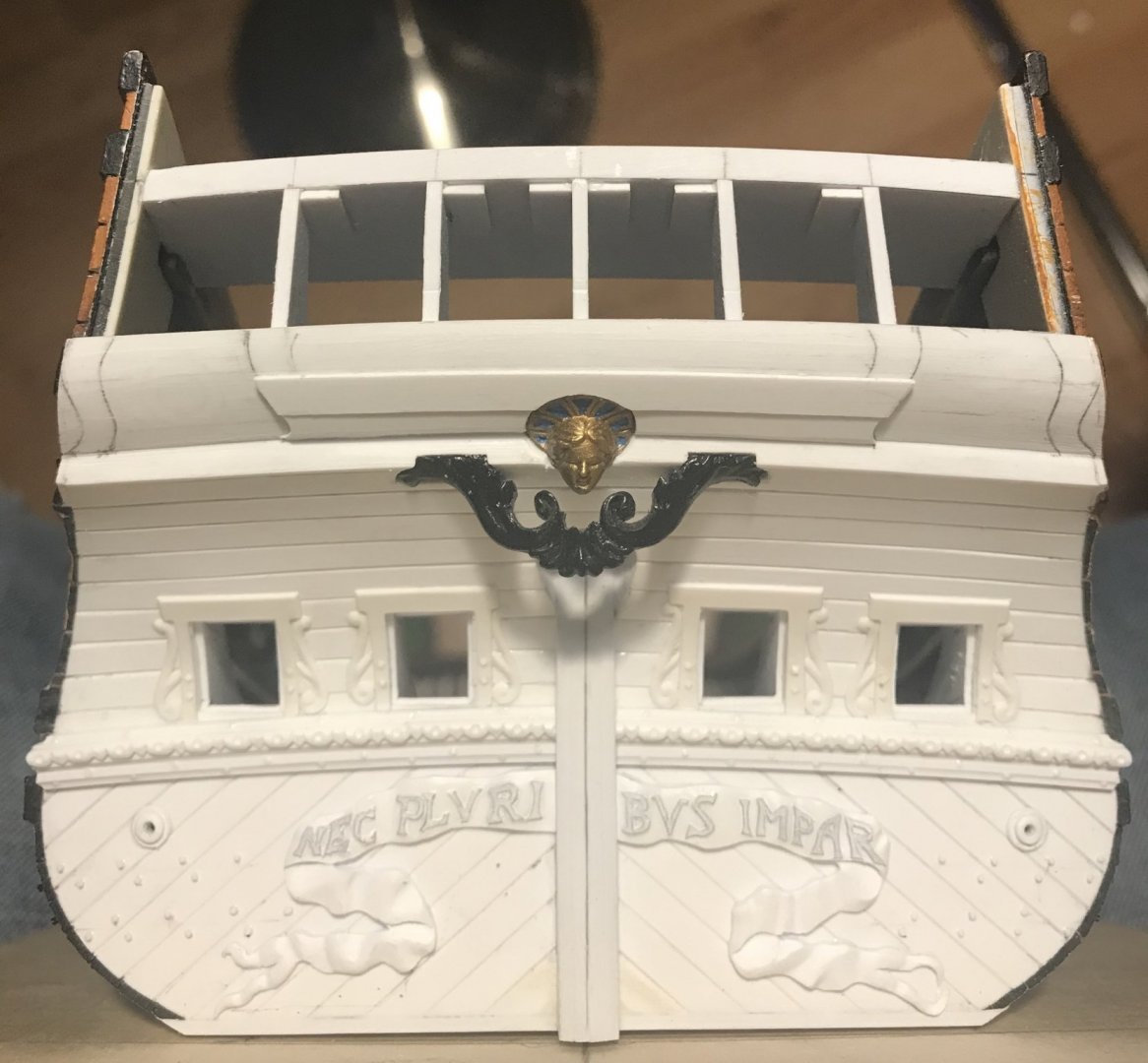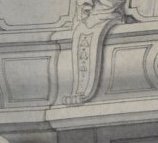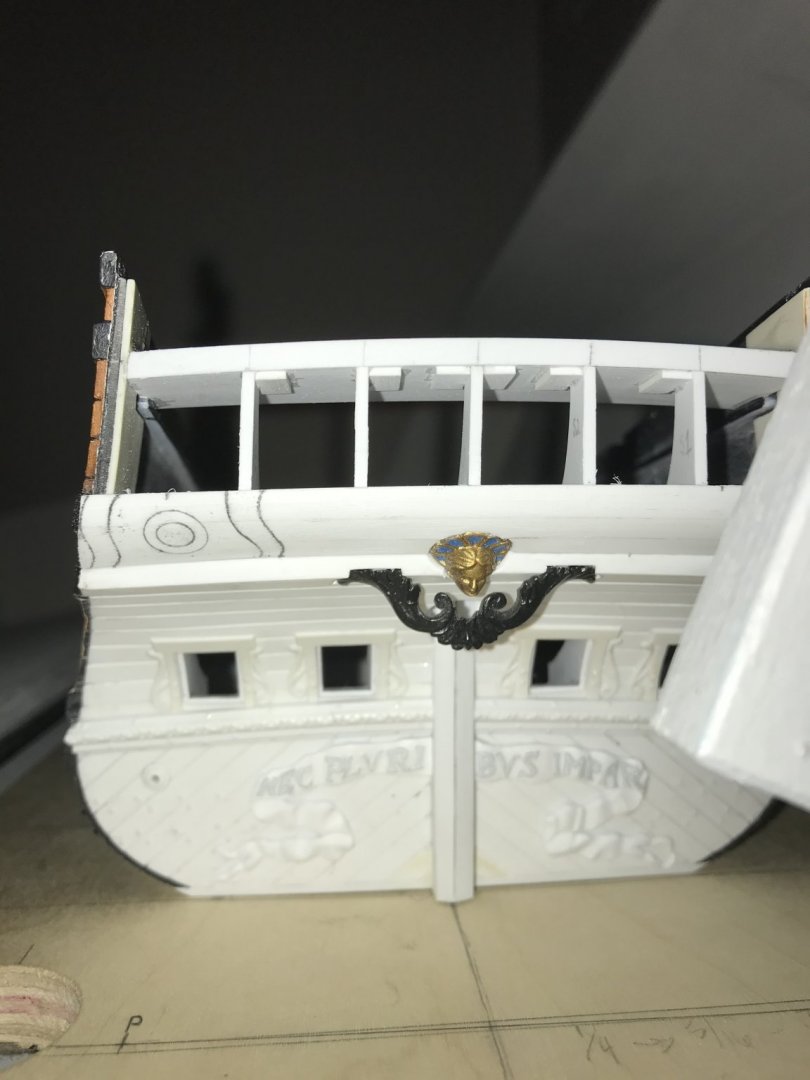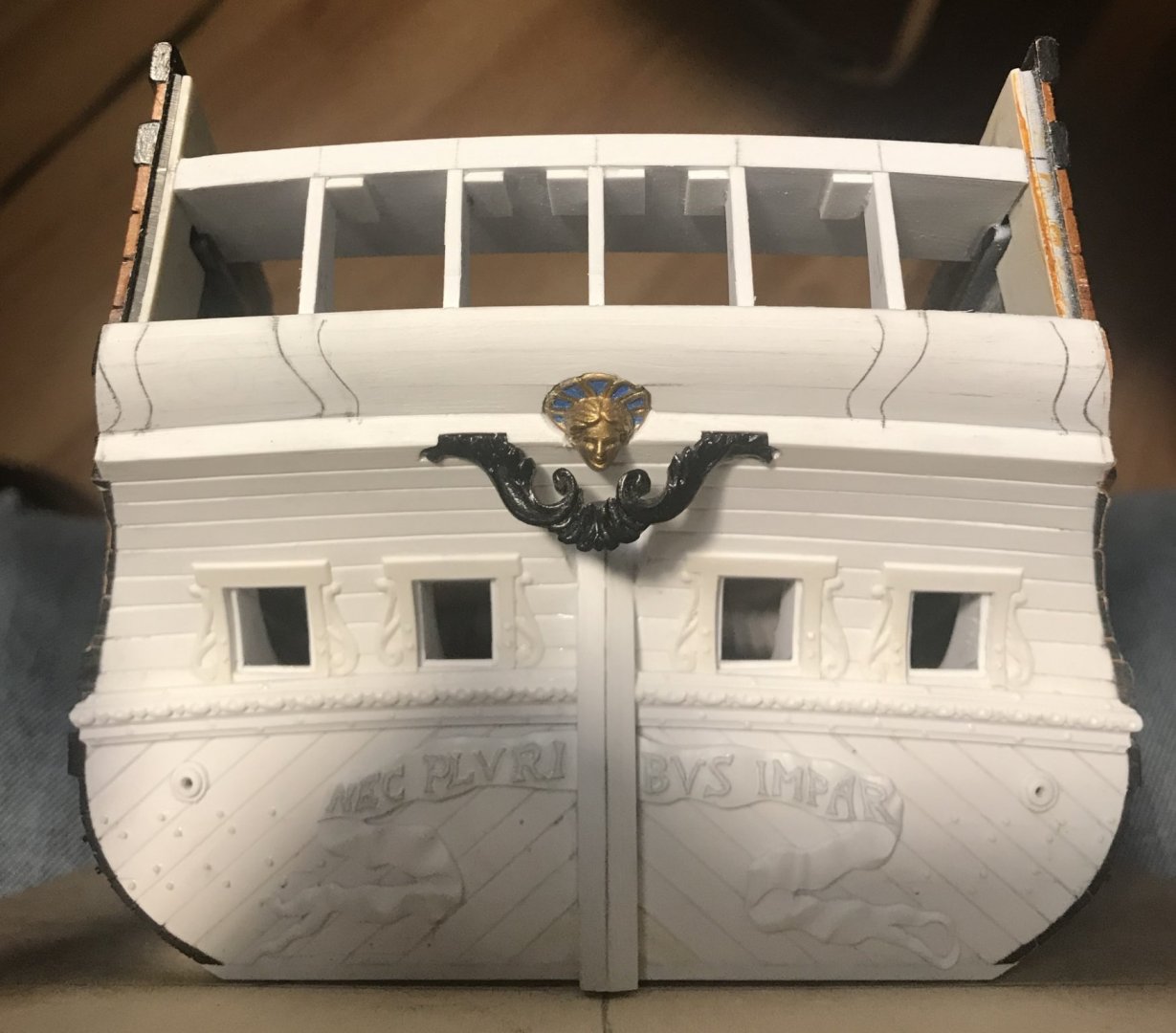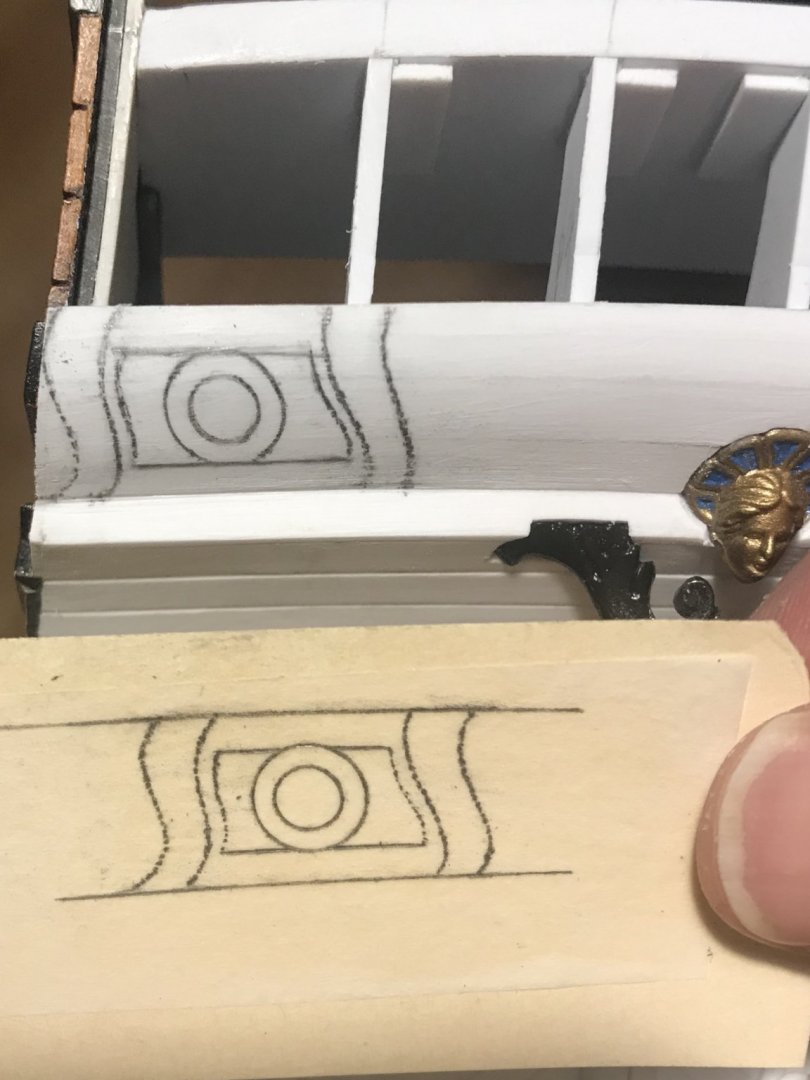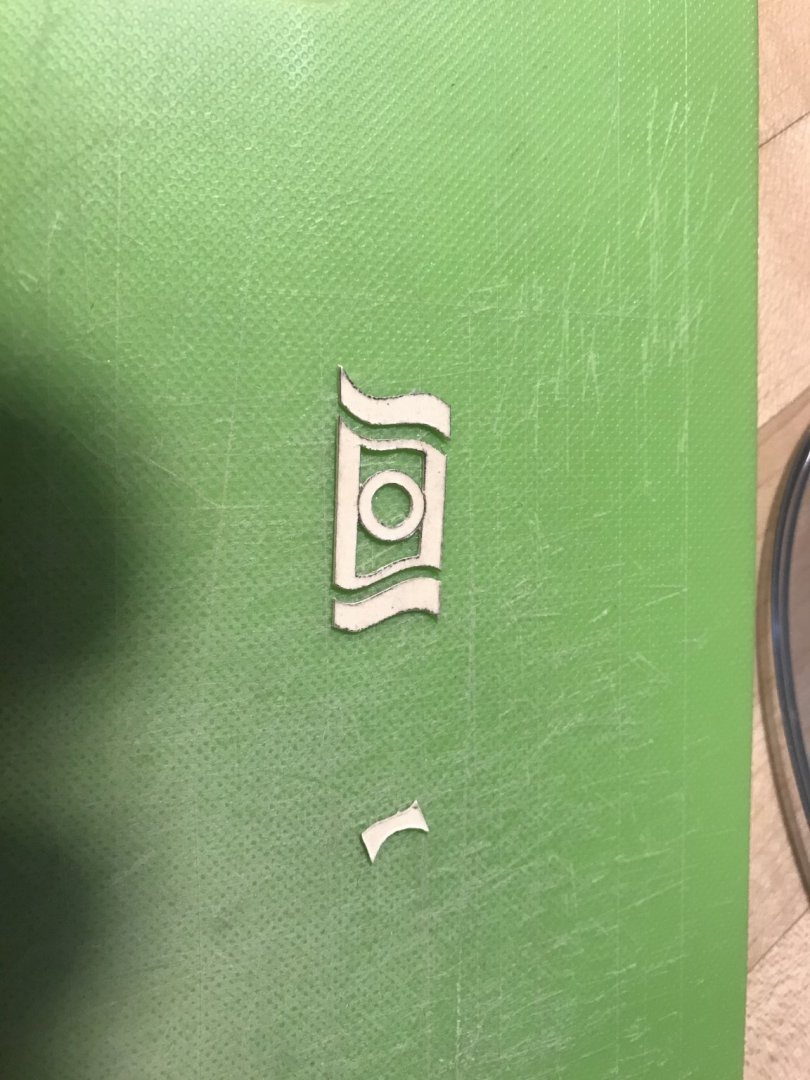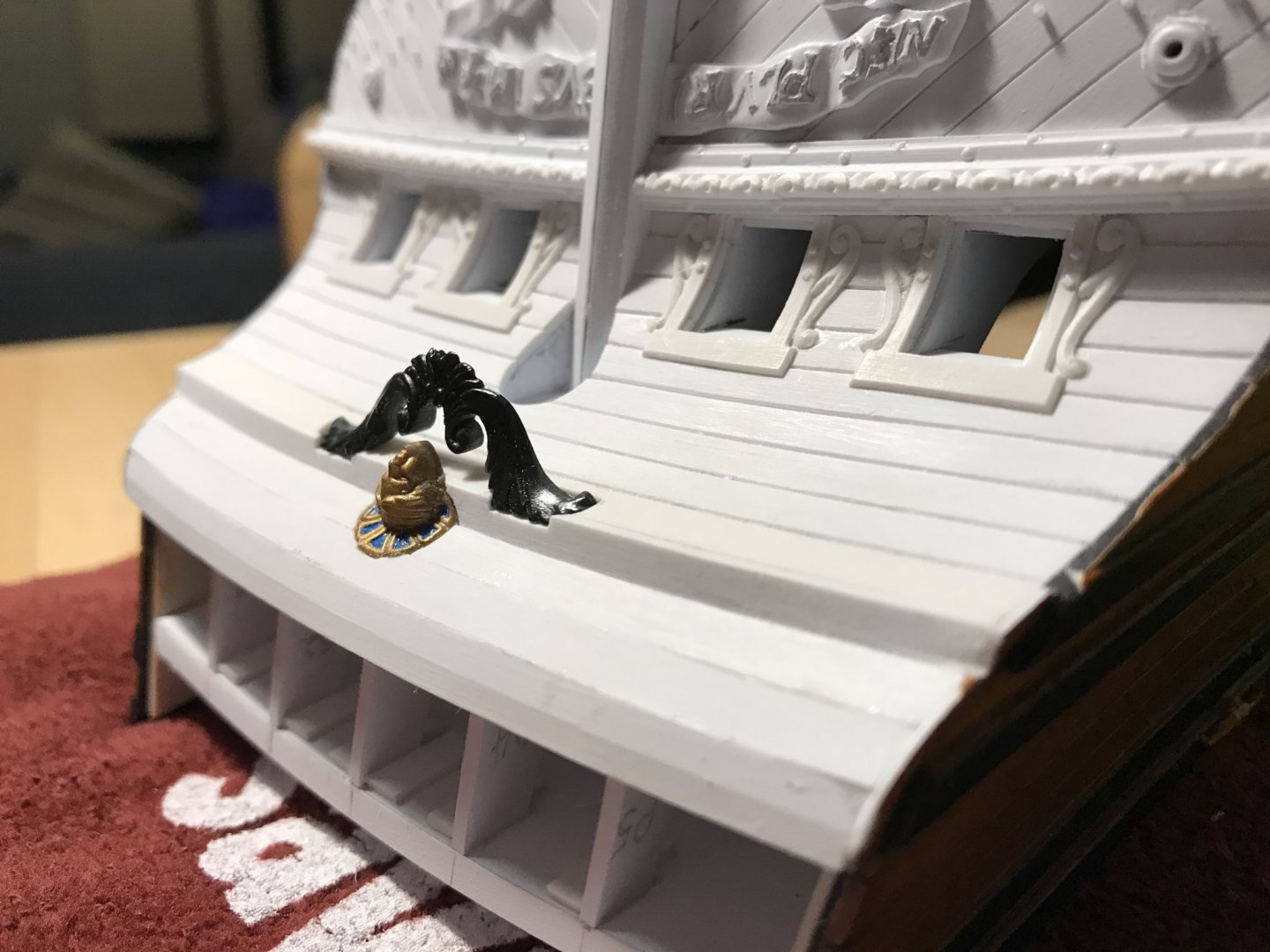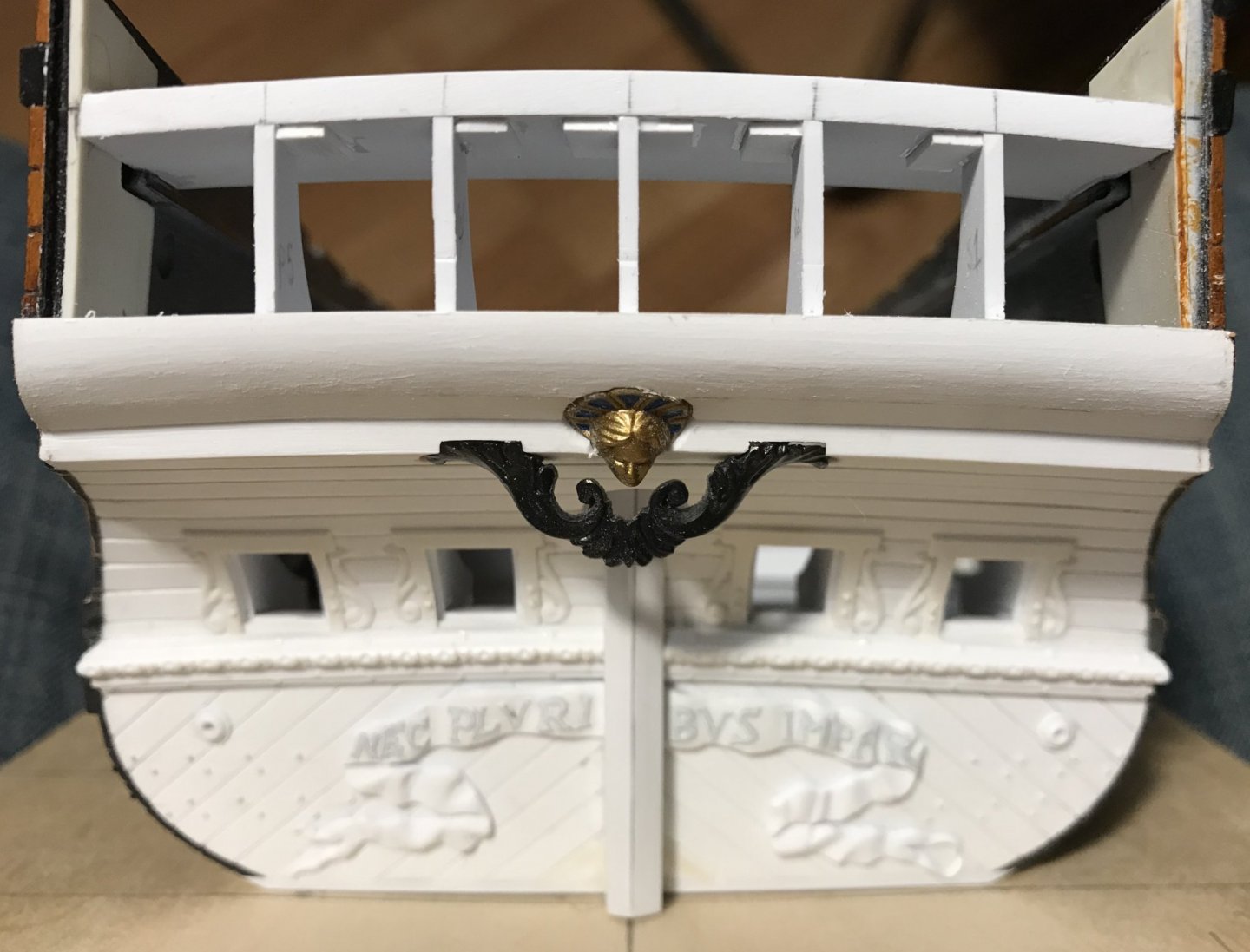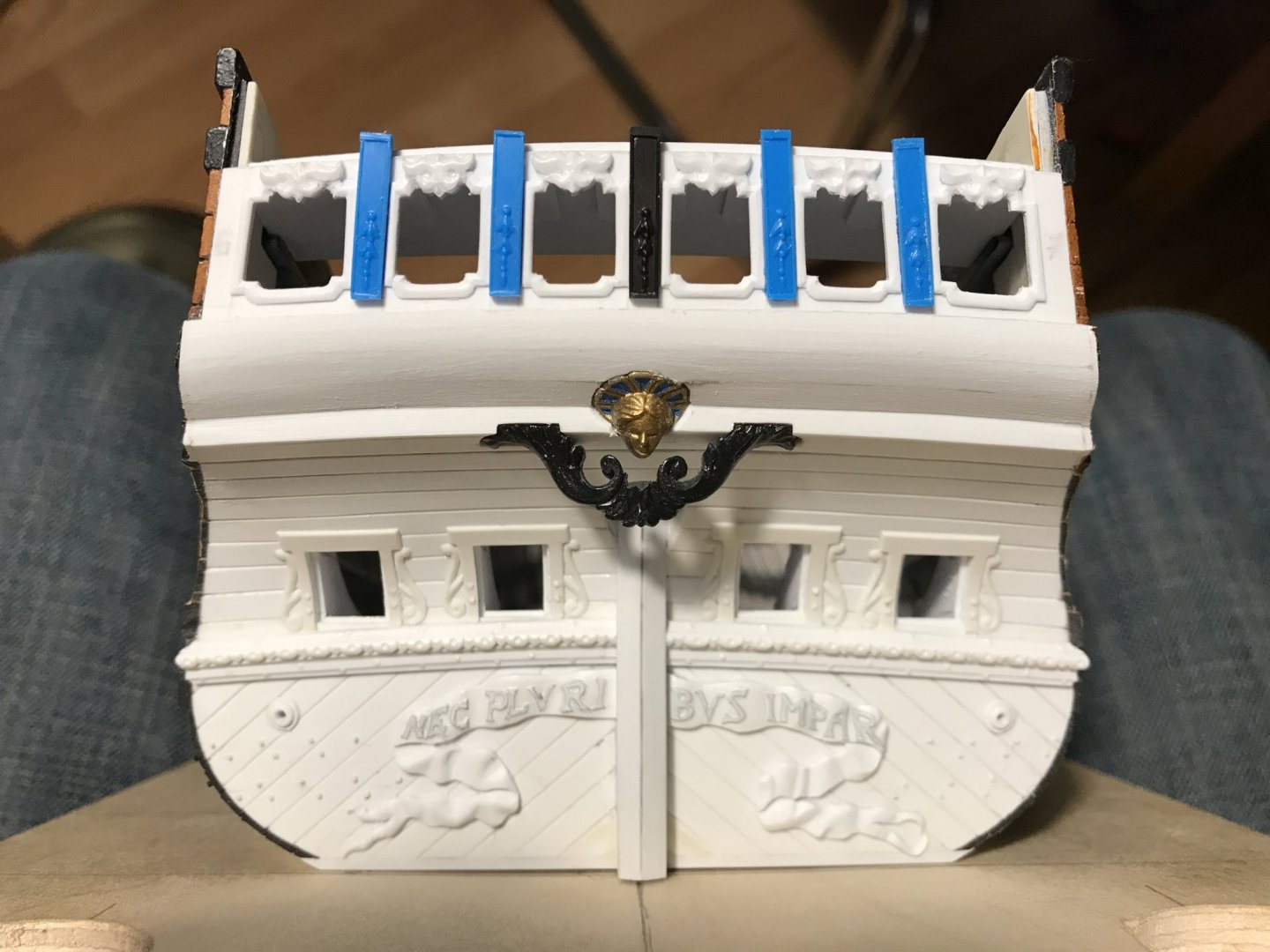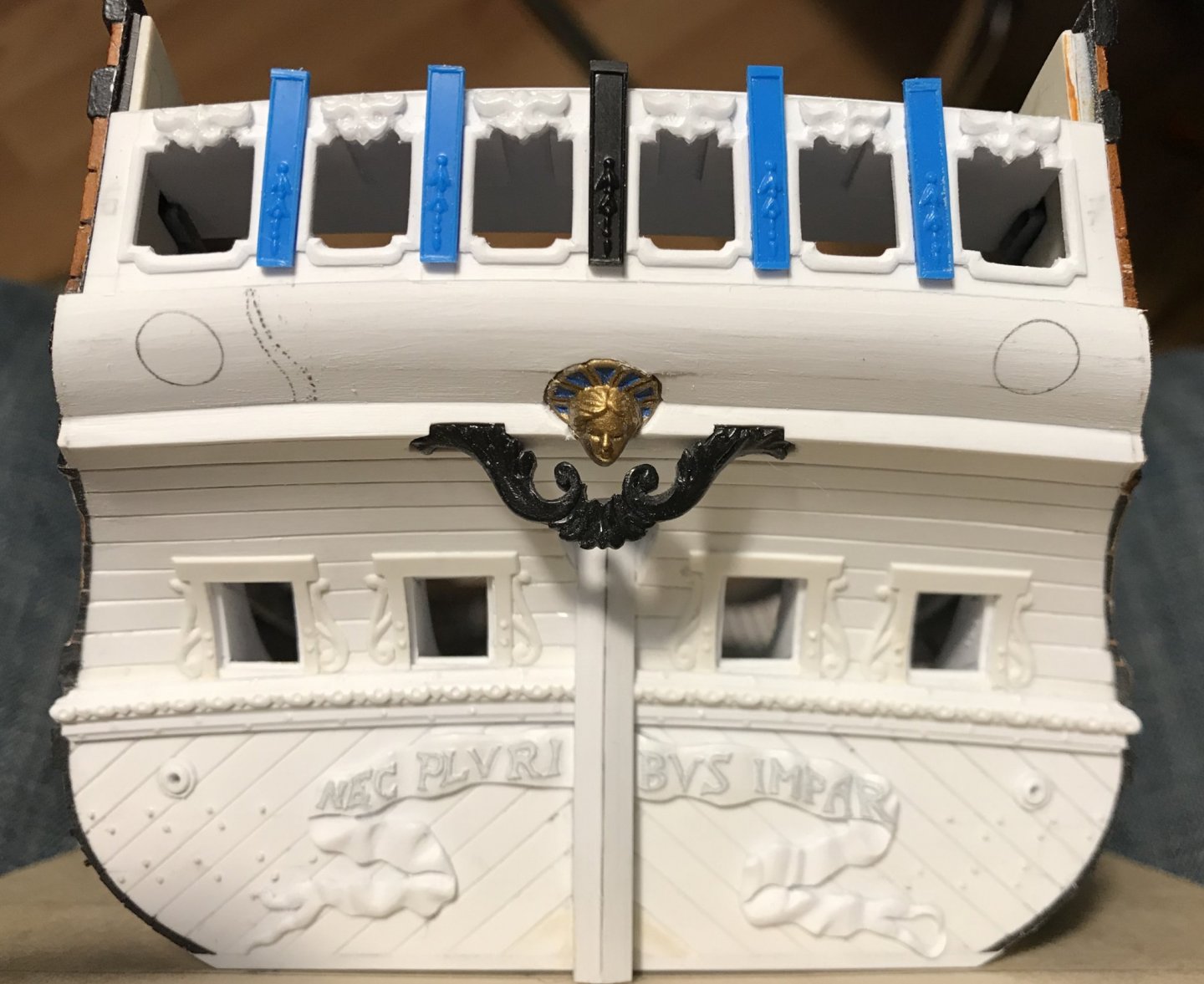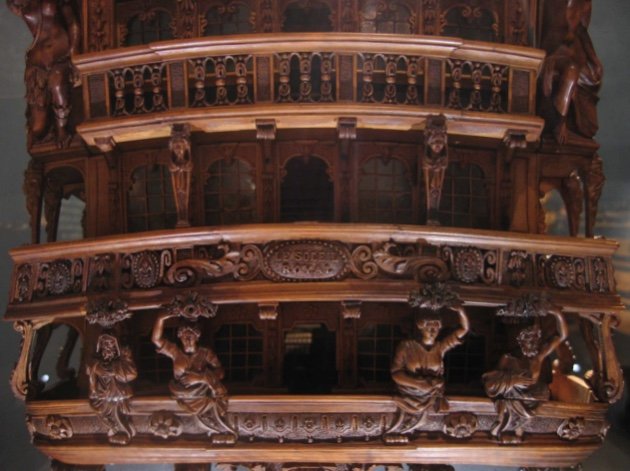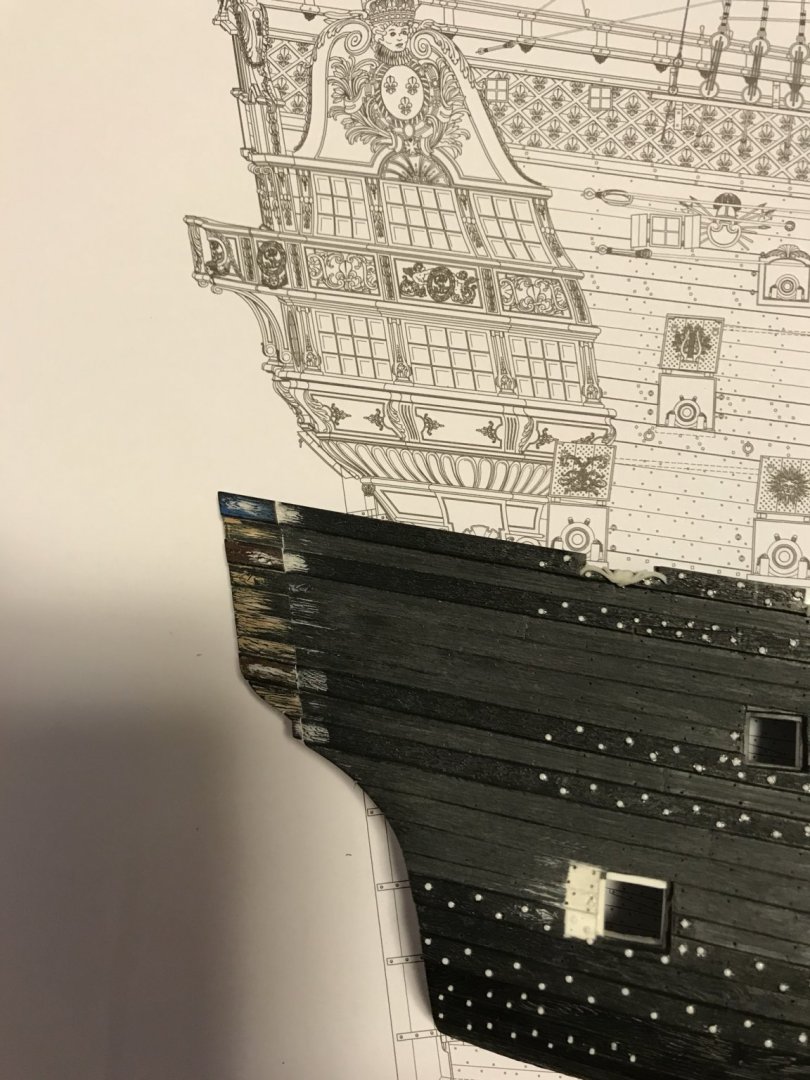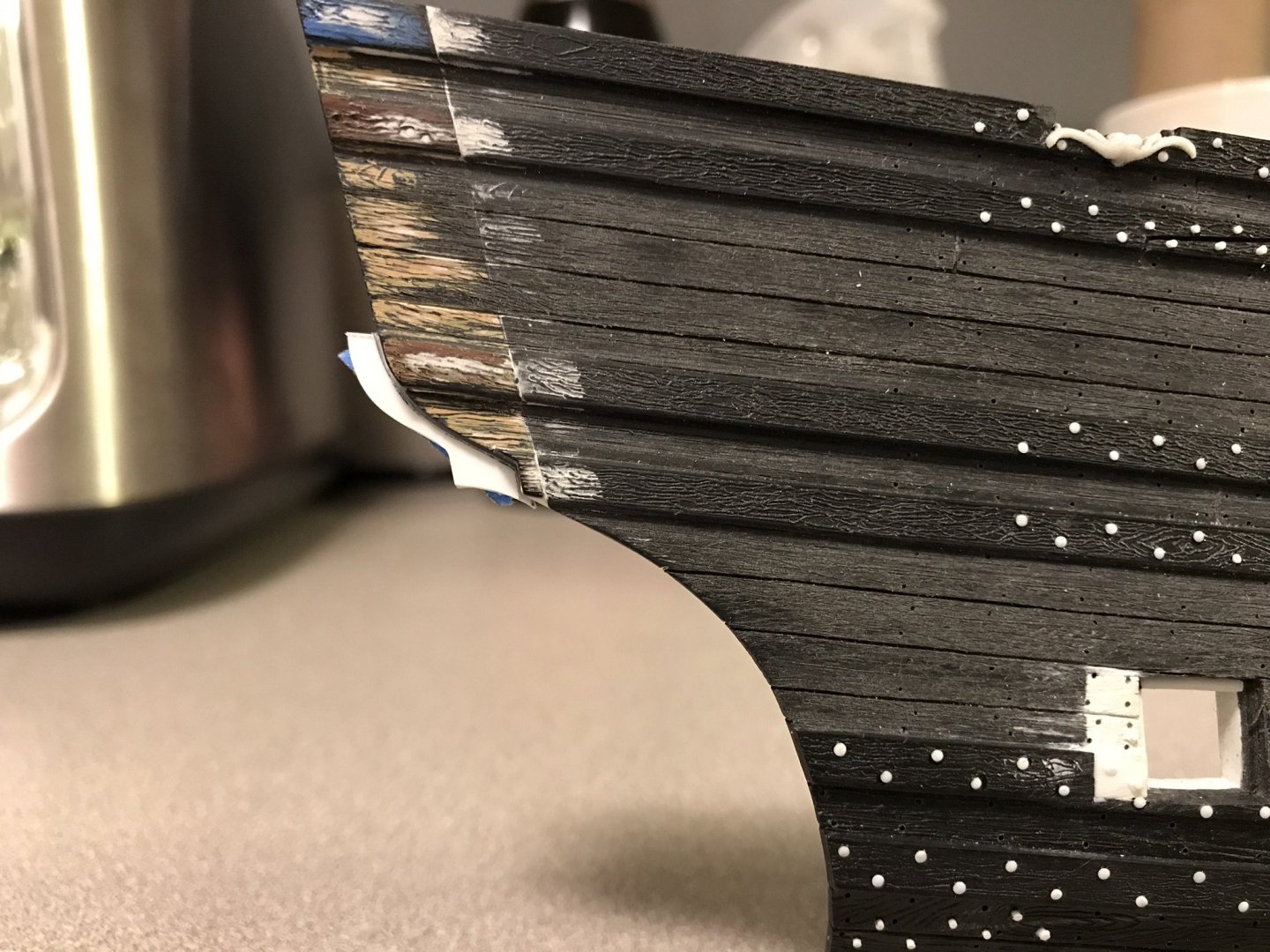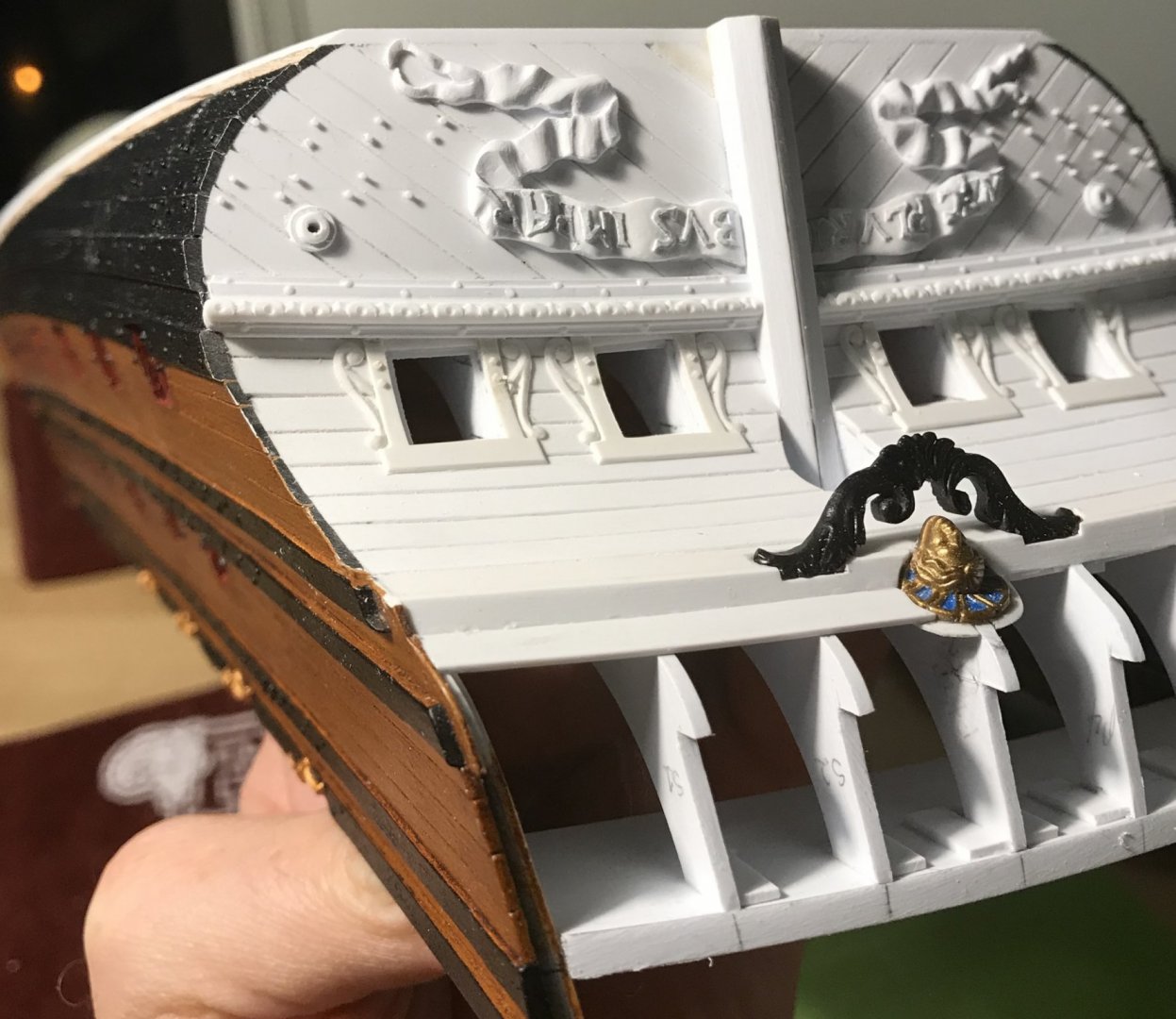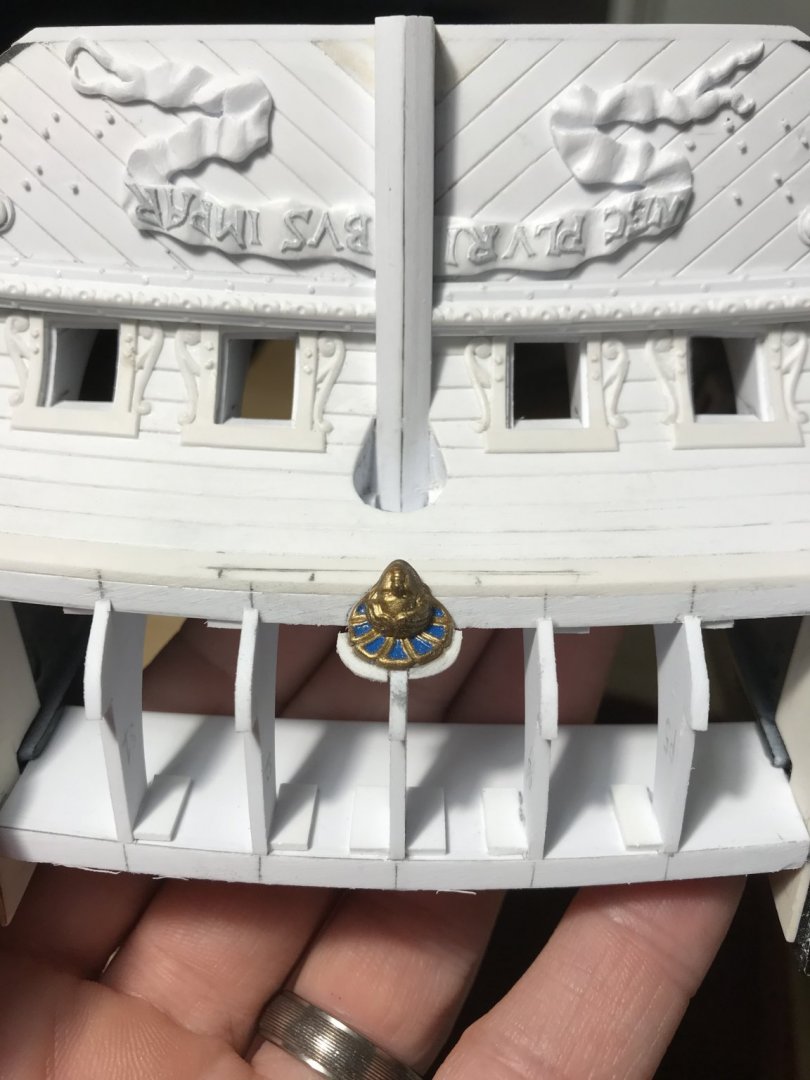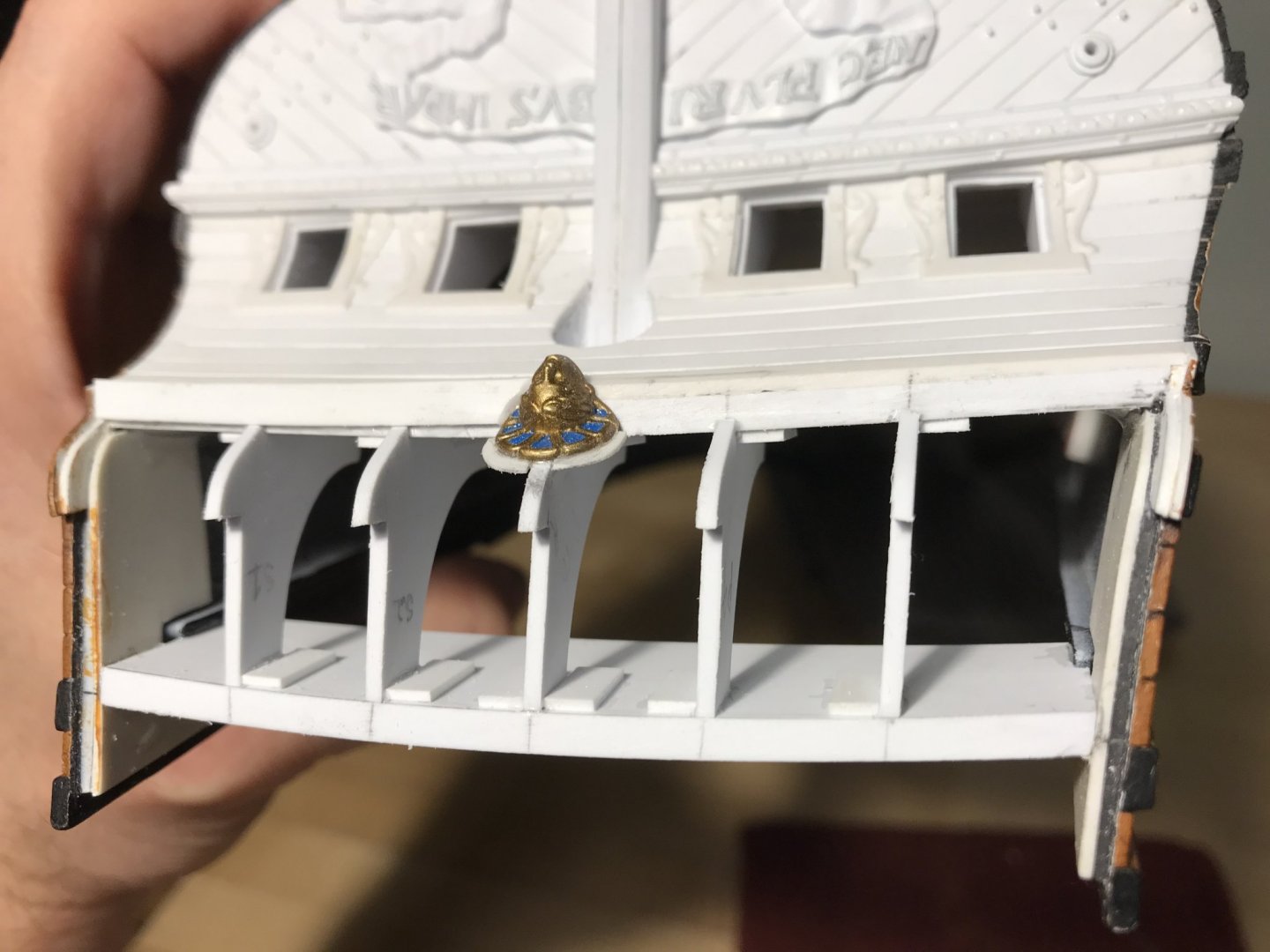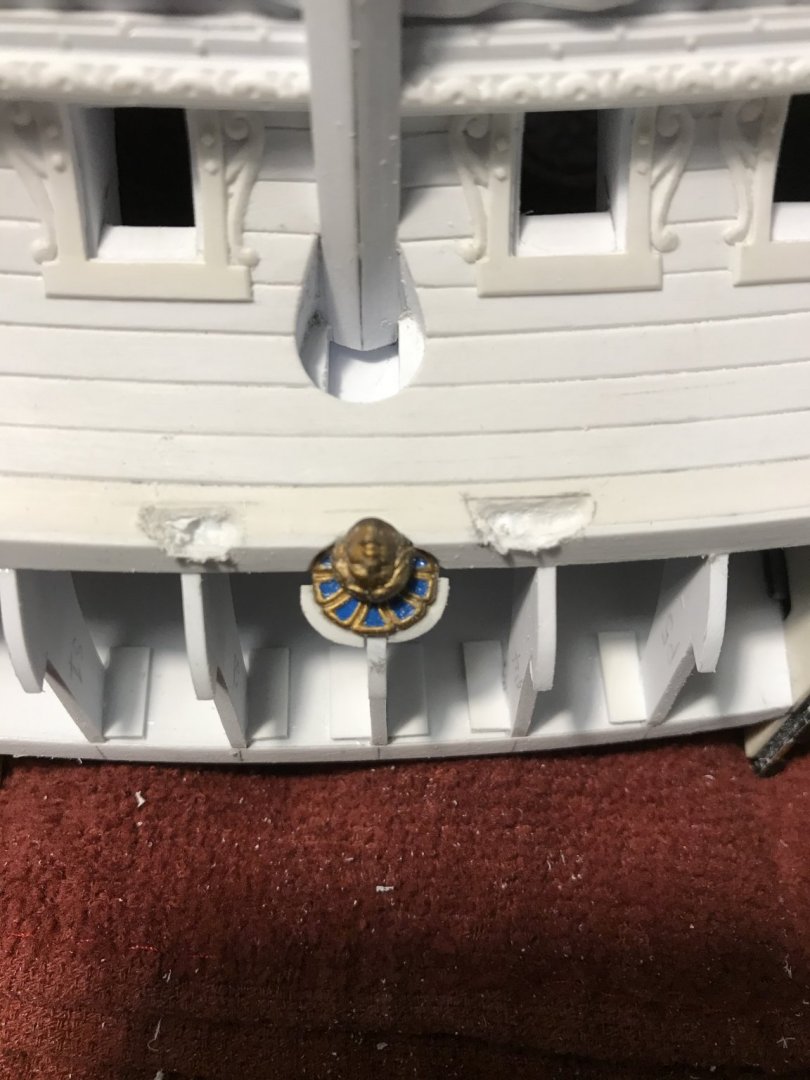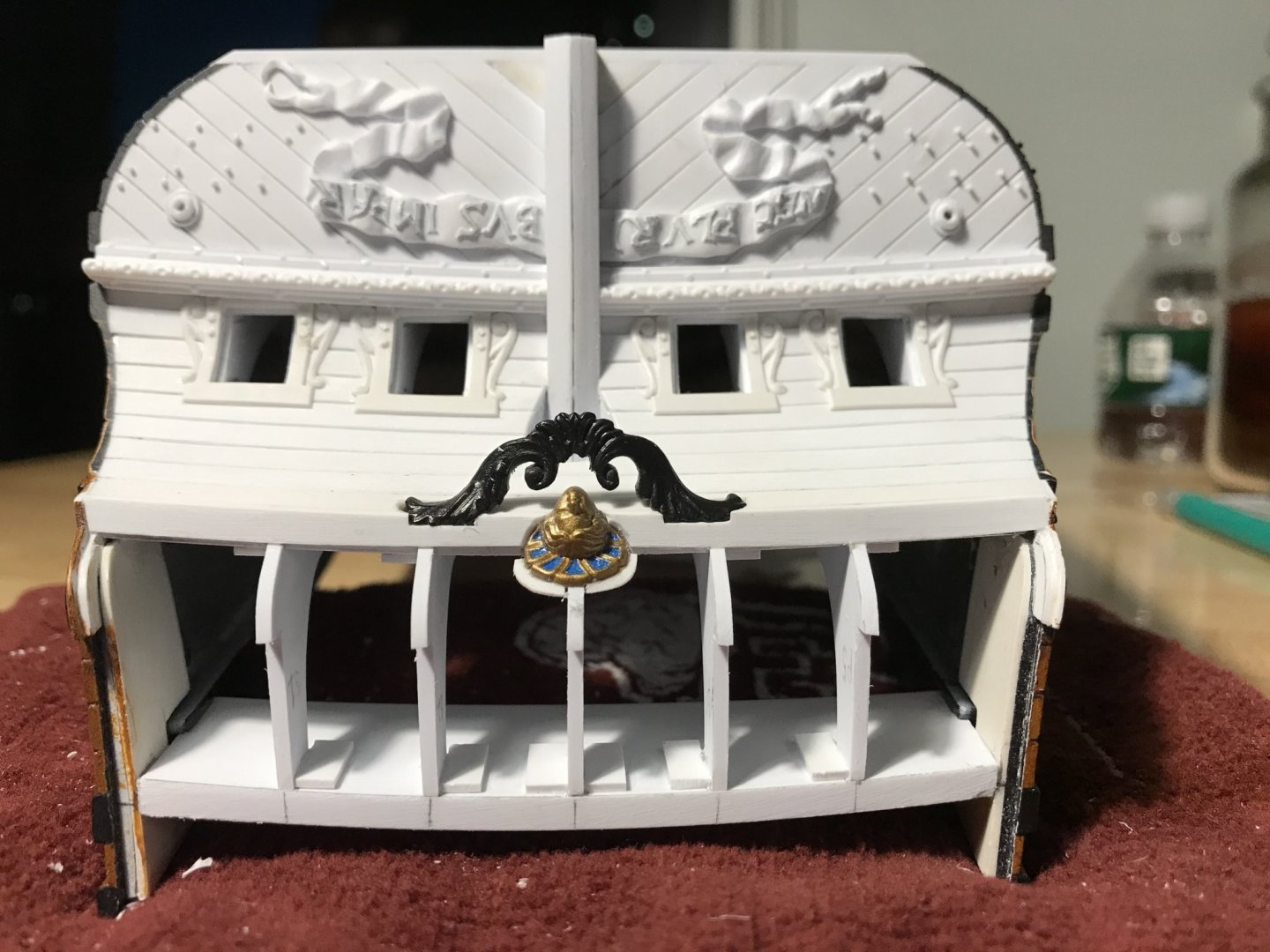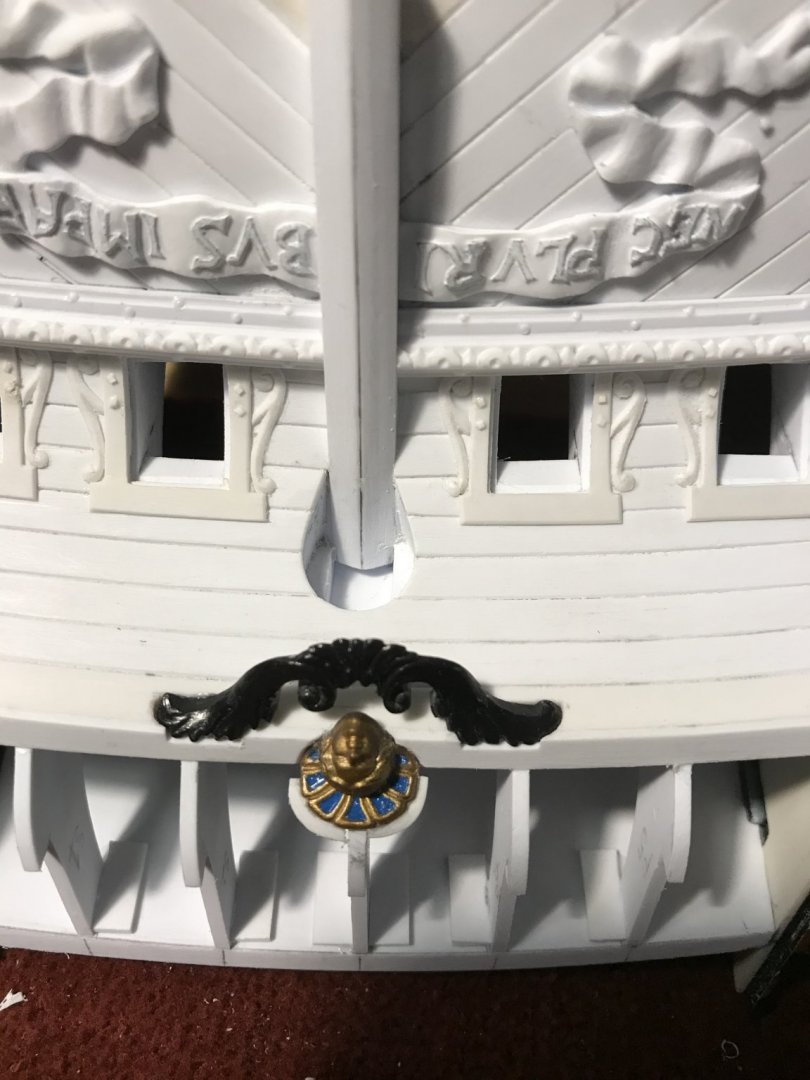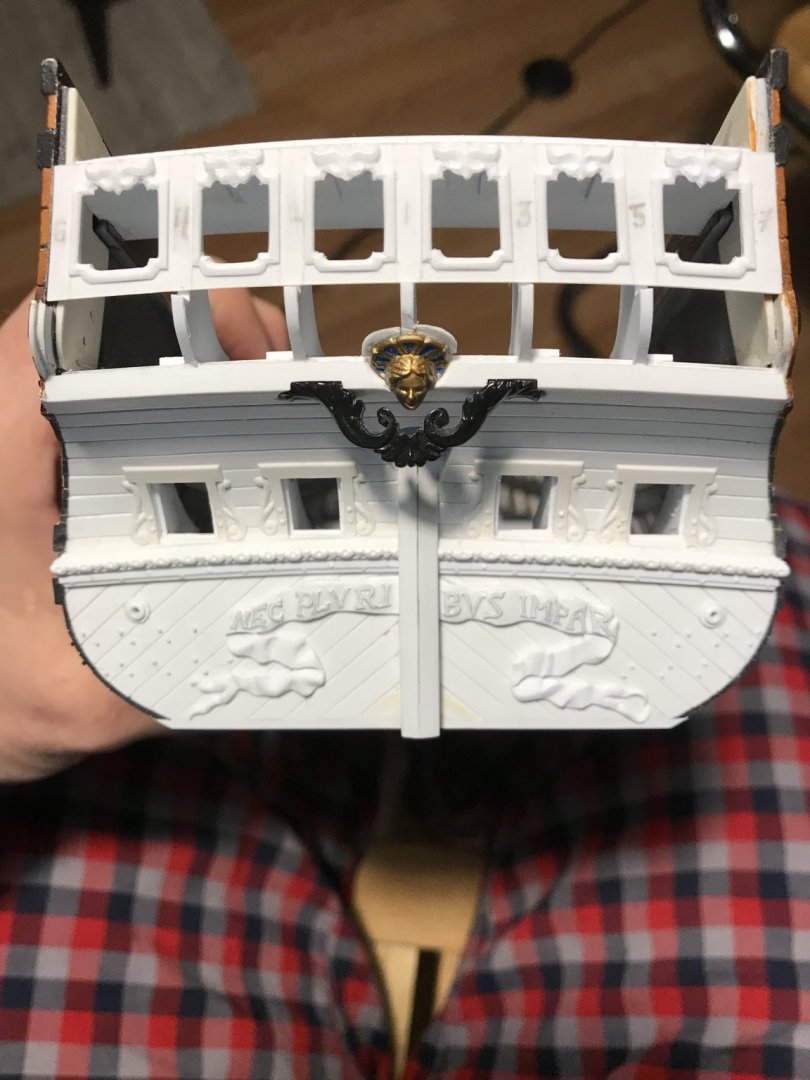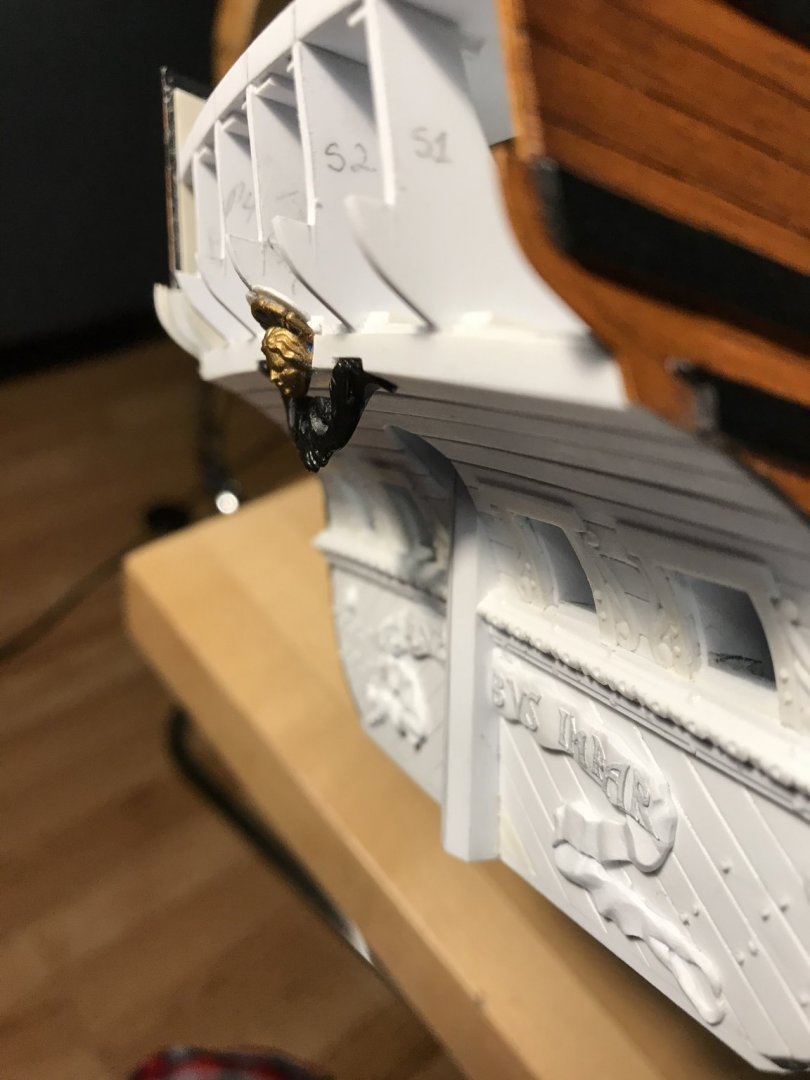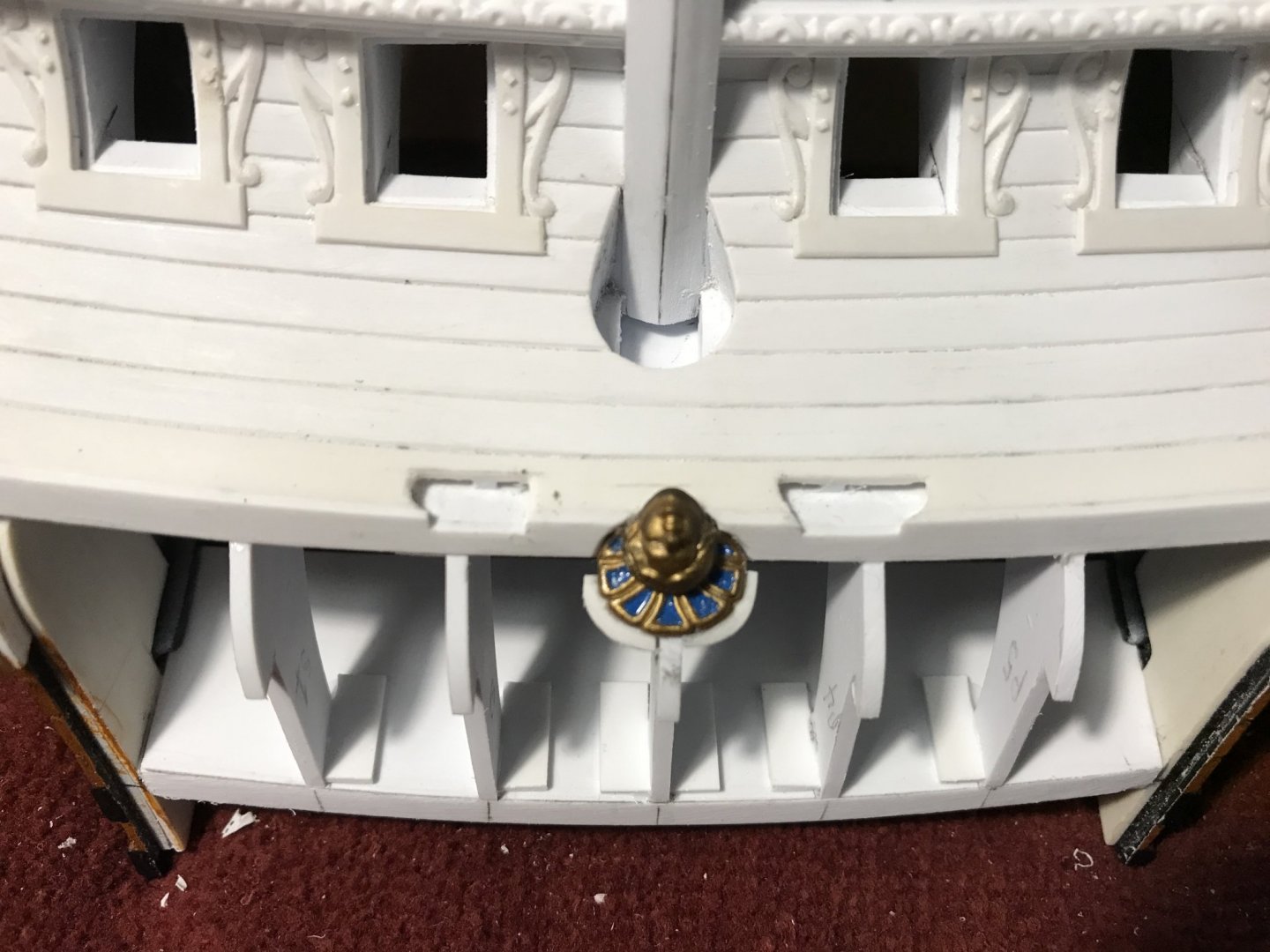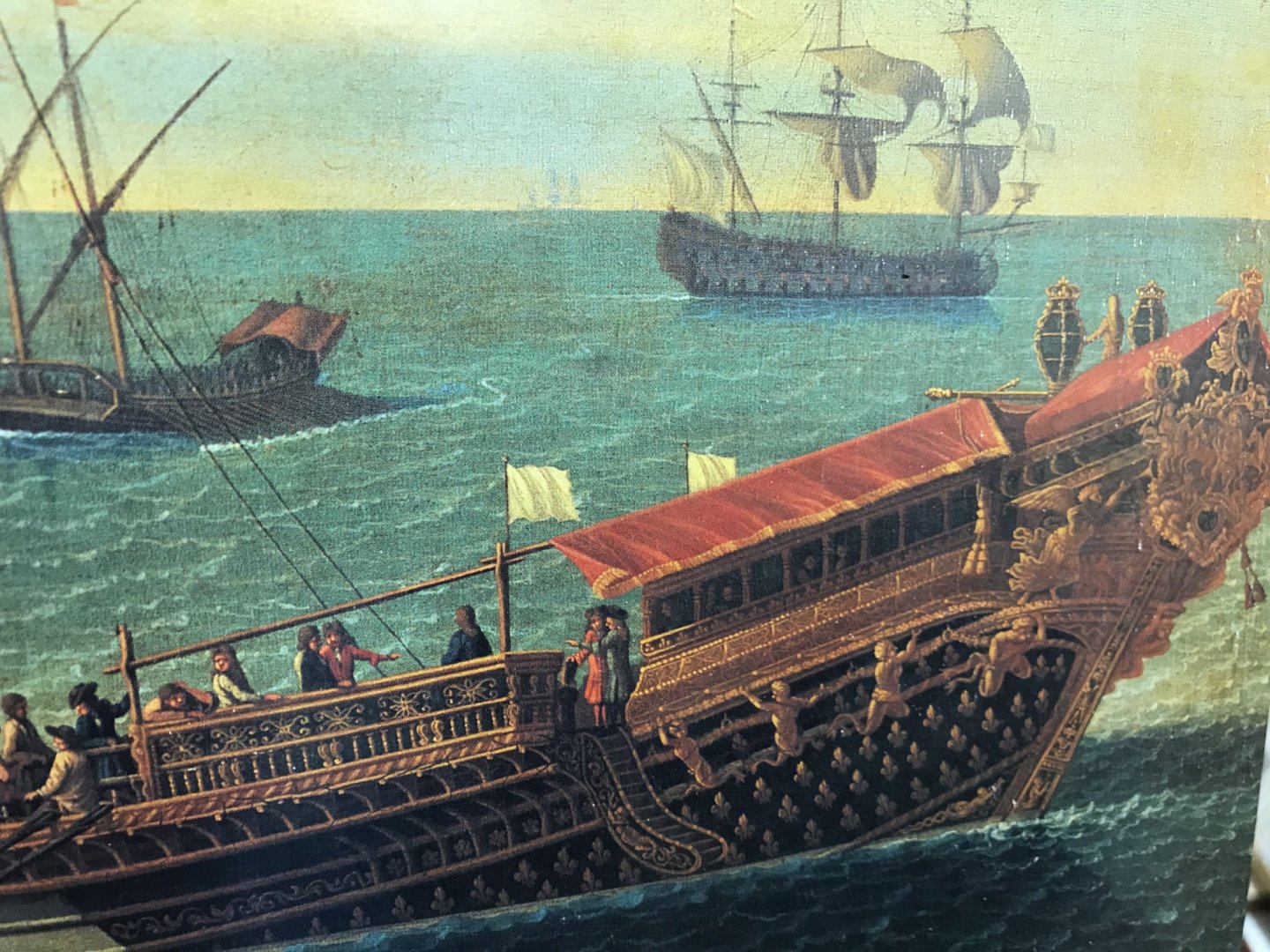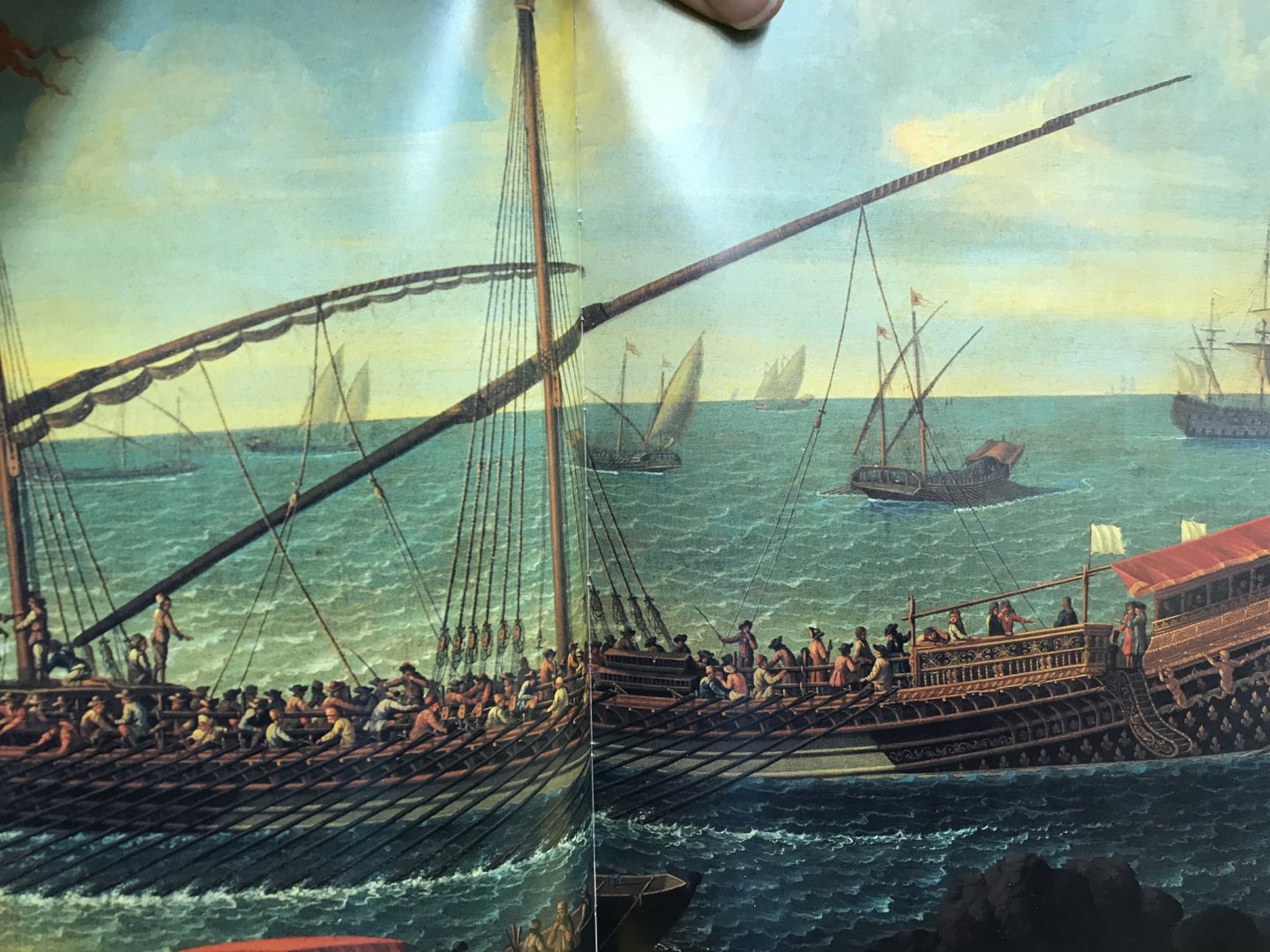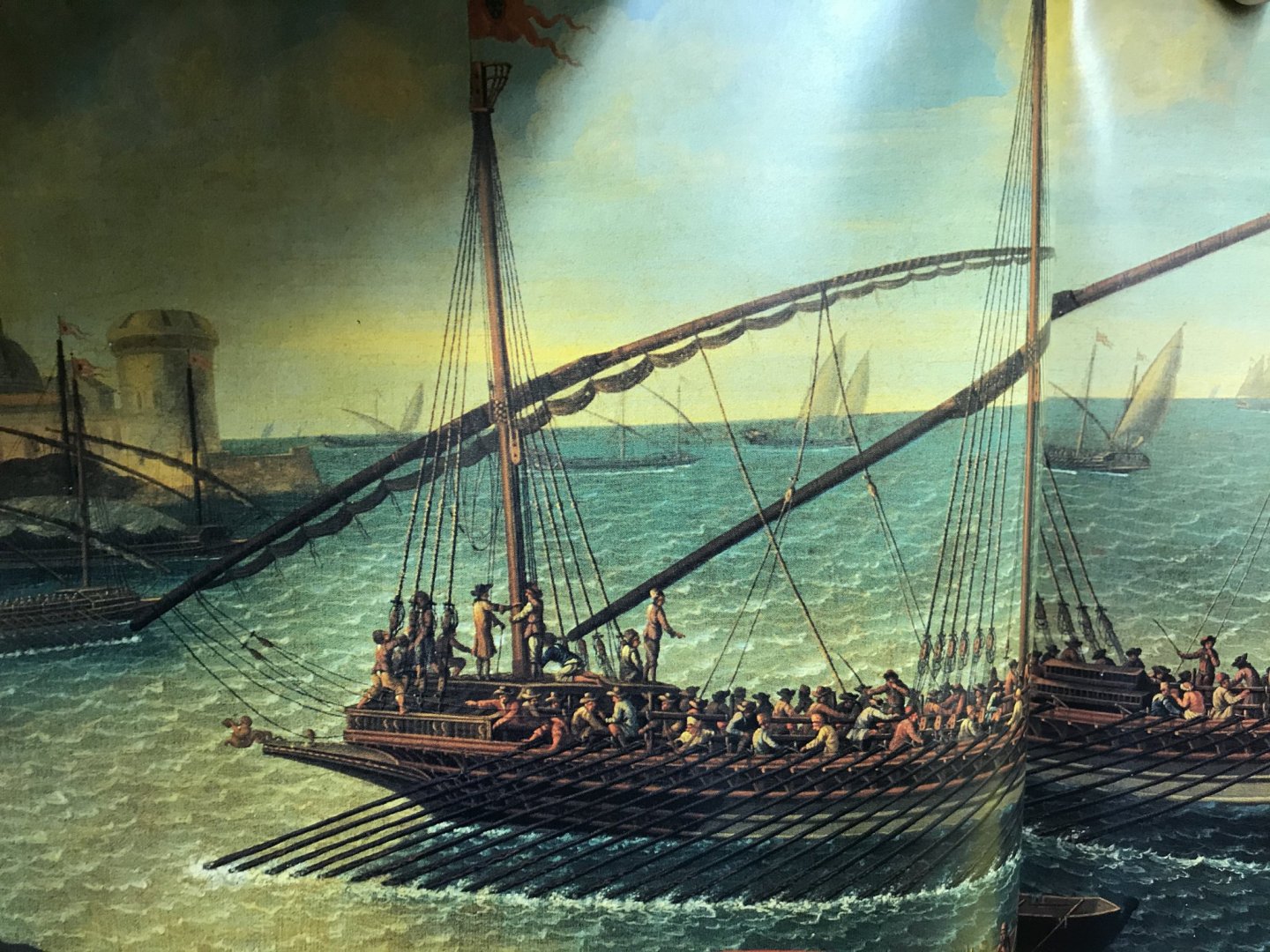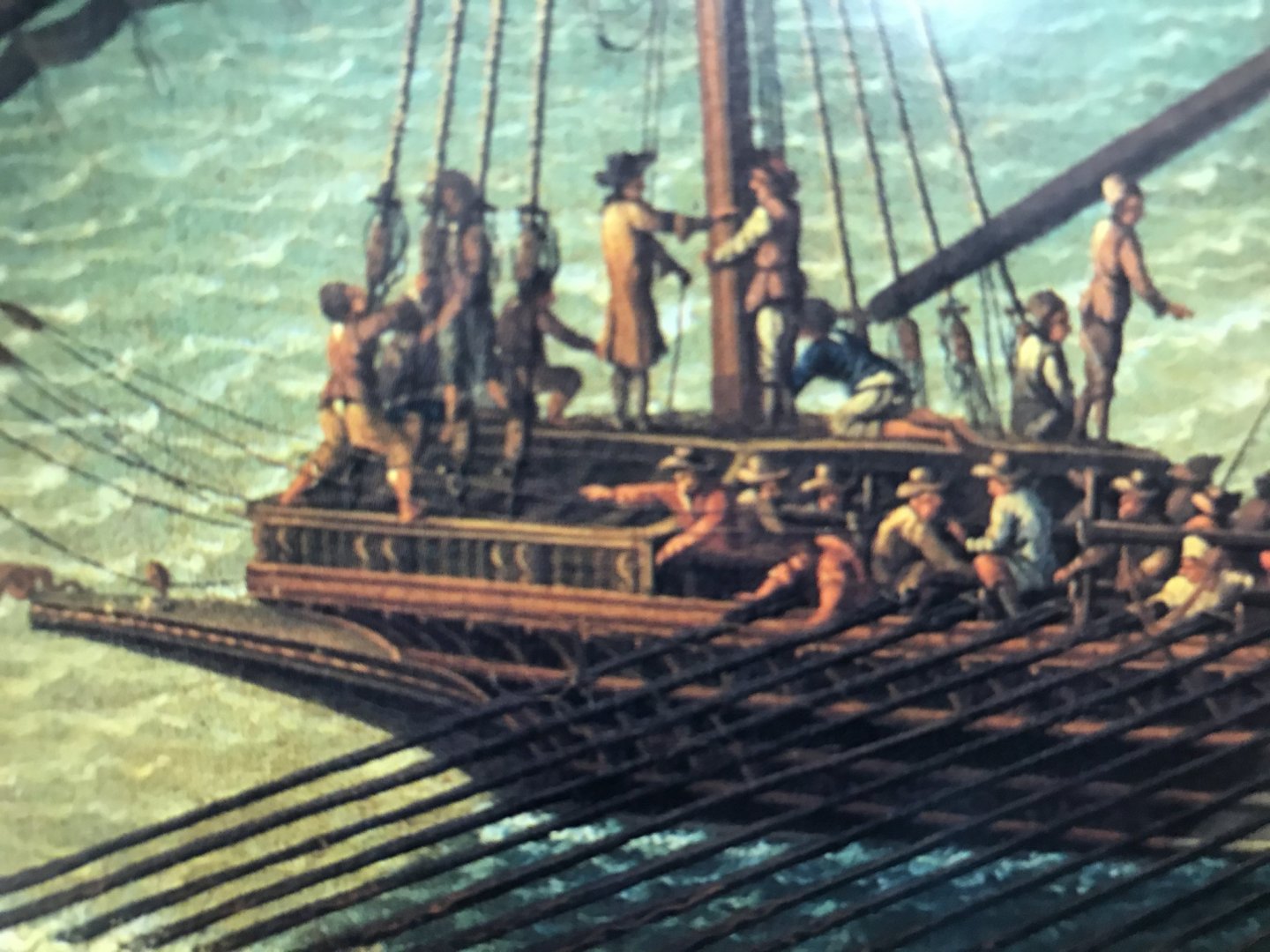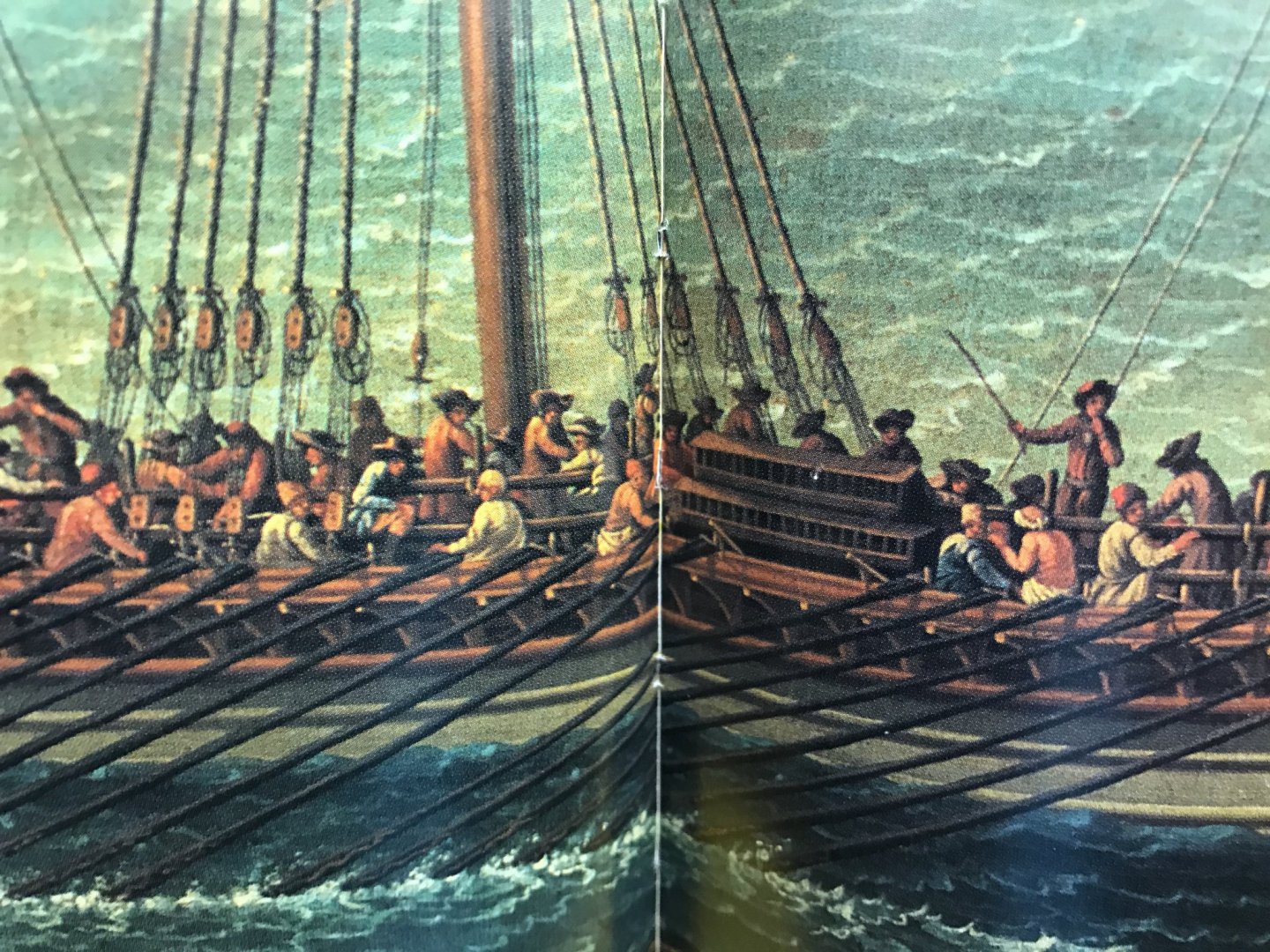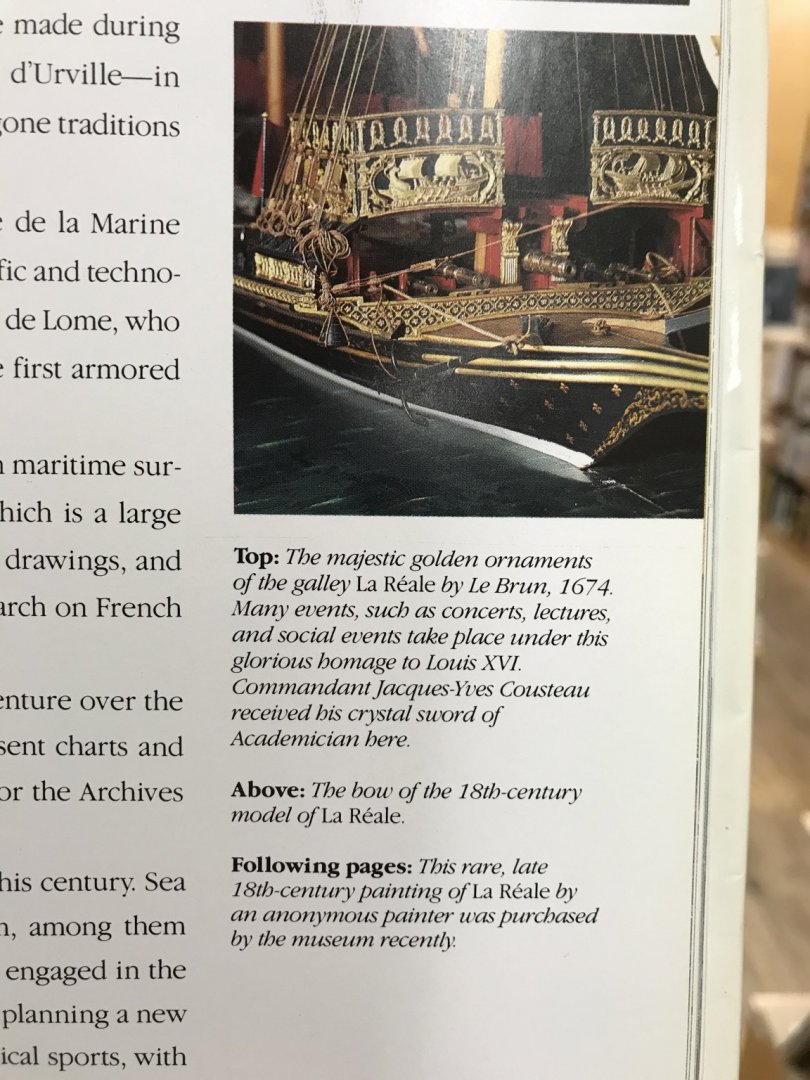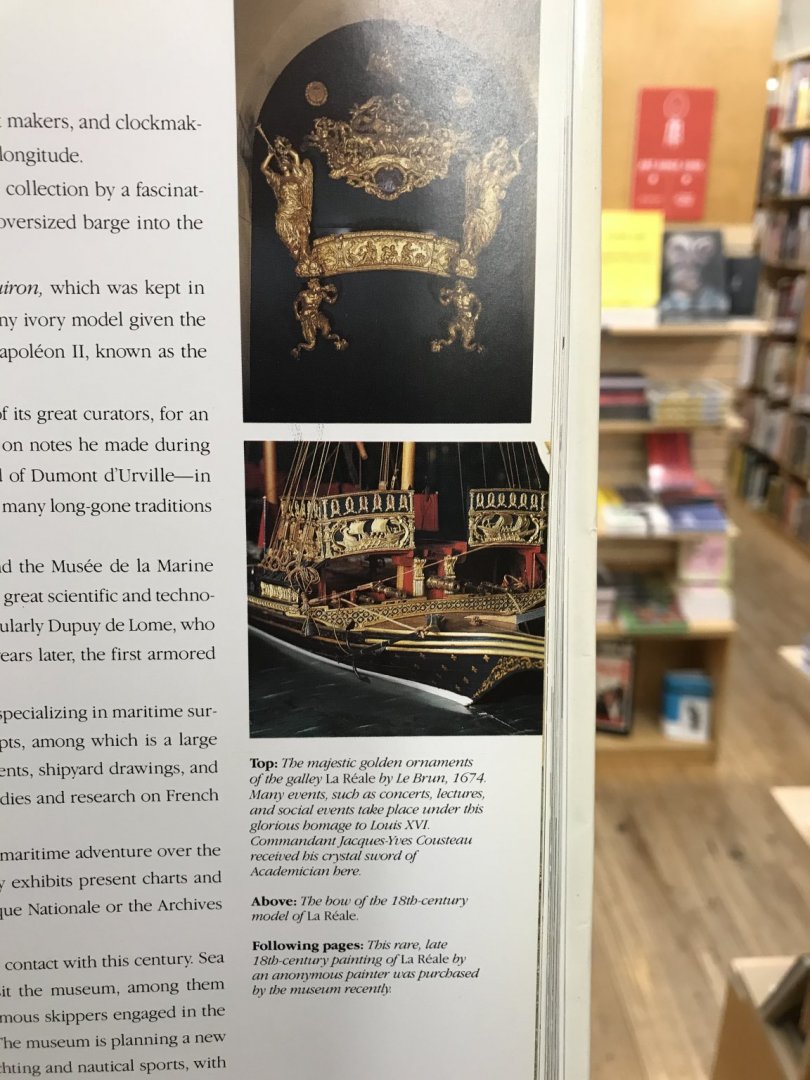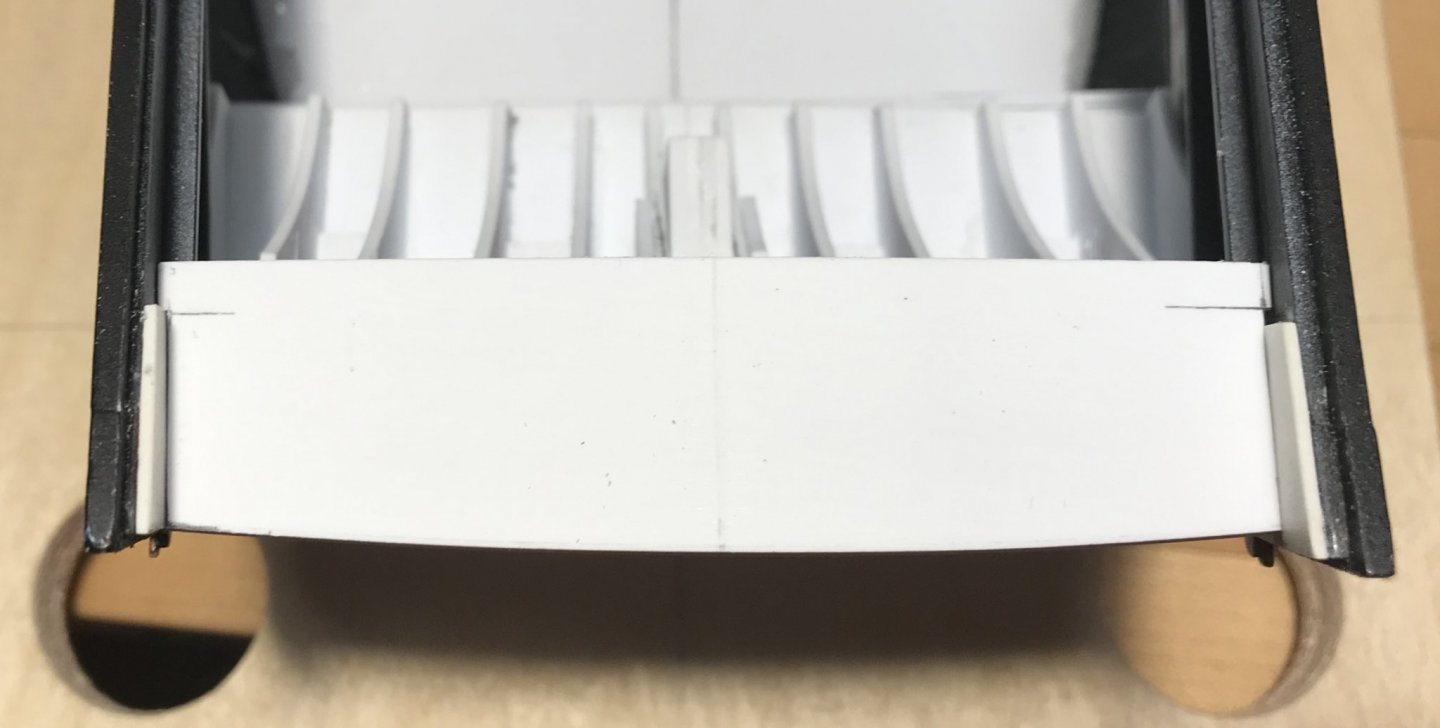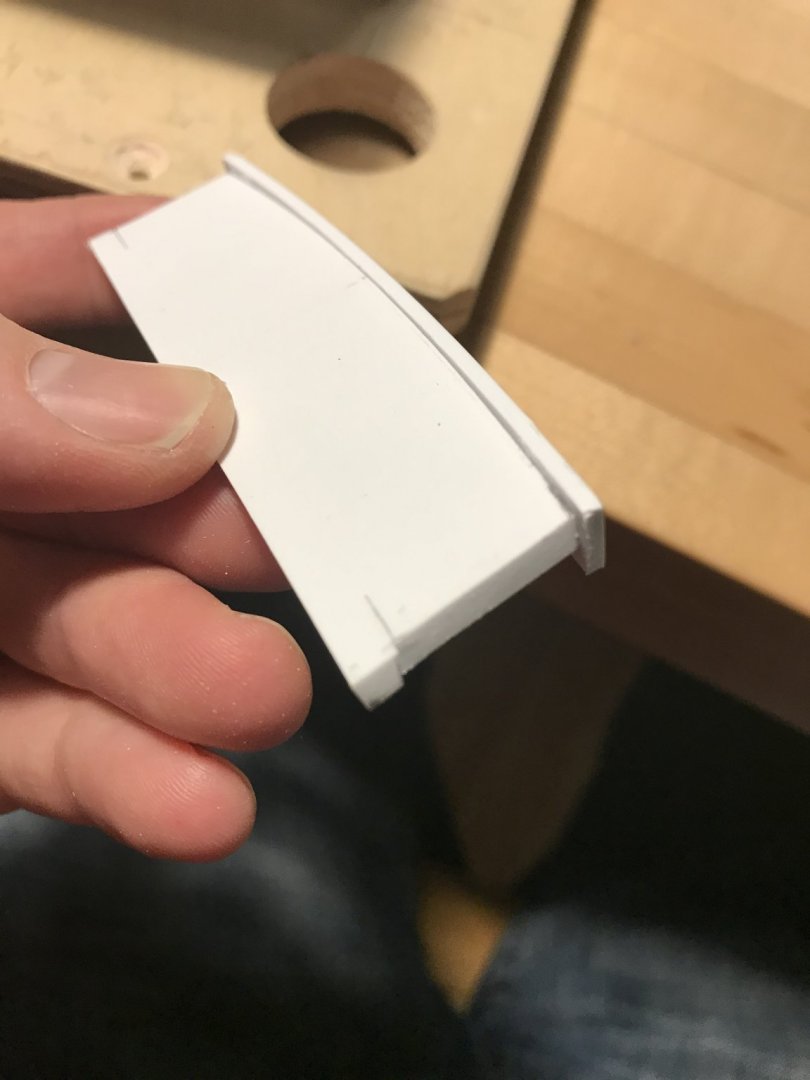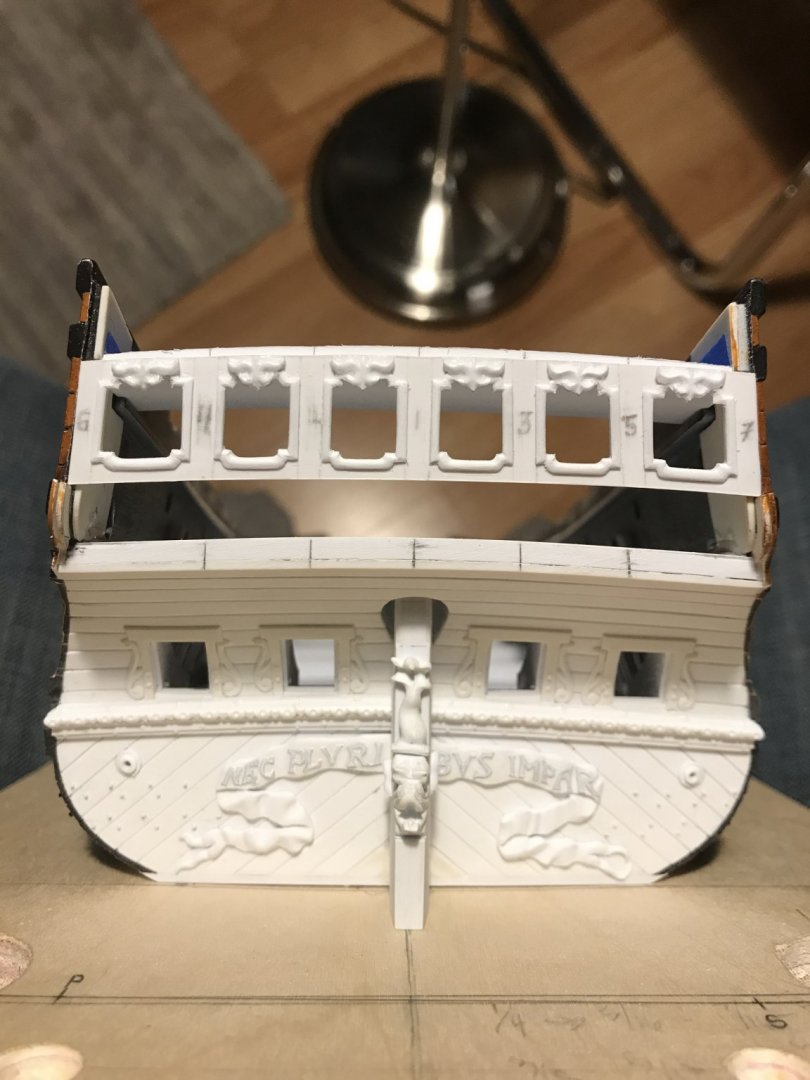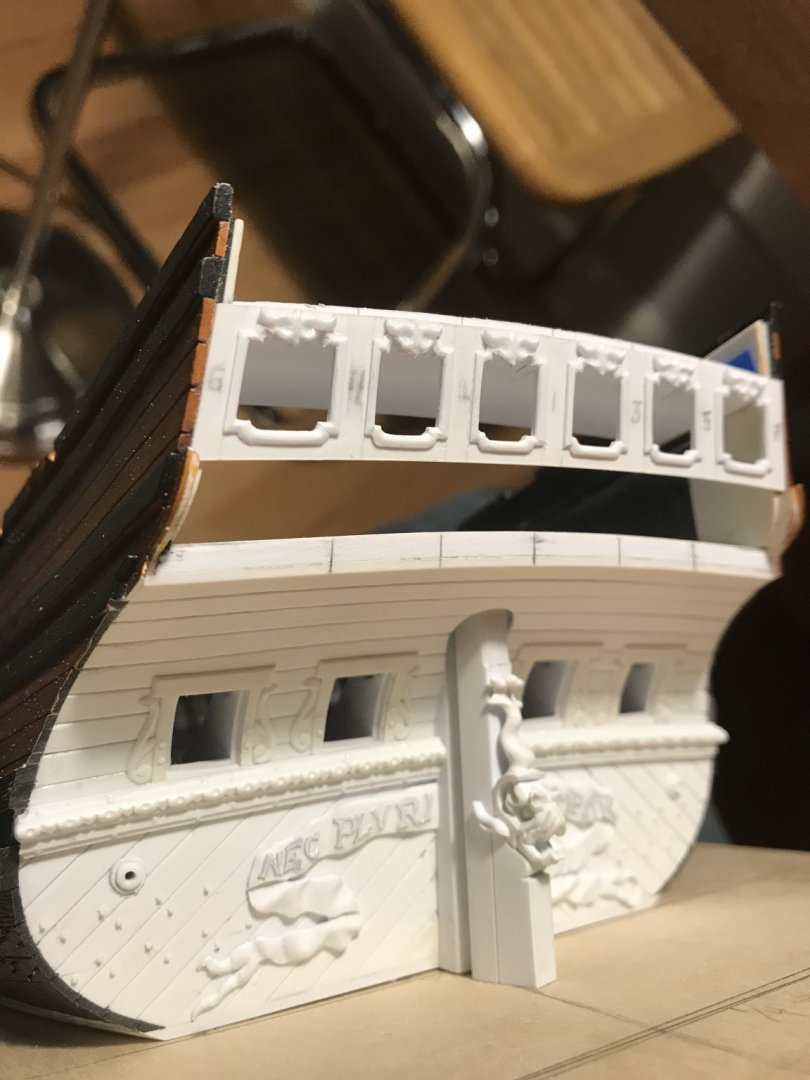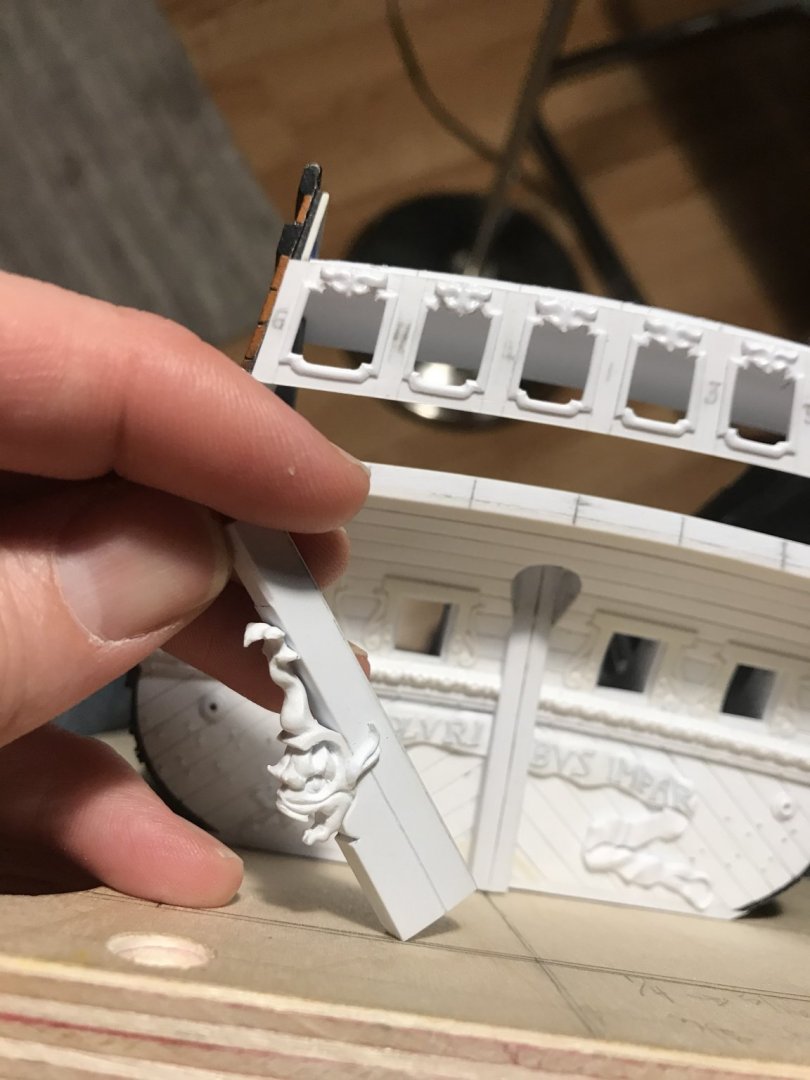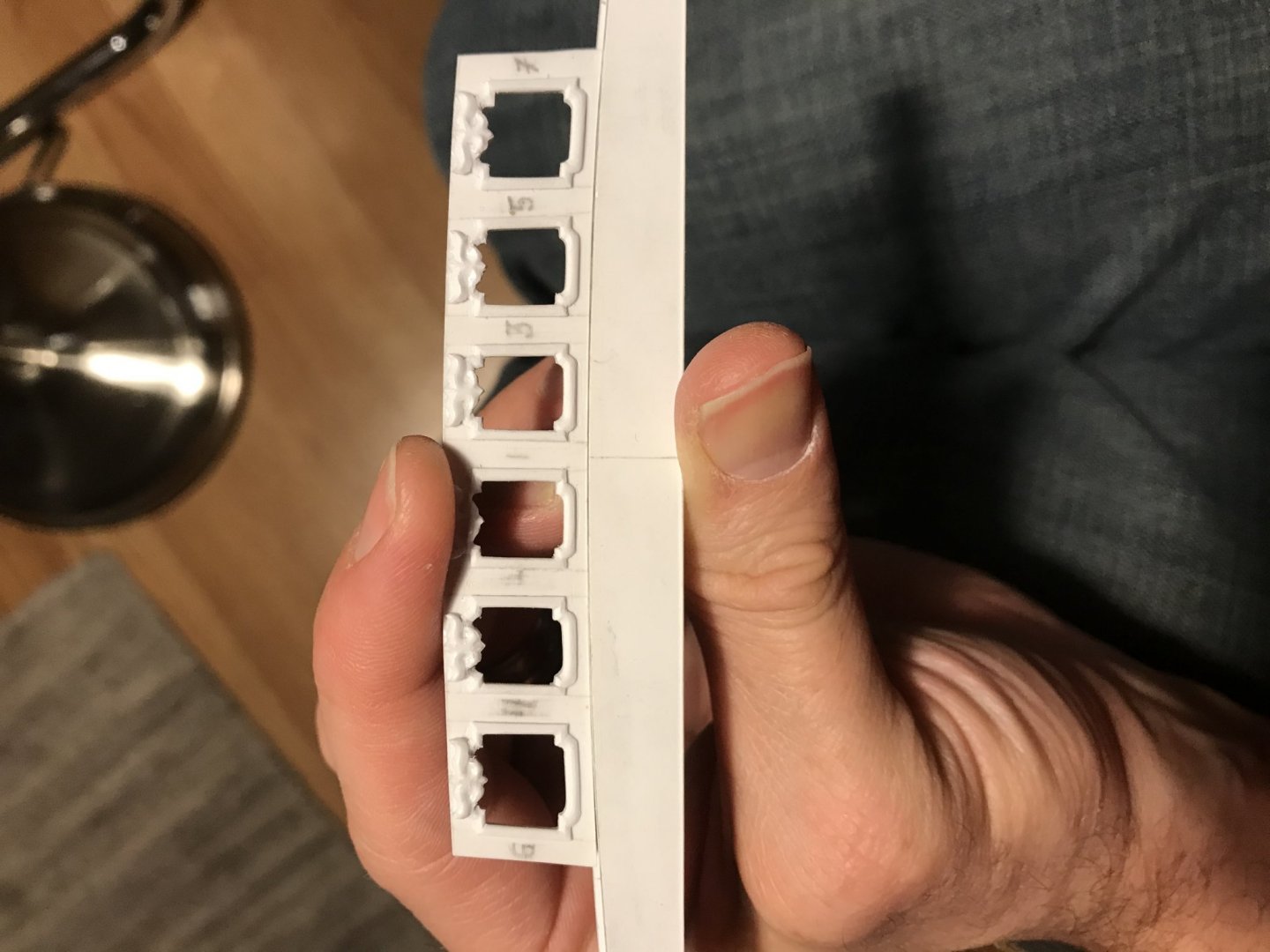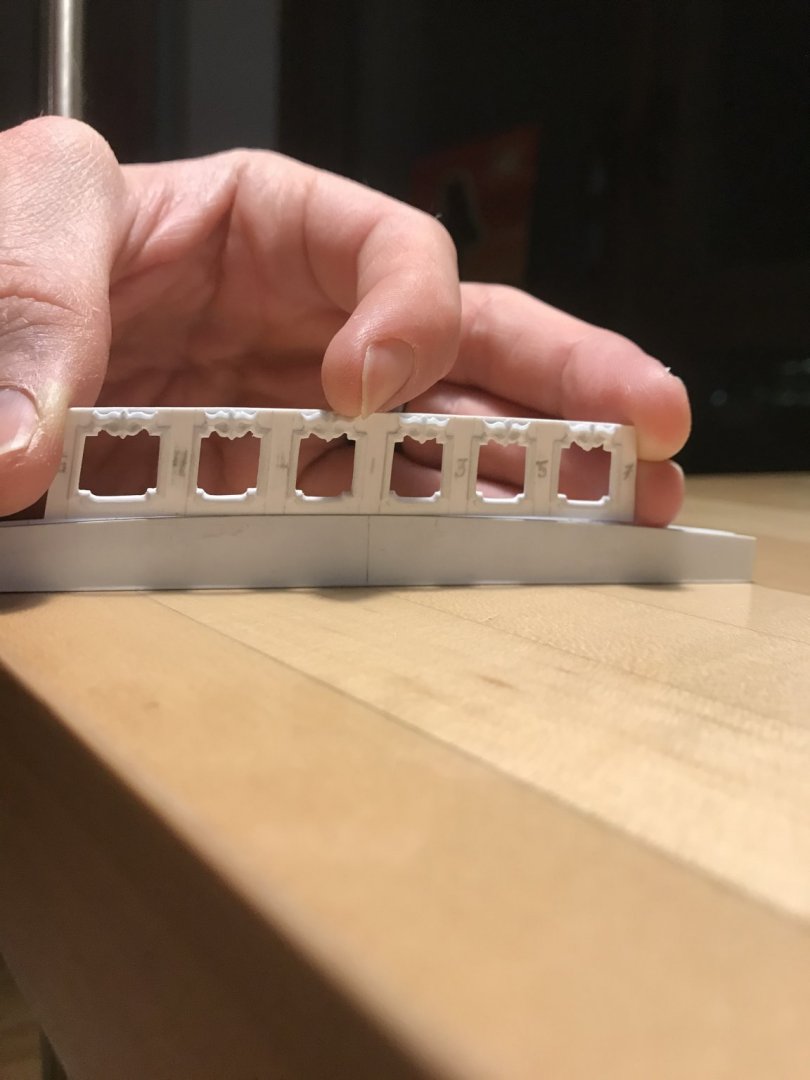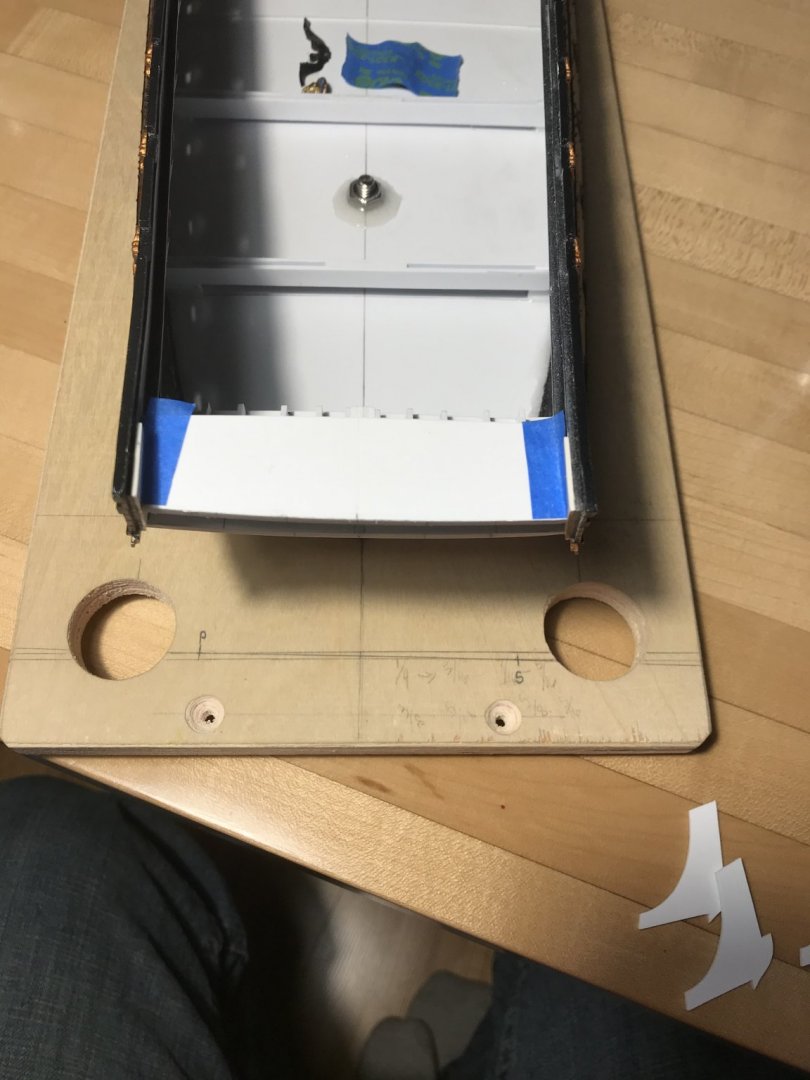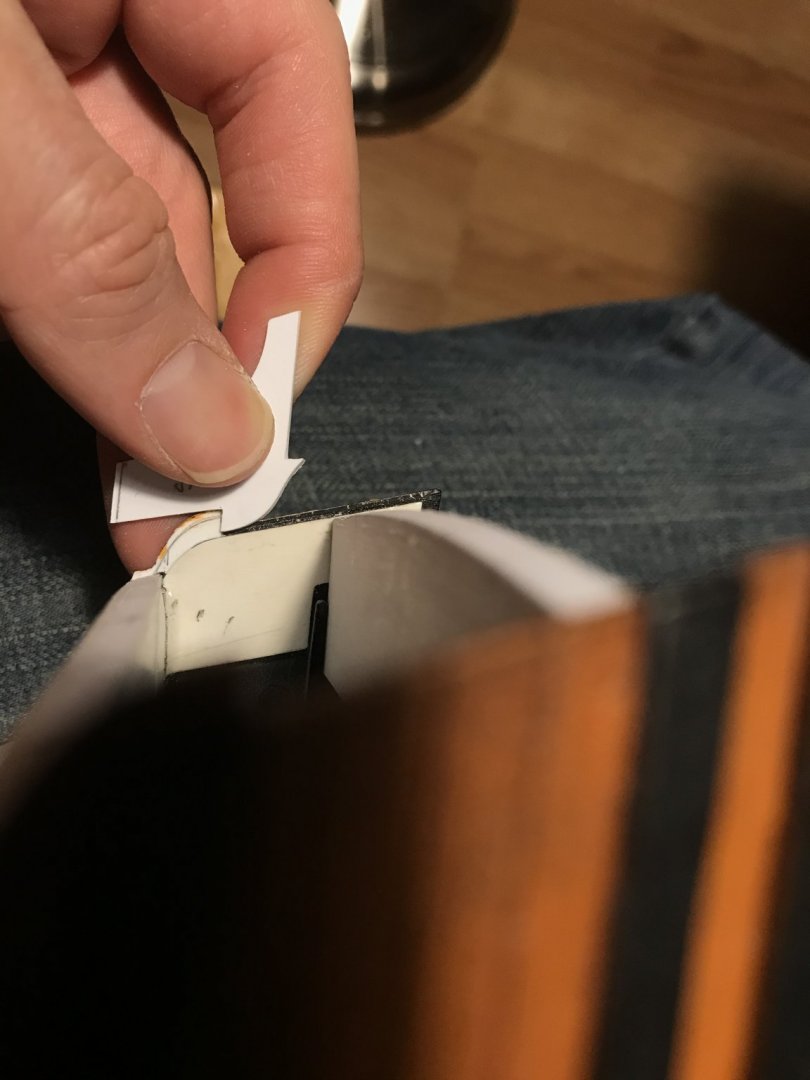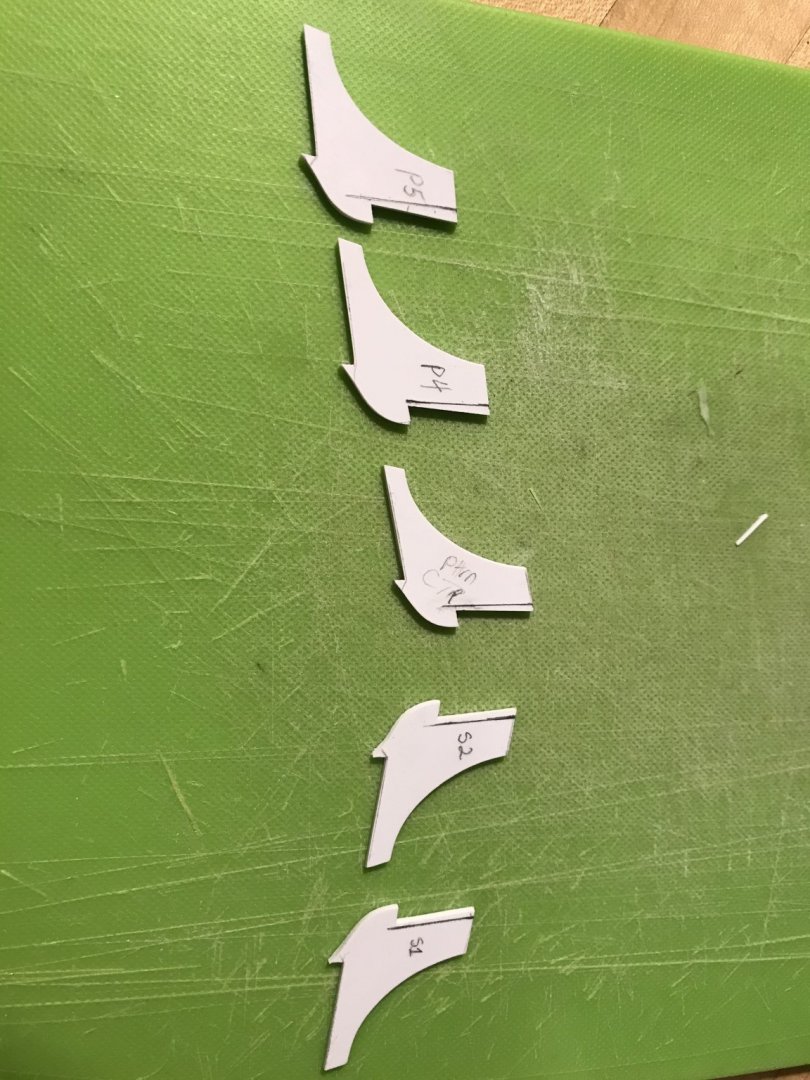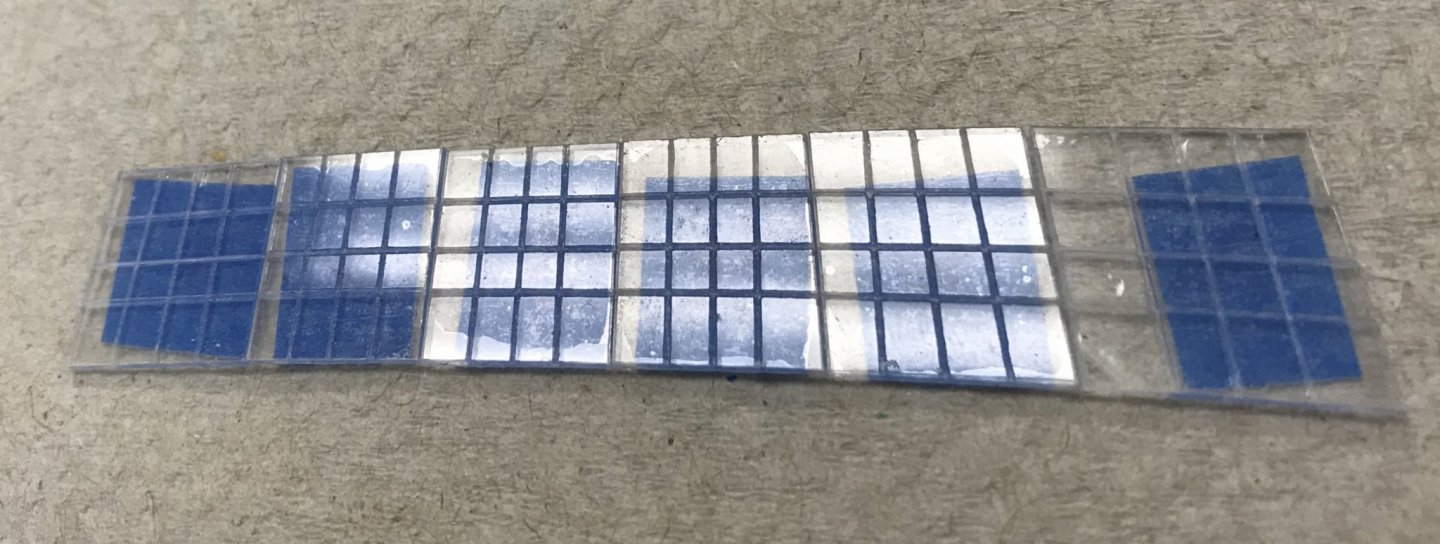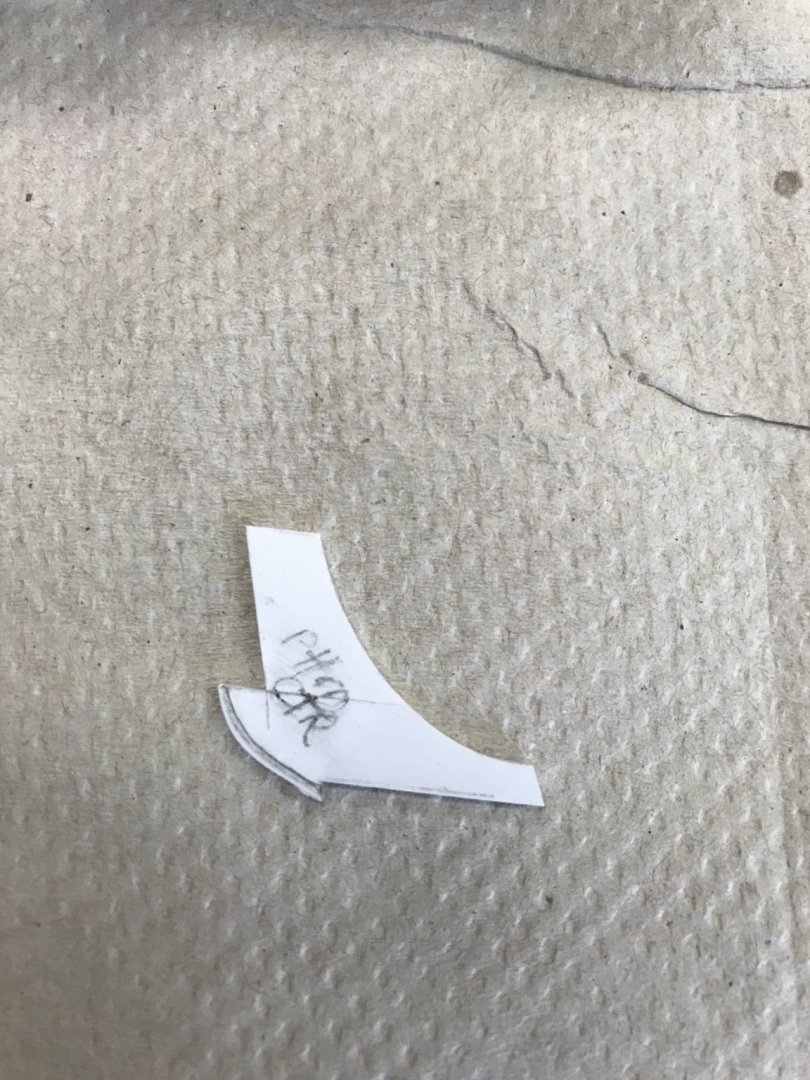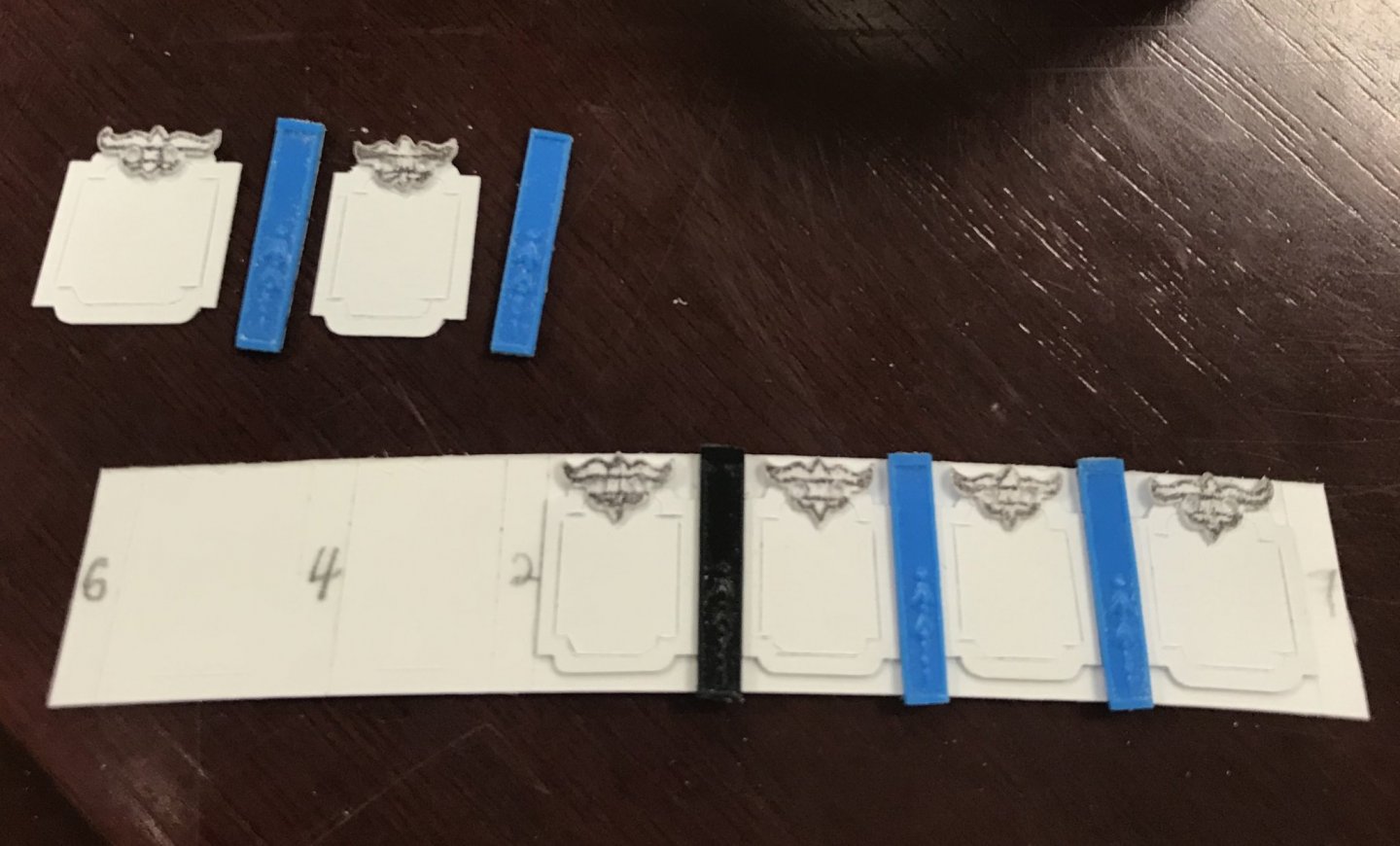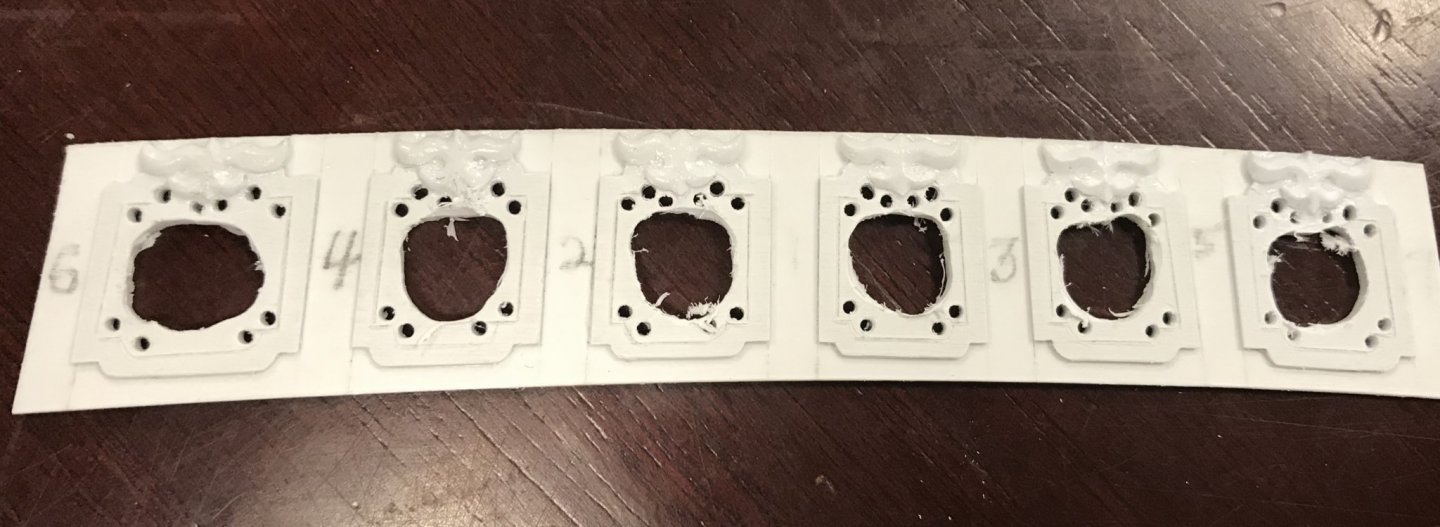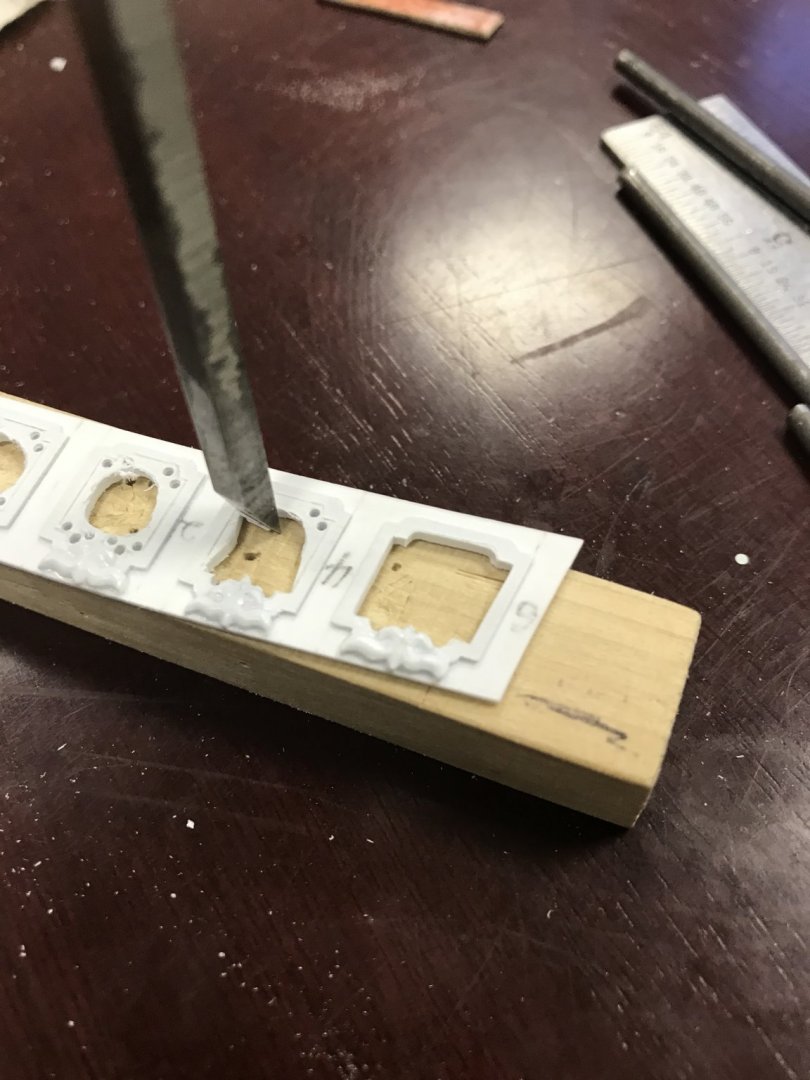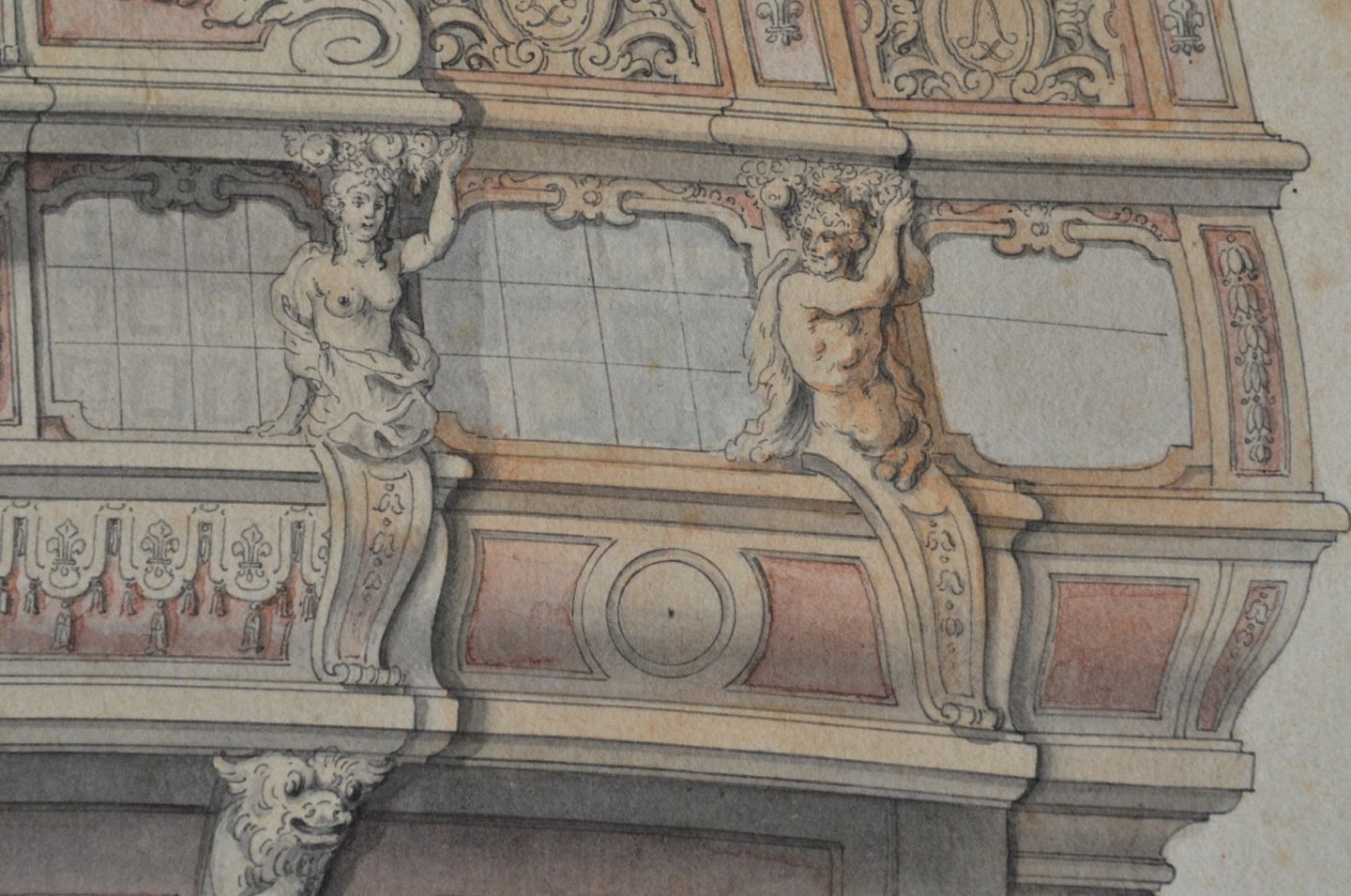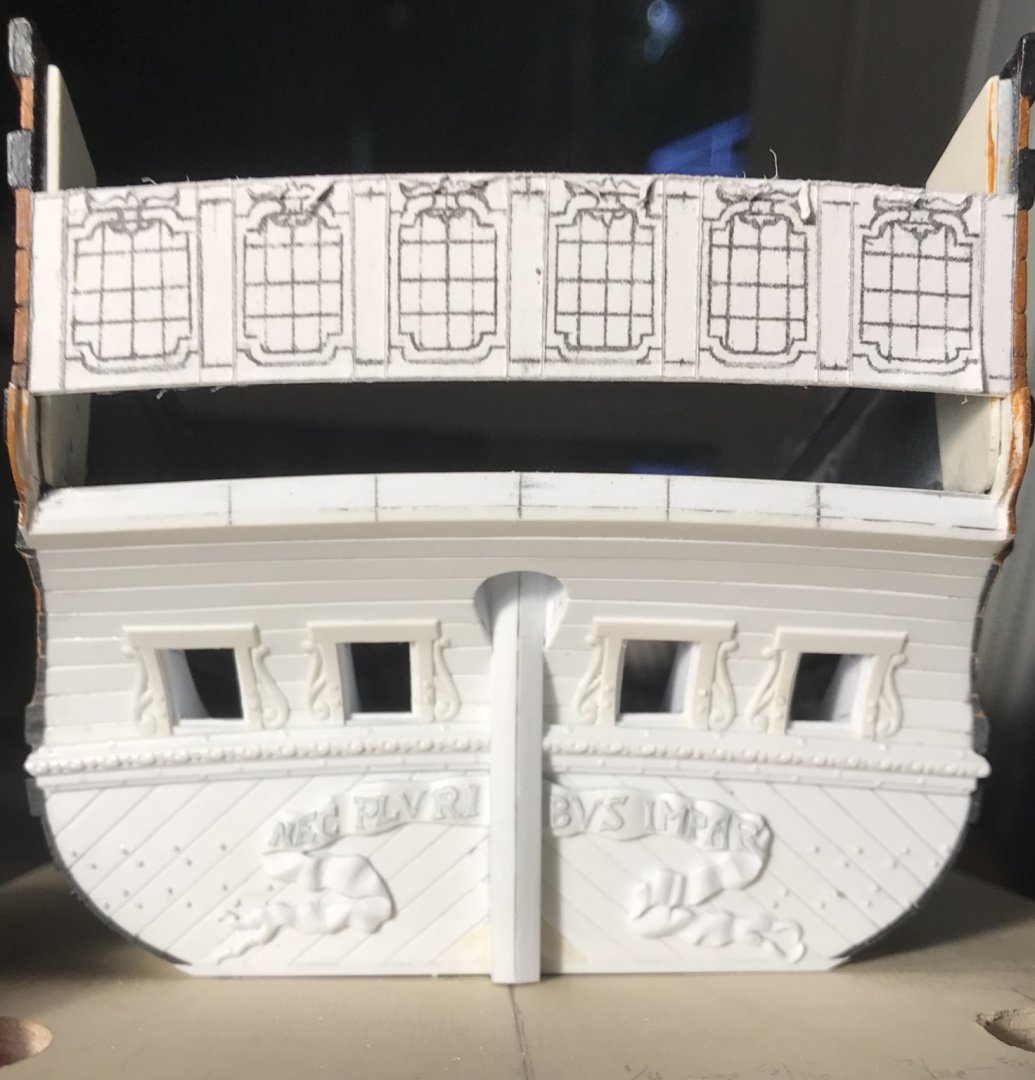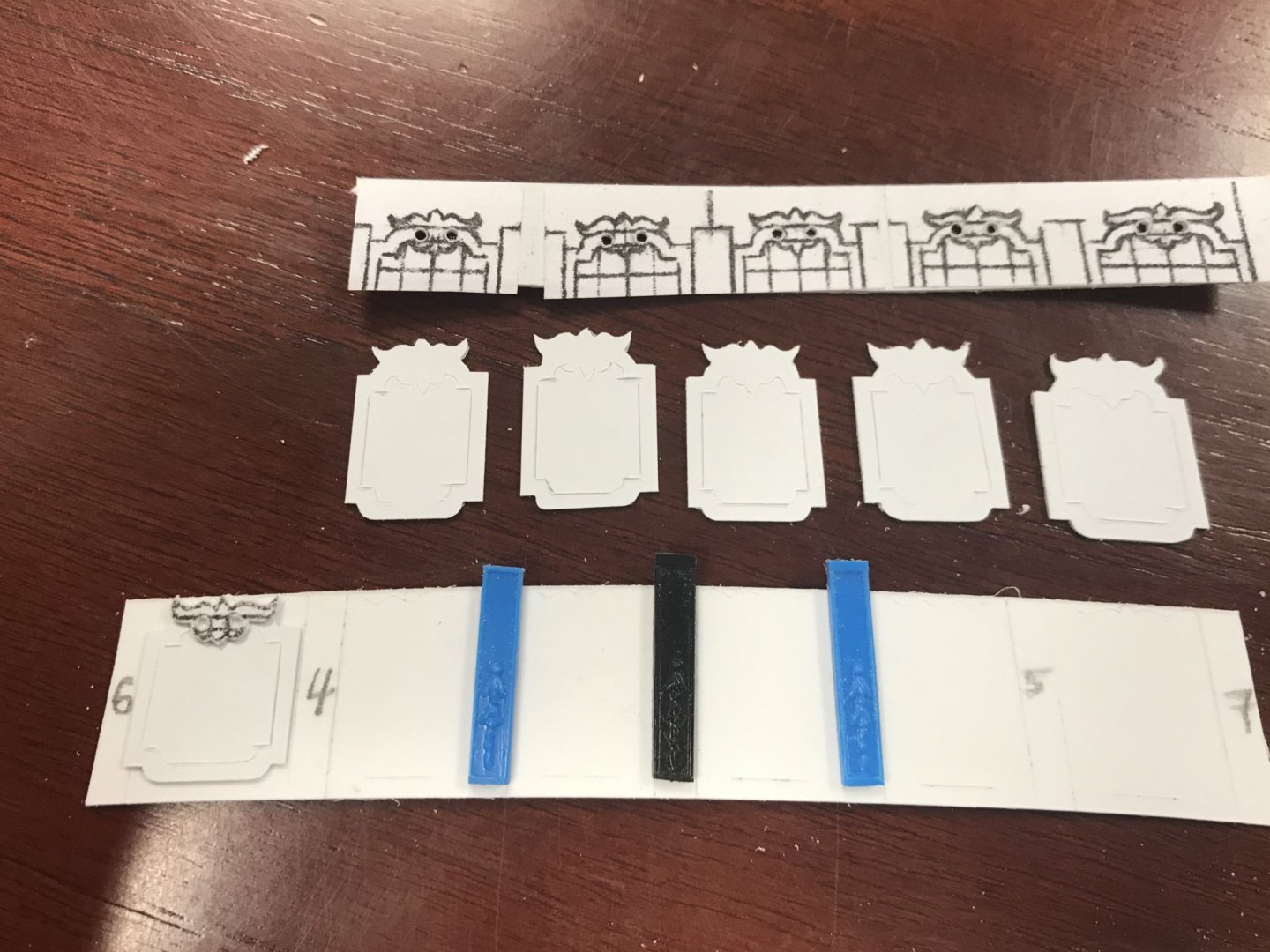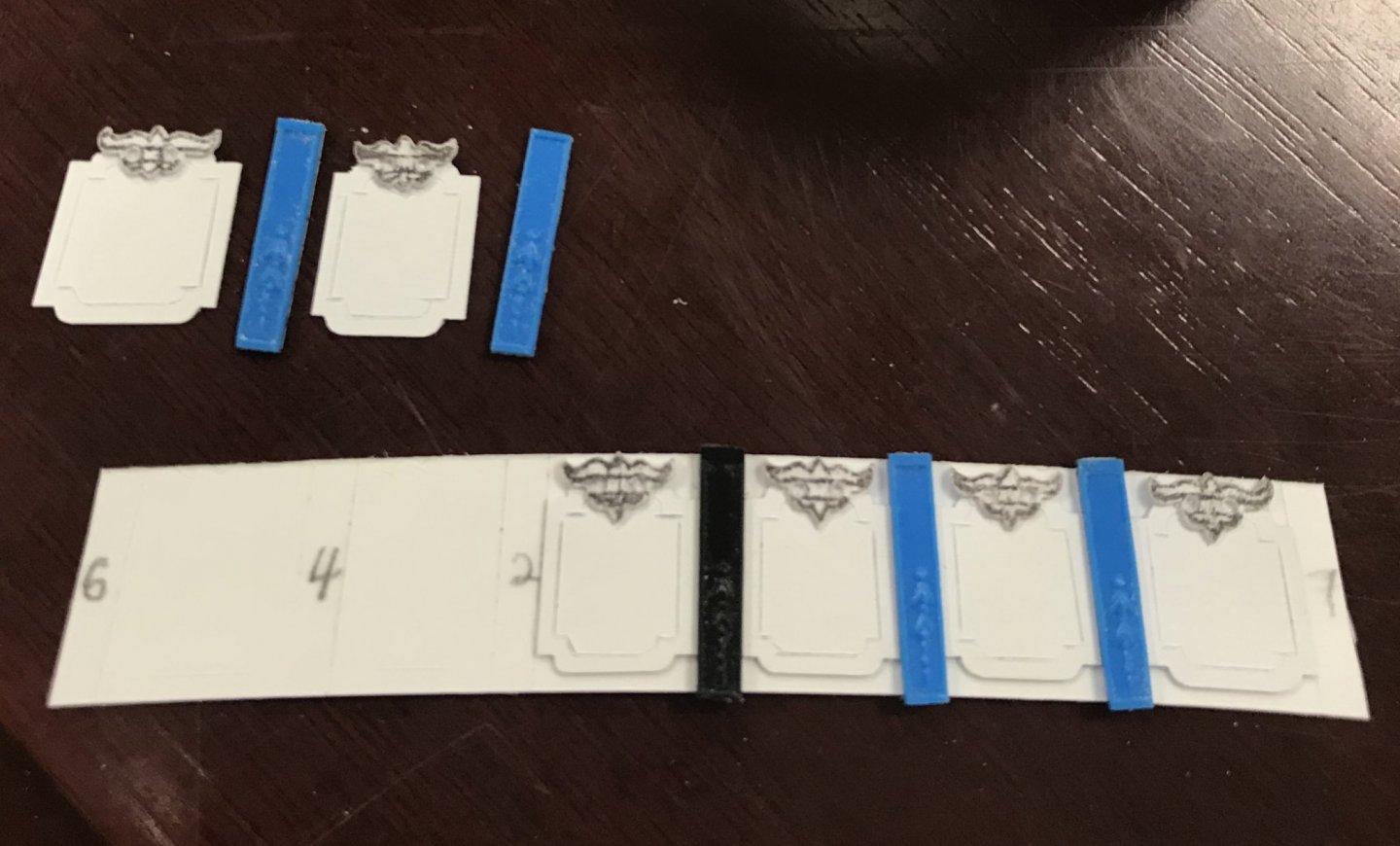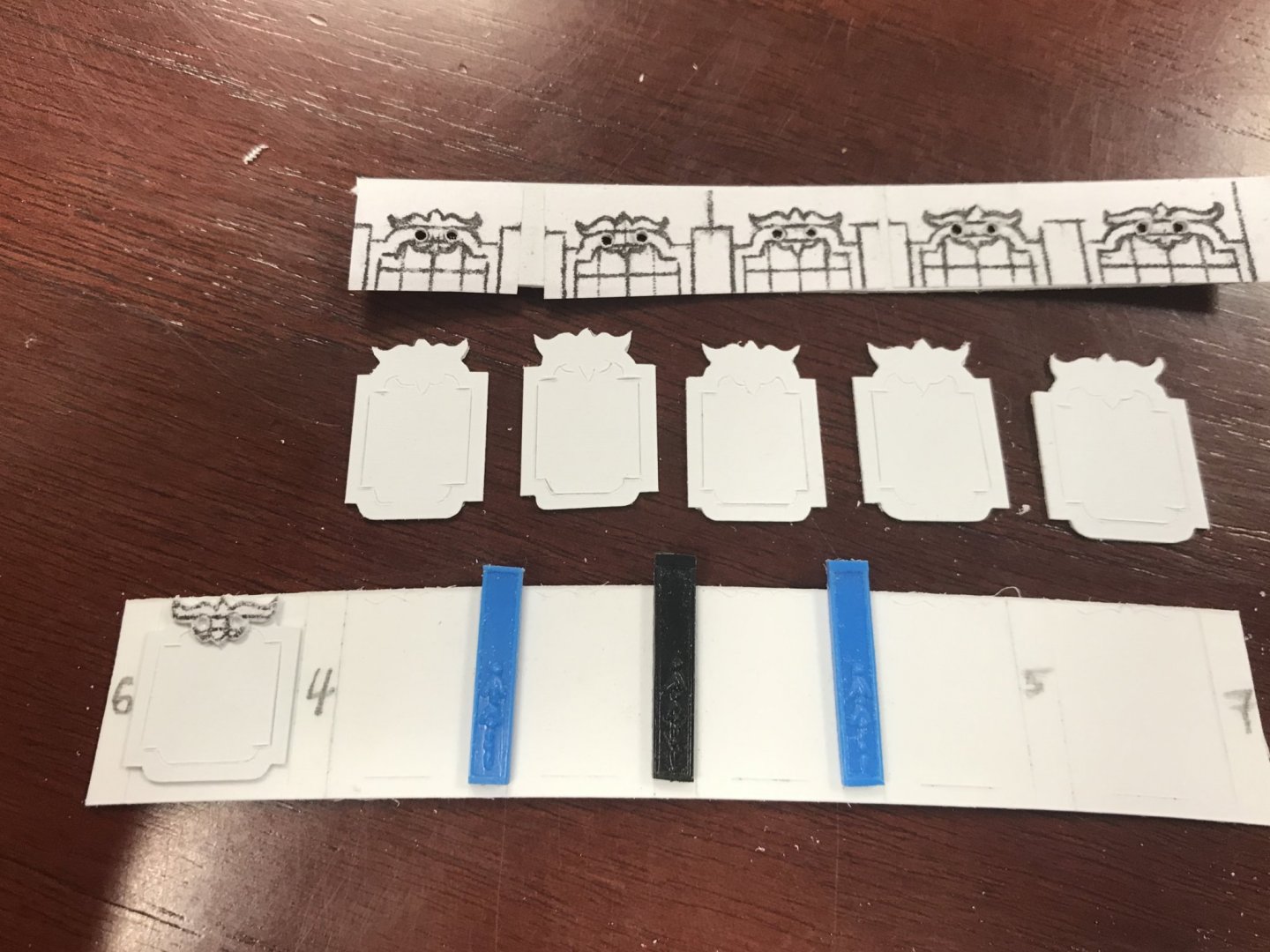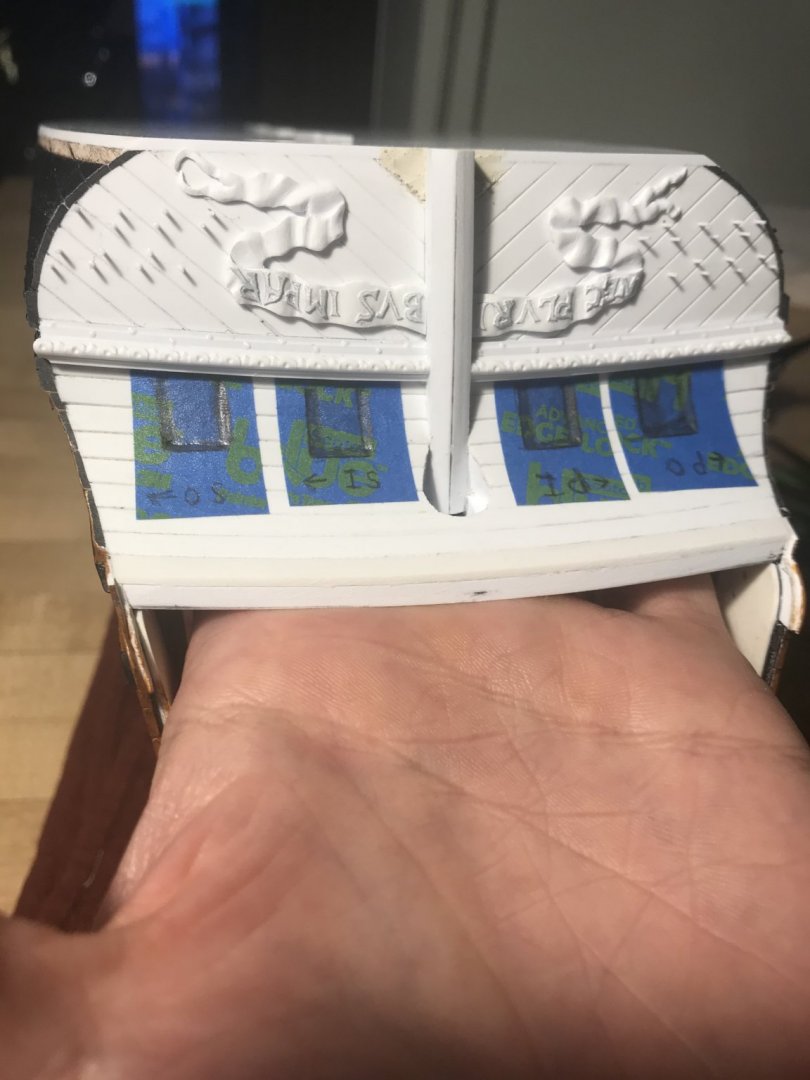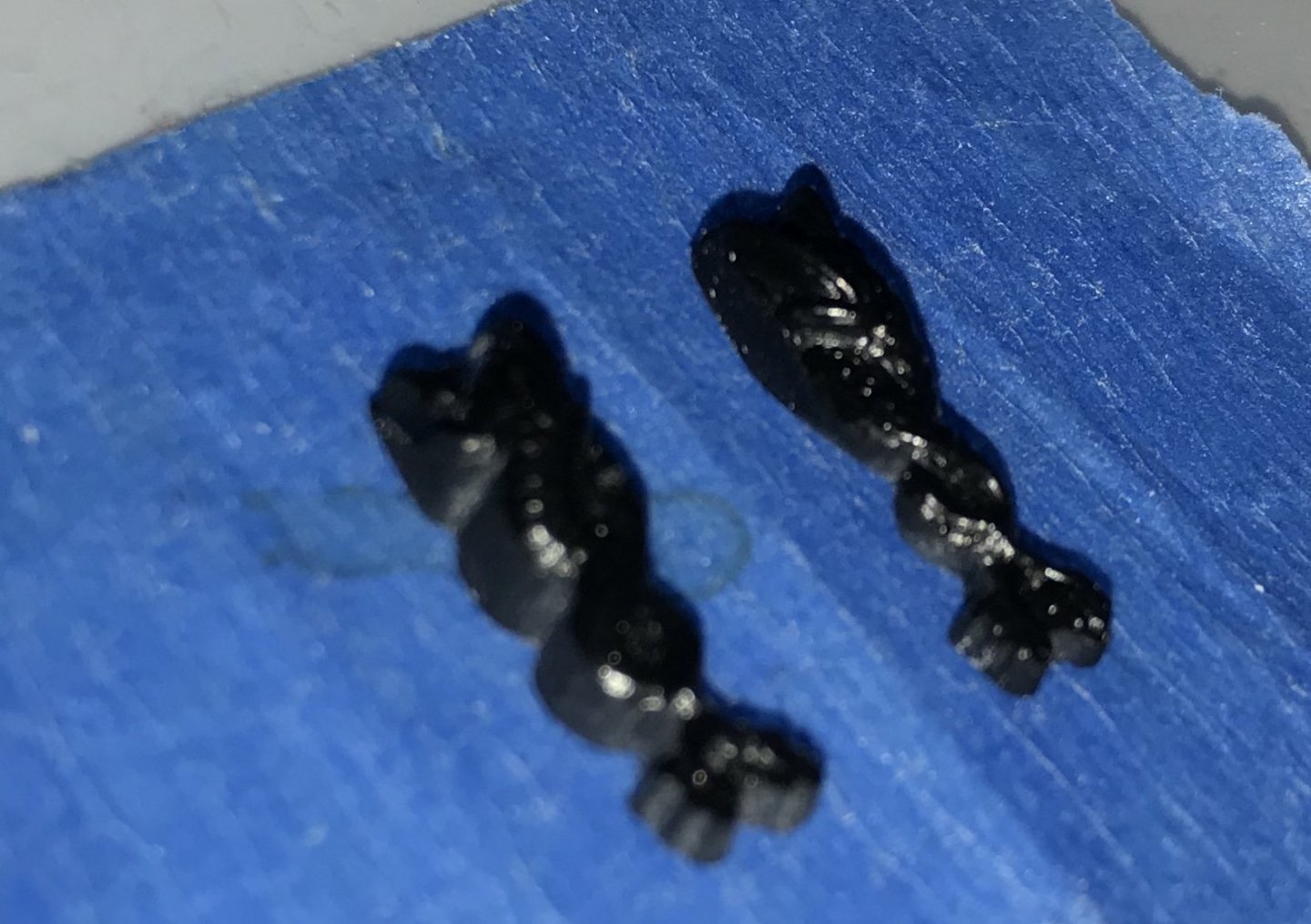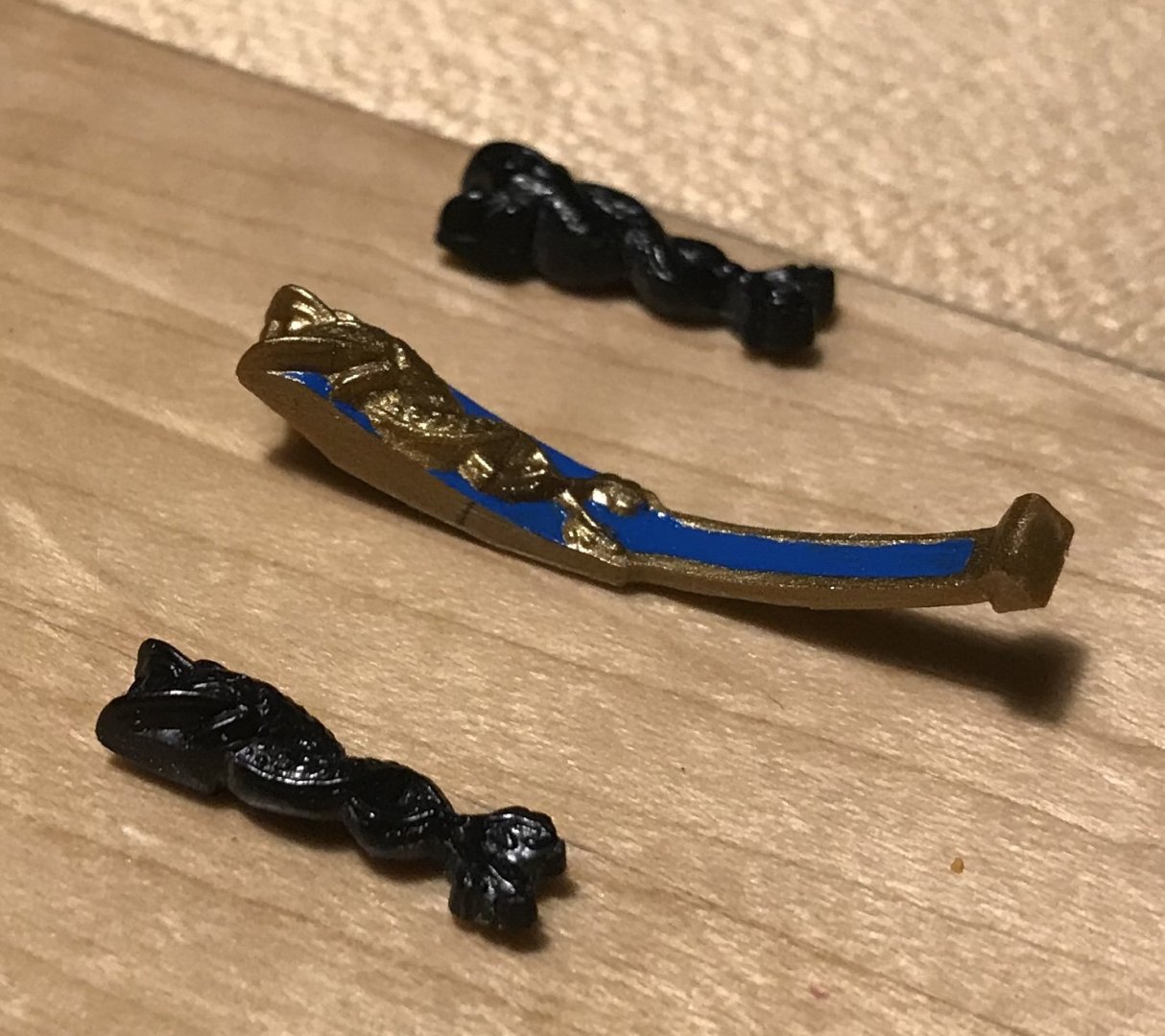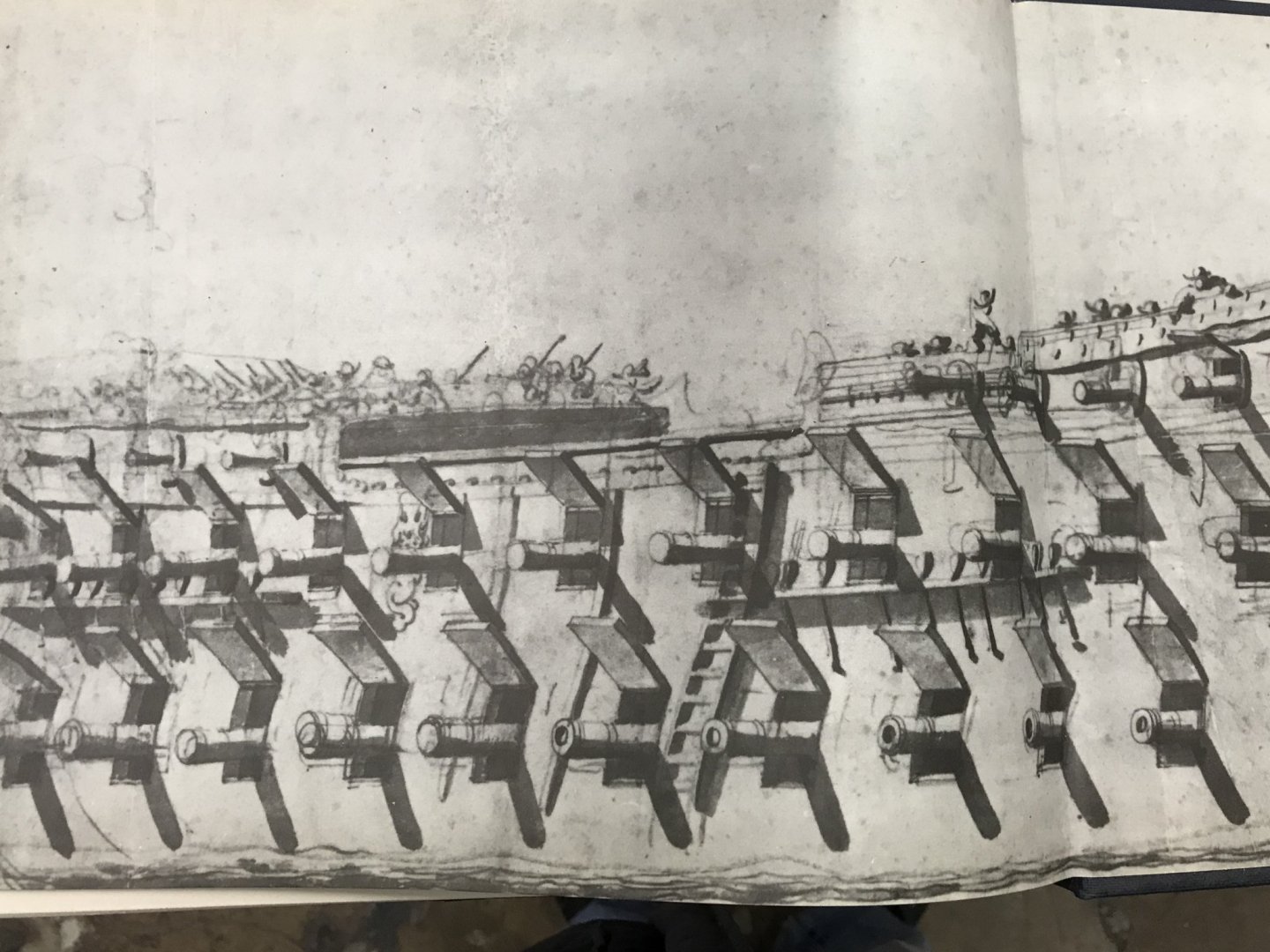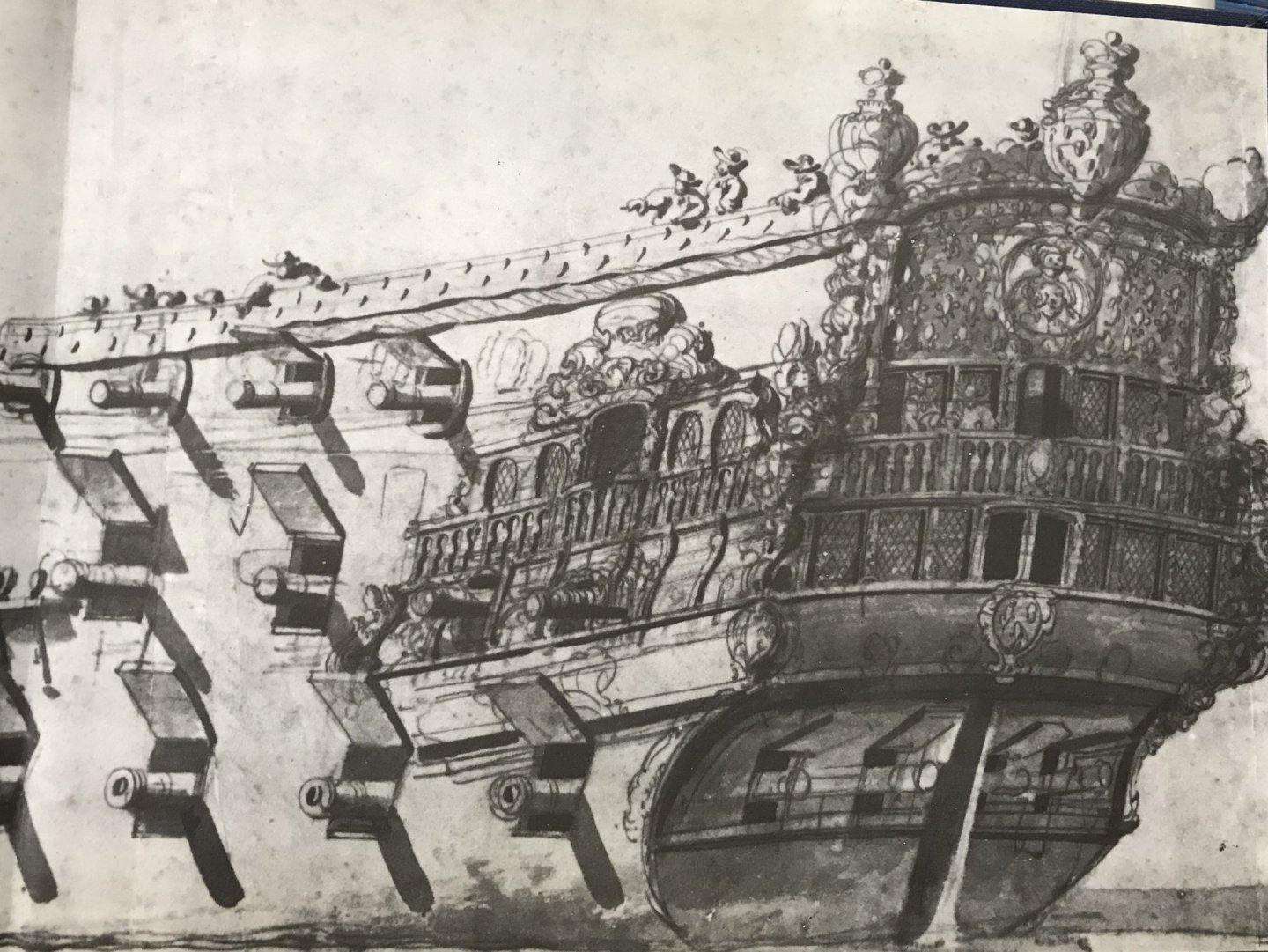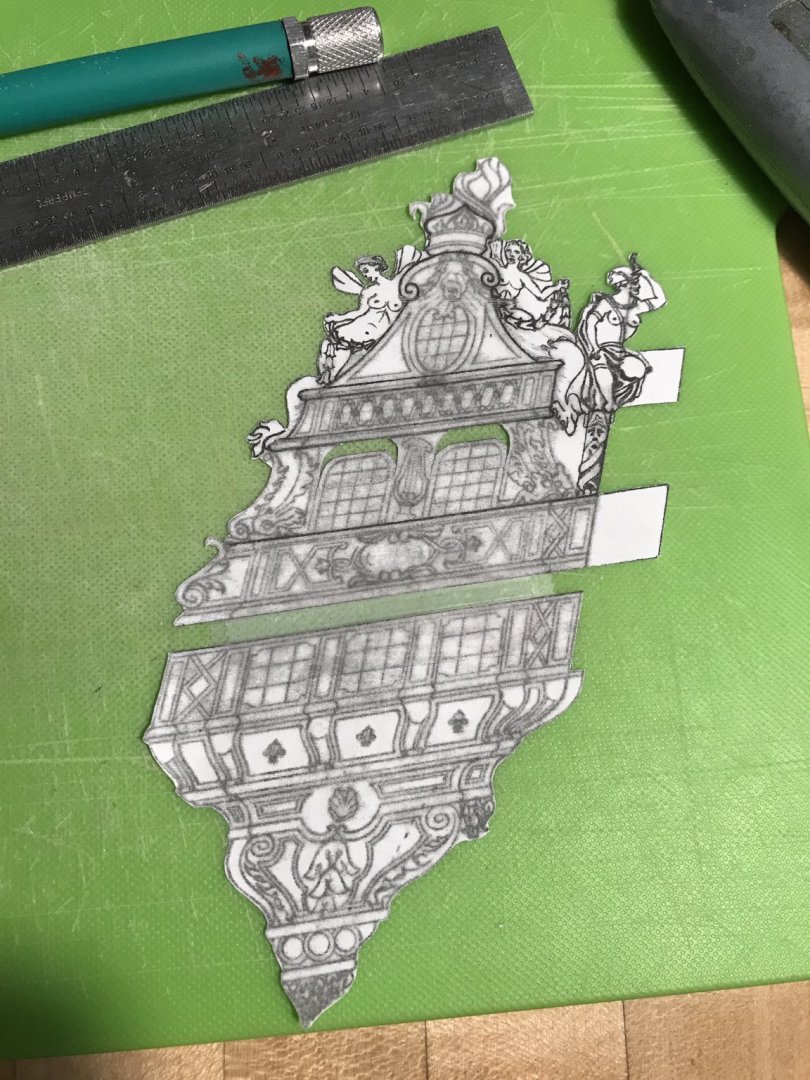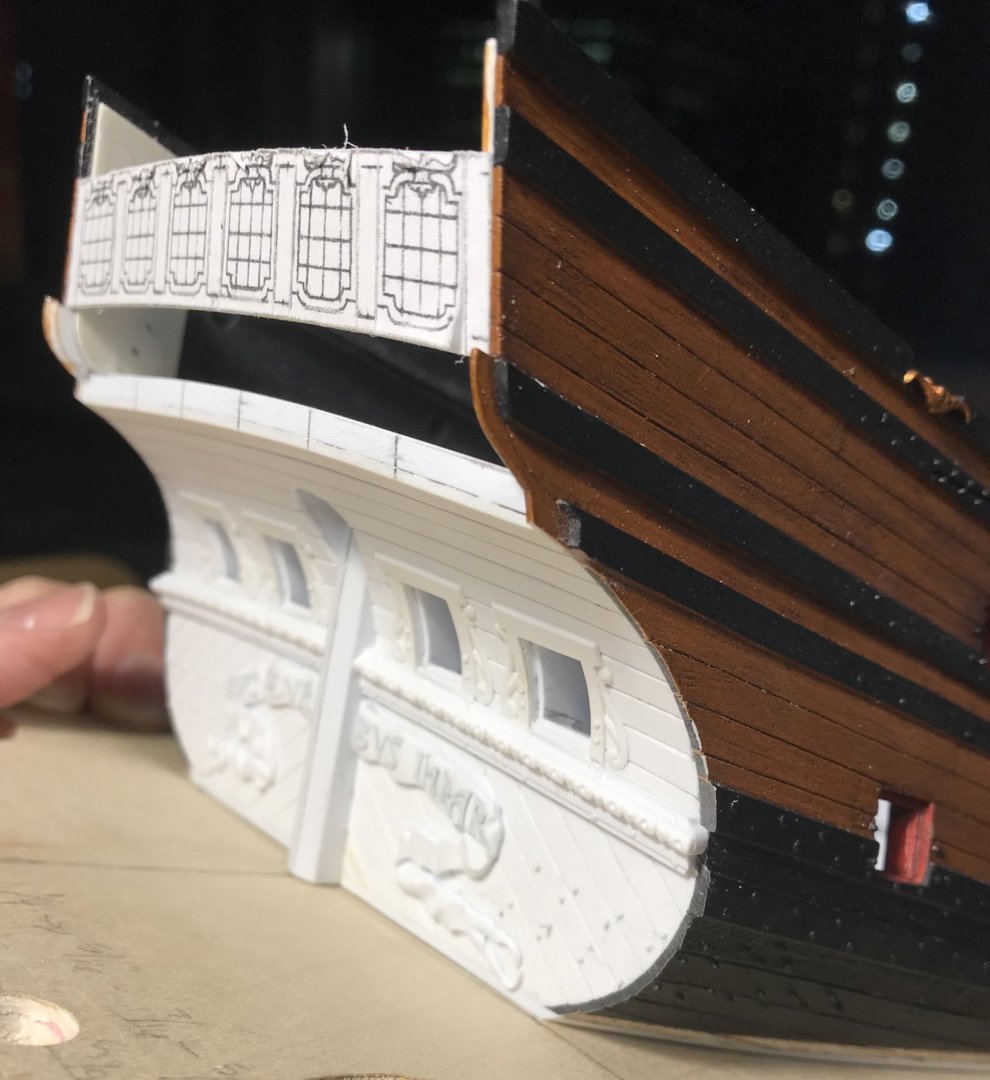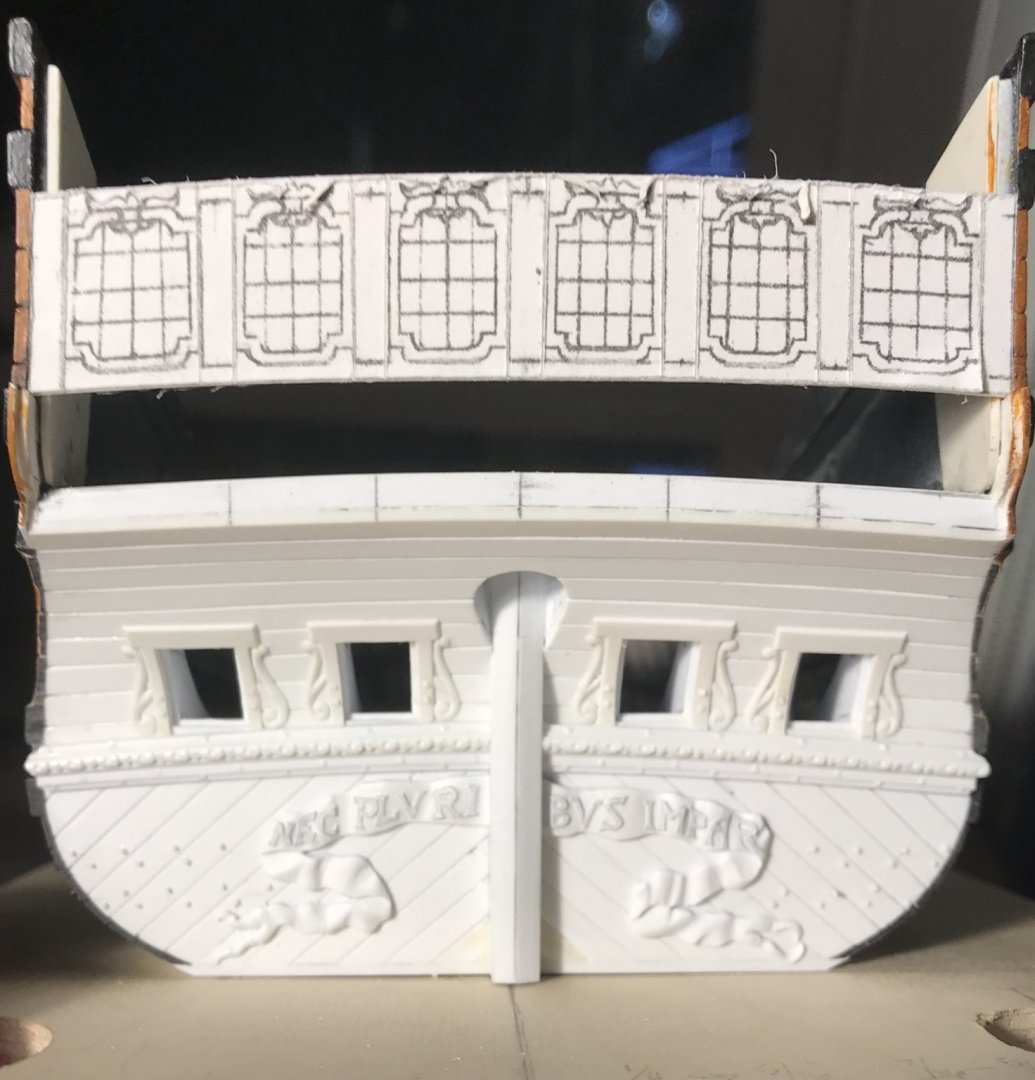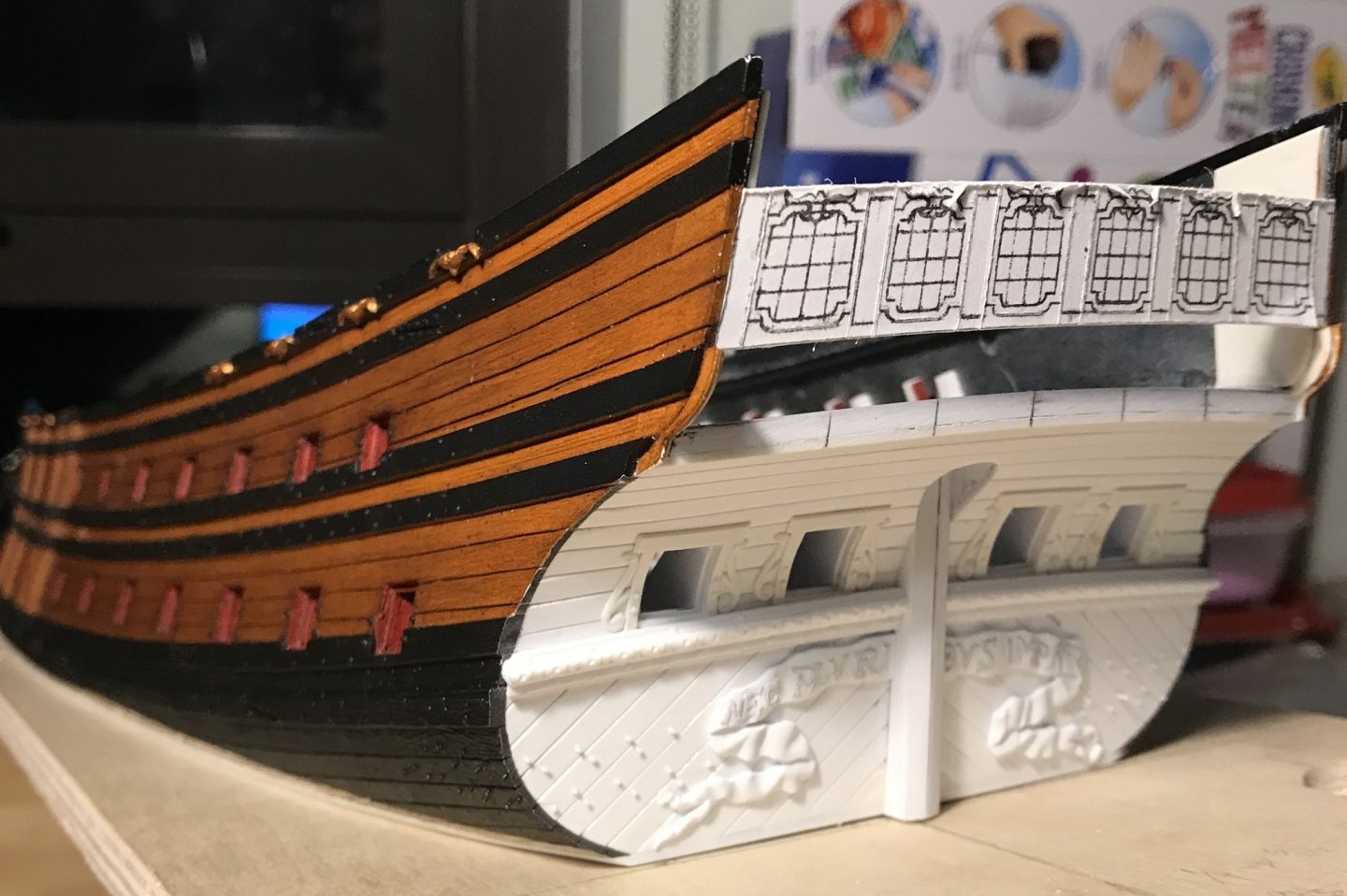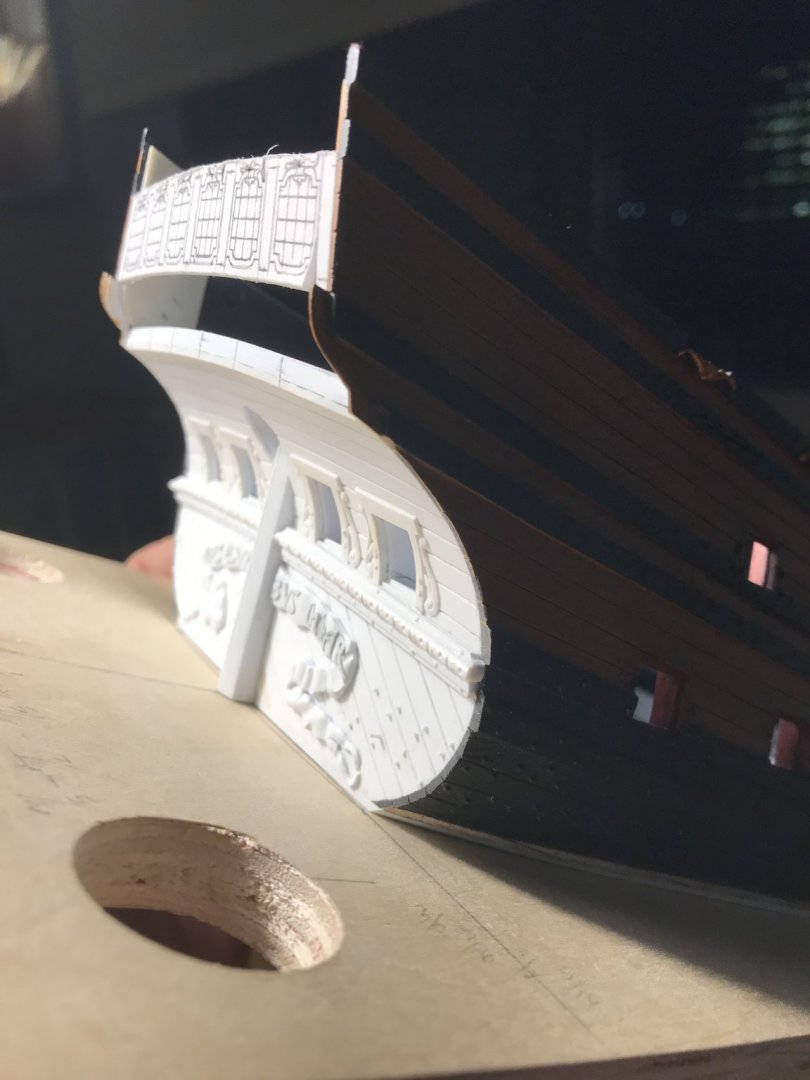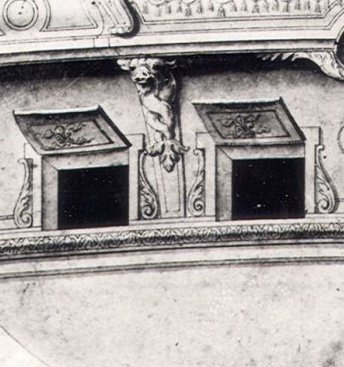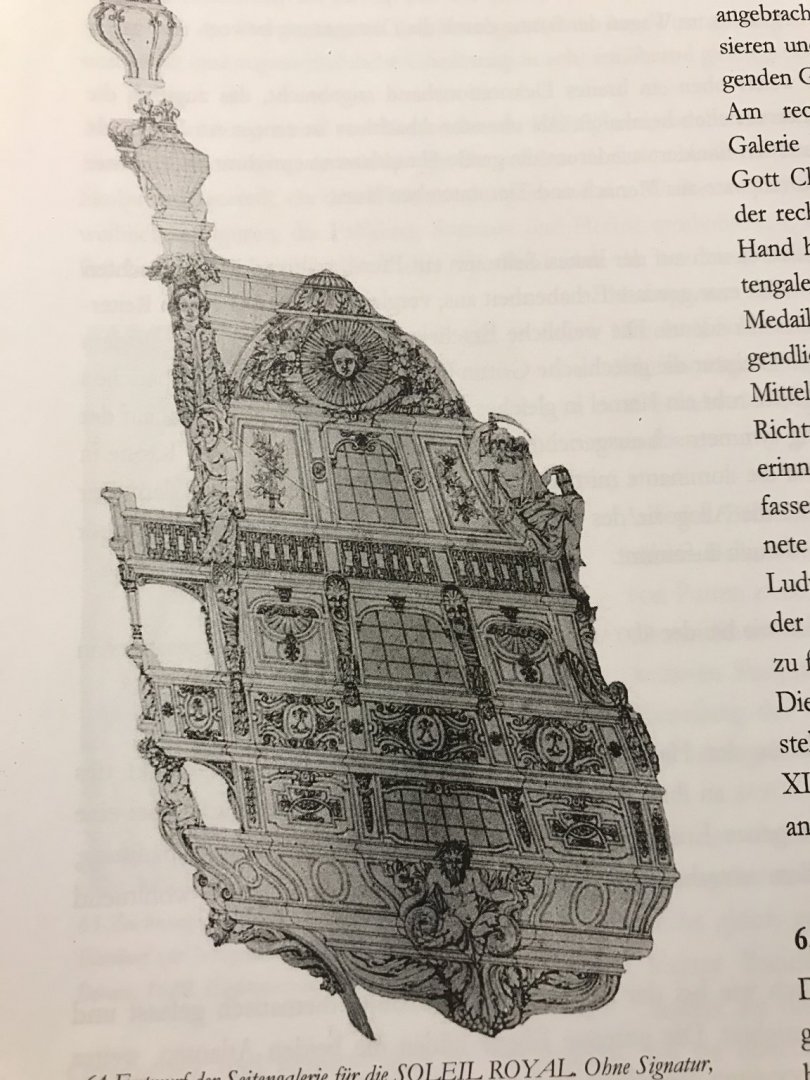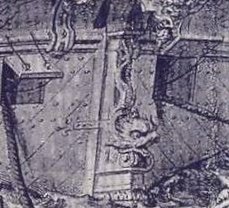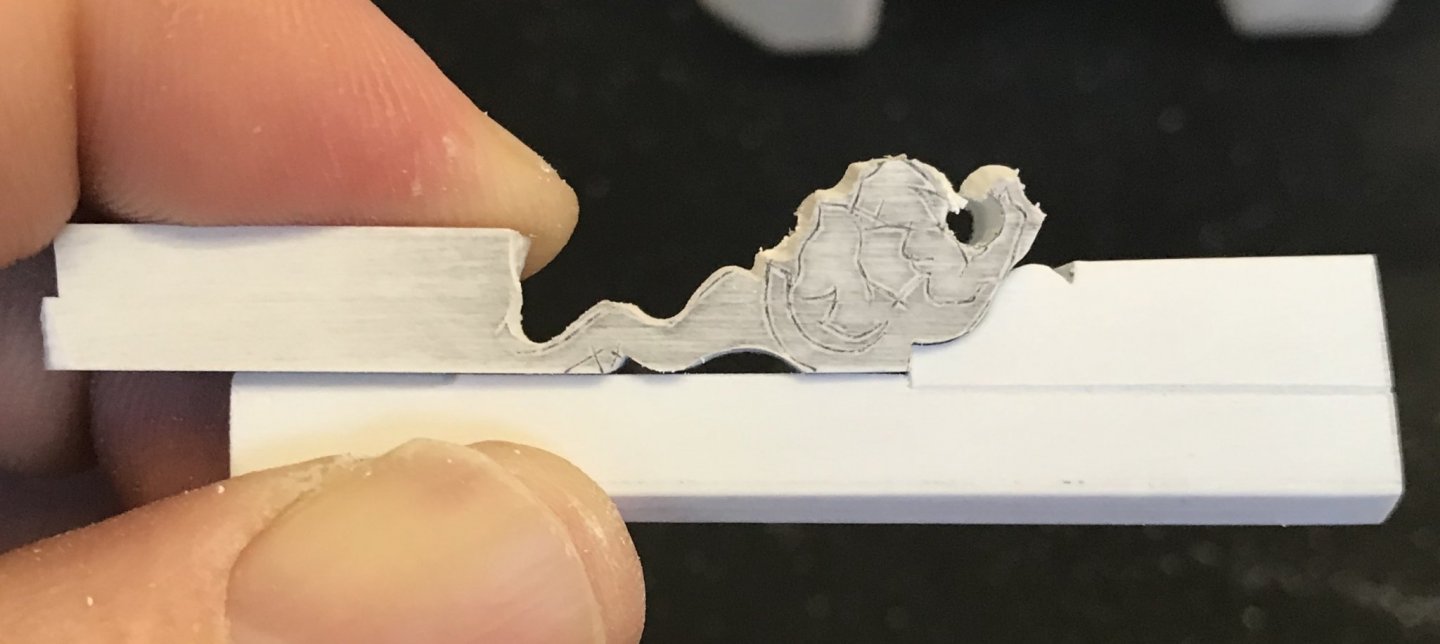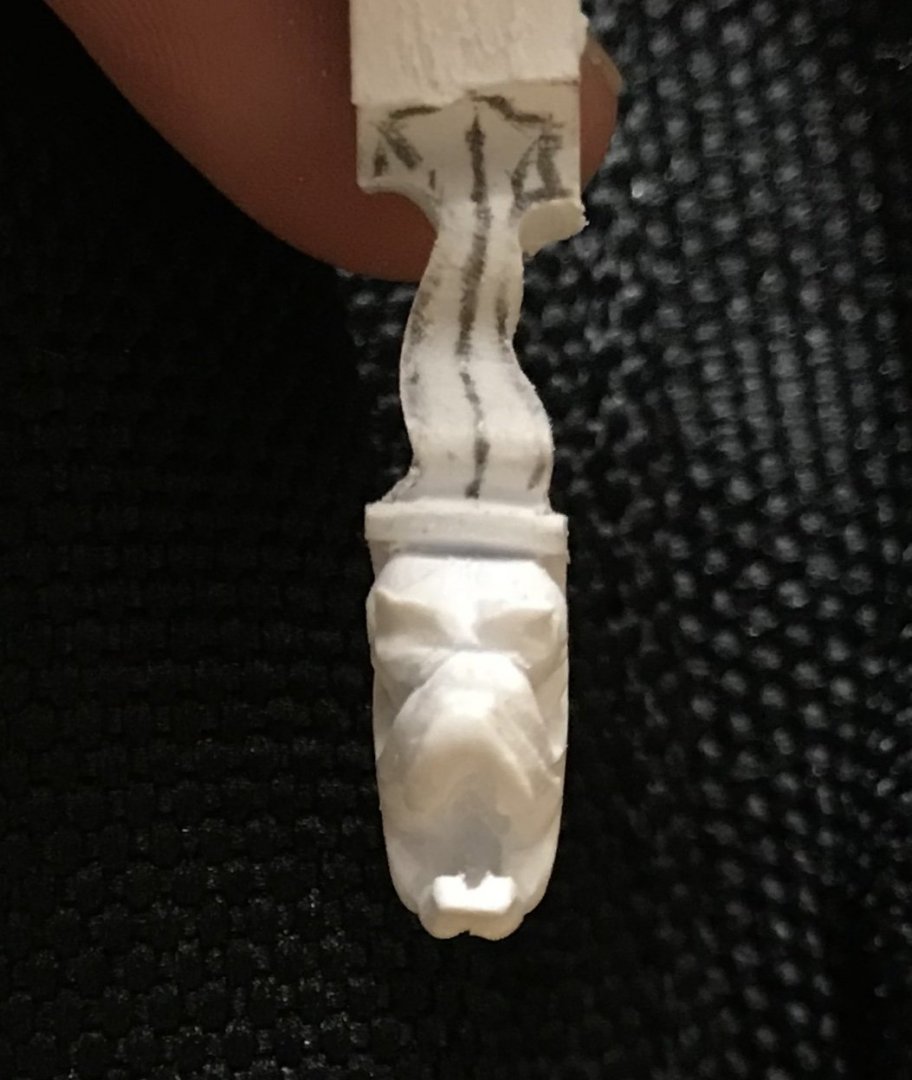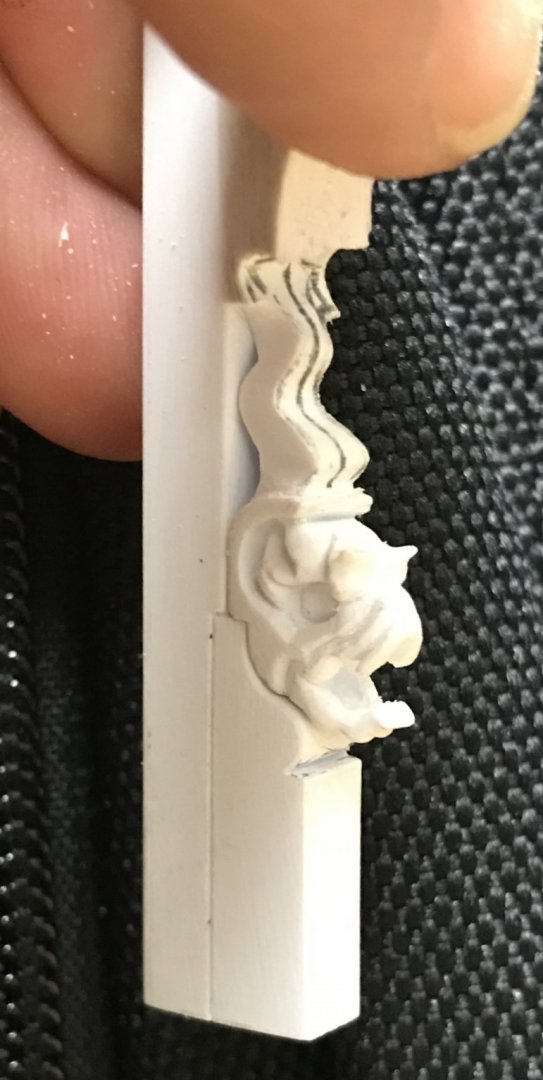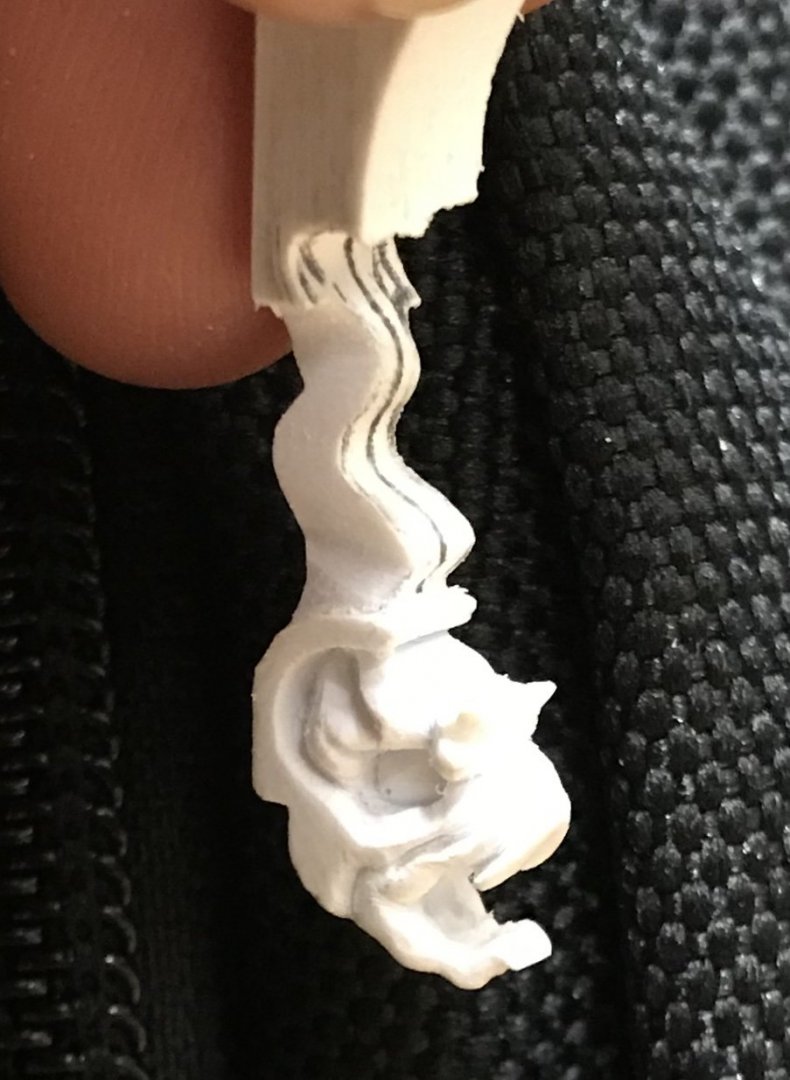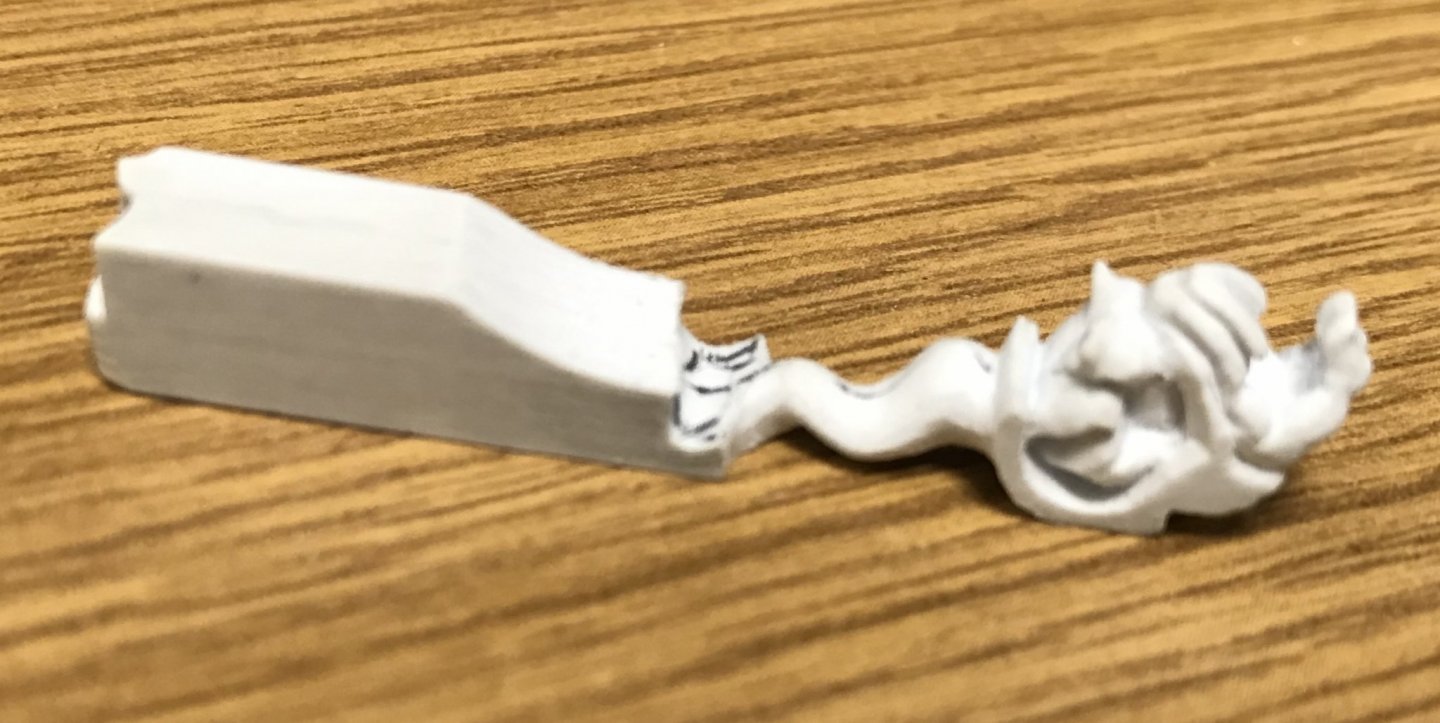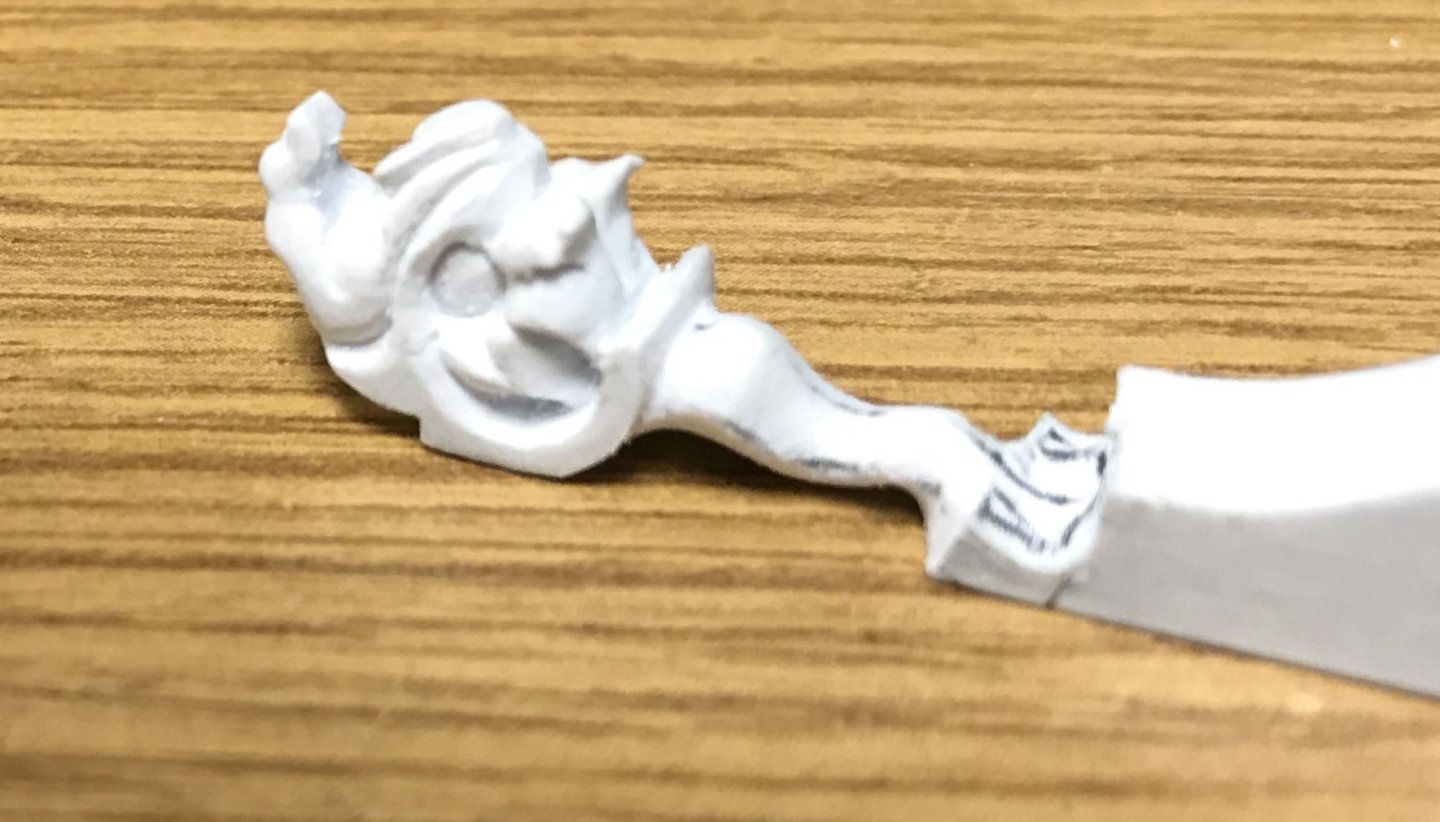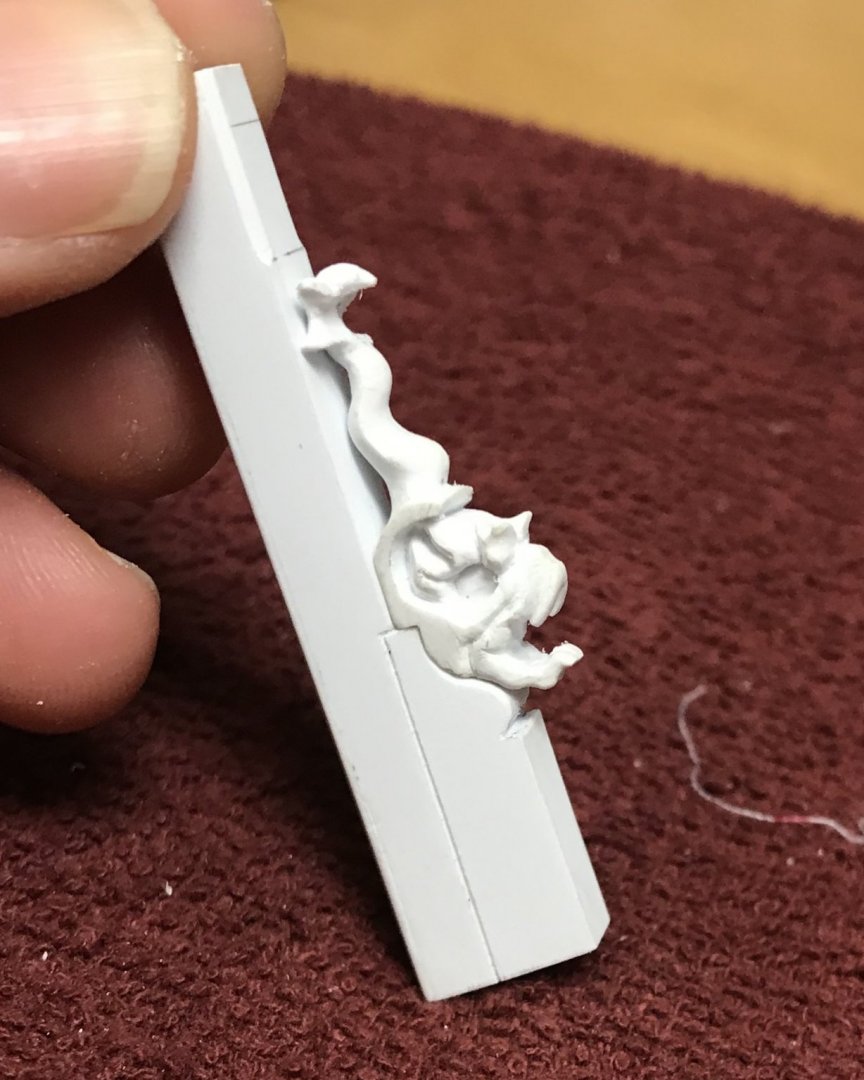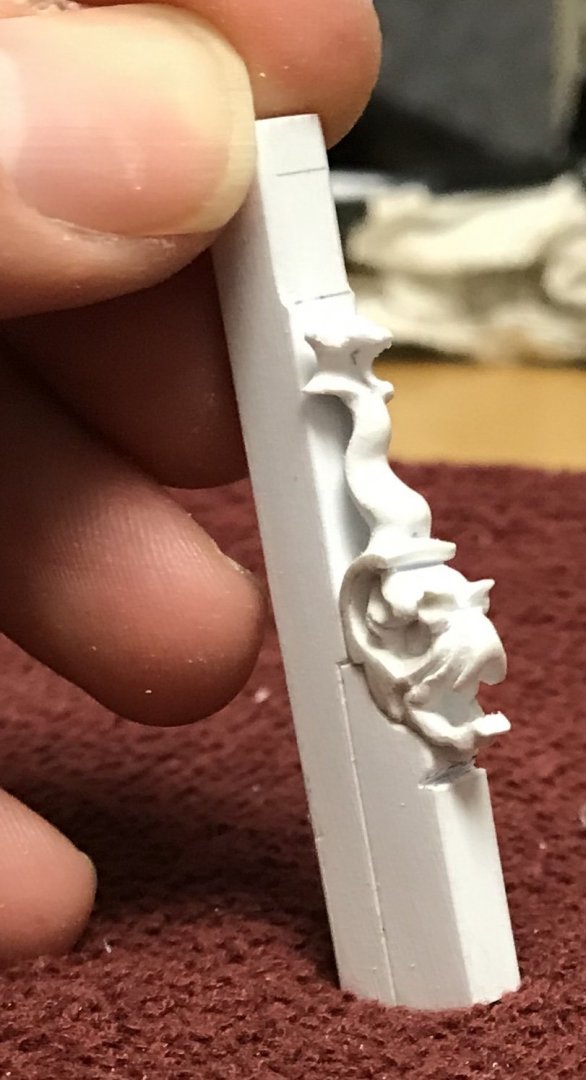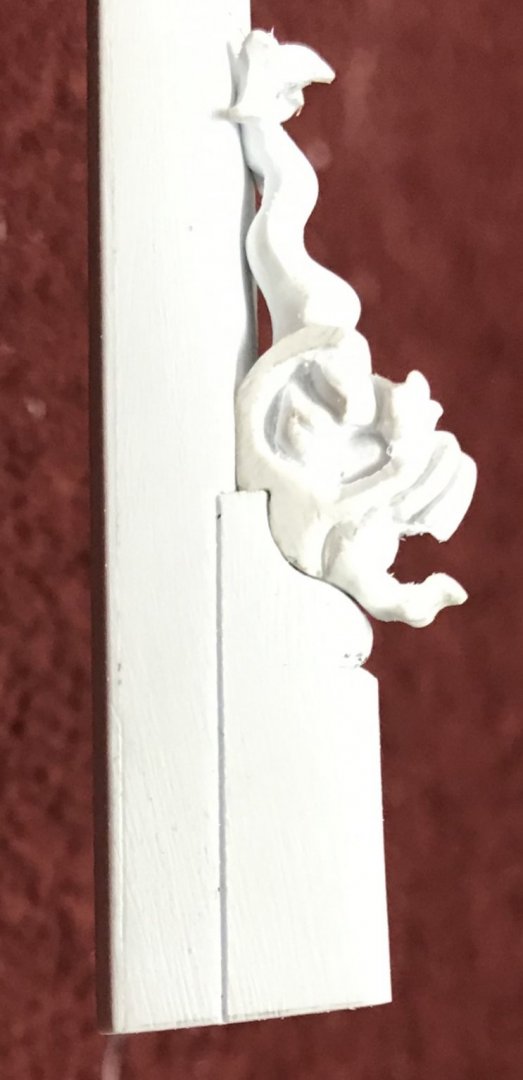-
Posts
3,292 -
Joined
-
Last visited
Content Type
Profiles
Forums
Gallery
Events
Everything posted by Hubac's Historian
-
I’m glad to know you’re still here, Victor!
- 2,696 replies
-
- heller
- soleil royal
-
(and 9 more)
Tagged with:
-
Designing of these reverse-curve pedestals and the paneling, in-between, has been giving me fits. As a reminder of Berain’s layout: This is a challenging thing to approximate onto the Heller architecture. My first break in drawing came after much erasing and re-drawing, and I still wasn’t happy with the result: I liked the in-board pedestal shape, but I didn’t like the relationship of rake, relative to the outboard pedestal. I also wasn’t quite sure that the circle was the right diameter. After allowing it to sit for a few days, I came to a realization about Berain’s drawing. Although he does indicate balcony overhangs with shadowing, the drawing is, otherwise, presented as thoroughly one-dimensional, without any foreshortening of perspective for the rake of the stern. In other words, in order to arrive at a closer impression of what he drew, one must design with the more likely vantage point in mind; as though you were looking at it straight-on, but from a level plane or above. After much re-drawing, here is how the shapes change when viewed from below: And then, above: Now, the layout looked right to me, or at least as close to right as the Heller architecture will allow. Once I was sure that I liked my shapes, I double stuck a scrap of vellum to just beneath the crease of the stern counter. I, then used my finger nail to sharpen that crease into the vellum. Then, very carefully, I mapped the reverse curves and paneling onto the vellum with a series of dots that were close enough to accurately fair them, once the paper was removed. After glue-sticking the paper to a scrap of oaktag, I faired and darkened all of my lines, and finally cut out the three main elements with a sharp matte-knife: It may appear that the top reveal above the panel is too large, however, there will be a small cove moulding beneath the overhang of the top transitional moulding, and this will balance out the weight of the reveals. As for the bottom reveal, the aforementioned foreshortening of perspective takes care of that issue. Next, I could use the inner pedestal patterns to demarcate the central raised panel, for planking. I also traced the outer pedestal profiles, though, to be sure that I liked the layout. I made one last check with old man winter (the widest of the four seasons figures) to make sure that I was happy with this: As a side note - the transitional top moulding will run between the Four Seasons figures and the pedestal bases. Both Berain and Tanneron present this as a seamless transition. I, however, do not have enough space to make wider pedestals AND present the more elaborated lambrequin carving. Allowing the top moulding to run between them will nullify their difference in width, as the figures will be fully supported by the moulding. Or, so I think... As I often say, this build is a reconciliation of sources and a compromise in execution. Finally, I got to planking the next layer. This time, I created a neat radius around the head and crown. I won’t bevel that radius, though, until the final framing layer of moulding, between the inner pedestals, is applied. I nipped the outboard profile of this second planking just a little past my lines; that way I can trim everything flush with the pedestal appliques, after they are applied. One of the trickier things to keep in mind is that the bottom course, of this second layer, has to be beveled so that it does not interfere with the bottom moulding that helps frame the stern counter, and which I will make, once all the layers and pedestals are in place. The reason for that sequencing is that the top and bottom transitional mouldings have to overhang everything in-between, and I don’t want to guess where all of that may end up. The port side course was beveled flush, after being set in place. The starboard course has only been pre-beveled, so far. One last consideration is that the counter profile actually extends beyond the tumblehome profile of the stern: I’m not 100% sure how I will resolve this, just yet, but my inclination is to leave an overhang on the outboard paneling layer (with the circle, and to which the outboard pedestals are mounted, and allow the counter level of the quarter gallery to butt up behind it. This will create the small step that seems to be implied in Berain’s drawing. So, that’s where things stand, so far. I hope all is well with you all, and thank you for looking in.
- 2,696 replies
-
- heller
- soleil royal
-
(and 9 more)
Tagged with:
-
Believe it or not, aside from heat-bending the bow extension pieces, the aspect of this whole project that has given me the most trepidation is the planking of the stern counter/false balcony. The reason being that this feature of stern architecture took me the longest time to even understand. Initially, I thought this reverse curve was a seamless transition into the lower tier of lights. The St. Philippe monograph, on the other hand, illustrated that, no, there needs to be a slight projection away from the plane of lights; a sort of shelf, if you will, that ultimately supports a fairly substantial transitional moulding. This transitional moulding/shelf supports the four seasons figures that support the walkable balcony above. Not only that, but the run of the counter must smoothly accommodate the compound curves of camber and round-up, around one particularly tight bulkhead radius. Taking a look back, before paint, and in relation to Mr. Lemineur’s drawing of the stern, you can see that my extension piece is absent of this ledge: Once I realized this mistake, I grafted a ledge extension into the existing plank rebate of my first extension, and then recut that planking rebate into the shelf extension; all very fiddly business, and in the absence of a comprehensive plan to work from, the shape I patterned for this shelf was something of an aesthetic approximation. As the build has progressed through the fairing of these bulkheads, these extensions have been pared down to their final shape. As a side note, it is kind of hilarious to me that I took such pains to cut this plank rebate into the ends of the lower hull and upper bulwarks - both to provide a glue ledge for the plank ends, and also to bring the side plank butt ends down to scale - only to realize that in the end, they will mostly be covered. Except for the area between the waterline and the transom moulding, everything above gets covered; first by the wrap-around of the quarter gallery lower finishing, and then, by pilaster mouldings, all above. At least the beakhead bulkhead will still show this detail 😕 Digressions aside - one must finally add to this equation the fact that I want to seamlessly incorporate Louis’ angelic little head into the run of the counter, and all of that becomes quite challenging to make look right. While laying the lowest, first course of counter planking, I realized that I would be better served by simply butting the planks flush with the edges of the head ornament, and not adding that slight bevel to the plank edges around the head. The reason for this is that the border that the head creates is kind of irregular and a little jagged. Following all of that closely with a bevel - no matter how carefully done - would look jagged and horrible. Because there will be at least another two planking layers around the head, I can create a smooth radius around the head, with those layers, and then bevel them, inward toward the head, in order to give it a sense of concavity. With that all settled, the first two courses went down smoothly. The run, along the bulkheads, there, is fairly flat. I was very careful to let-in as closely as I could around the crown. For the third, and top-most course, around the tight radius of the bulkhead frames, I discovered that I needed a plank just a little bit wider than the 5/32” that I used for the two coarses above. I was hoping to avoid laying two very narrow planks, so instead I ripped one plank to 3/16”+, and then engraved a line down it’s center, on the plank backside. This effectively created a bending crease that eased the transition around this tight radius, while eliminating any possibility of plank gaps. So, the rough, before fairing, was looking pretty promising: After fairing, things were looking a lot better. I sanded the top edge of the counter planking so that I would have an even 1/16” space, beneath the window frames, for the transitional moulding. This enabled me to fit and glue-in the pilasters between windows. I will be trimming the tops of these pilasters flush with the window plate, before glueing, and the outer pilasters will be glued in after the plate is installed, because they overlay the ship’s side planking: I can now go ahead and spray-prime the window plate, so that I can paint-in the inner edges of the window frames with yellow ocher, before installing the glass panes. So, now that we have a good and fair foundation to work from, I can begin playing with the artistic layout of the counter. Here is what Berain drew: The layout revolves around this central panel, spanning the middle four windows, which projects further outboard than the paneled sides. Interspersed along the counter, are the four pedestal bases that visually support the Four Seasons figures. These pedestals will stand proud of their respective backing surfaces, and the central two must project far enough that they are just proud of the lambrequin carving that bridges between them. If I get the proportions of all of this right, and the shape and raking angles of the pedestal bases aesthetically right, then the entire ensemble will convey a similar sense of elegant proportion, even though the profile of my stern is more vertically oriented, and less sloping than what Berain drew. This is an artistic process that begins, simply by sketching a few primary parameters directly onto the model; in this case, the outside edges of the central panel, as well as the circular framework of the paneled sides: It is the pilasters between the 1st and 2nd/5th and 6th windows that mark the location for the figures of Spring and Summer, and thus delineate the outside breadth of the central panel. In the Tanneron version, there is no circular paneling to the sides of the central panel. He seems, instead, to have created these circular medallions: To include this detail on my model, I will have to strike a delicate balance between the diameter of those circles, so that there is enough space left over for the paneled sections to either side of the circles. This may mean reducing the outer breadth of the central section, and simplifying the design to only include the raised cyma projection of the pedestals, themselves. In my rough sketching, above, I’ve drawn two dotted lines. The outer line represents the raised ground to which the pedestal is mounted, as Berain designed it. If I eliminate that line, I’ll have a little extra room for the side panels. Tonight, I’ll make better sketches and see where I end up. Once I like the spacing of all the various elements, I’ll make an oak tag tracing pattern for the center pedestals, and a pattern for the outer pedestals, which are raked at a different angle. I can then use the middle pedestal pattern to draw the outer breadth of the center section, so that I can begin planking that section. The oak tag patterns, together, can then be used to frame-in the side panel shapes onto slightly thinner styrene sheet. All will become clearer, as I go. As ever, thank you for your likes, comments and looking in. -HH
- 2,696 replies
-
- heller
- soleil royal
-
(and 9 more)
Tagged with:
-
Just outstanding! She really cuts a pretty figure!
- 1,784 replies
-
- winchelsea
- Syren Ship Model Company
-
(and 1 more)
Tagged with:
-
This evening, I decided upon a plank width for my stern counter; 9/64”, strong. This width affords me a little leeway to fair beneath the moulding that will support the four seasons caryatids. On other words, I can plank with three boards. Much of the evening was spent planking just one side of the first course. Along with the compound curvature of camber and round-up, one must bevel the downward edge of the board, for the rake of the stern. All, while trying not to diminish the uniform plank width. My plan is to true up the top edge of the false balcony, as necessary, and according to how I want my top moulding (that serves as the base for the four seasons figures) to align with the bottom of the window frames. We (and our ships) are all works in process - all of the time. Thank you for being here.
- 2,696 replies
-
- heller
- soleil royal
-
(and 9 more)
Tagged with:
-
Thank you, MD! I have to say that I really enjoy working with plastic. It is much, much easier to carve than wood, and it is infinitely more forgiving of your mistakes. I appreciate the thought, MD.
- 2,696 replies
-
- heller
- soleil royal
-
(and 9 more)
Tagged with:
-
Alright, so I just got home from my daughter’s rousing talent show performance of Hamilton. A pleasant diversion, if ever there was one. Of course I couldn’t resist taking a few measurements, once I was home. Taking a closer look, at the main deck level, the stern is actually 3/32” out of square. When you add the upper bulwarks, this grows to 5/32” at the tafferal. Visually, if you did not know this was the case, it would not jump out at you. Holding a straight edge across the span, then yes, it becomes somewhat apparent. It isn’t terrible, though, and the gentle arc of the round-up should help conceal this problem. It kind of is what it is, at this point. The fact that I am making all of the visible decks from scratch also helps things, a bit. I would love to know whether the stock kit is similarly out of square. While it’s true that I flattened the aft edges of the stock lower hull, so that I could add extensions, I doubt that I was so careless as to completely change the rake of the stern, from one side to the other. And I know that the extension pieces were perfectly parallel. Anyway, it will all work out just fine, I think.
- 2,696 replies
-
- heller
- soleil royal
-
(and 9 more)
Tagged with:
-
As ever, thank you all for the likes and looking in. Backer, I’d gladly take one of you over 10 able-bodied shipwrights! That approach, Druxey, would be highly feasible if the sheer of the stern didn’t rise above that level. The trouble is that trimming back from zero to an eighth, at the main deck level, would necessitate an even more extreme trimming back of the upper bulwarks, as well. When all is said and done, I may have trimmed from zero to over a 1/4”, and I really can’t afford to lose that real estate on the upper bulwarks, which were extended, at the outset, in order to accommodate the new quarter gallery. There is a lot going on up there. My hope is that the stern, at the height of the tafferal, won’t appear visibly out of square. The good news is that I only have one wrapping balcony to deal with, at this level, where the discrepancy is not noticeable. We’ll see - it may come down to a little theater trickery to minimize perception of error. Hopefully, not. Although, if I really want to kill my own buzz, I suppose I could hold 6” Starretts up to the aft edges of the lower hull, and read them like winding sticks - just to see how much trouble lays ahead. Let’s take a vote - should I ruin my weekend before it starts, or bury my head until Monday?
- 2,696 replies
-
- heller
- soleil royal
-
(and 9 more)
Tagged with:
-
After finally resolving the fairness of my bulkheads, I made ready to install them. Taking a lesson from the prior two levels, on this go-round I decided to glue in opposing indexing tabs for each bulkhead, prior to installation. Each tab (excepting the center bulkhead) is beveled to accommodate the angle of the bulkhead. I took this precaution because the specific placement of the bulkheads is now of critical importance; they must remain as close to center of the pilasters, as possible, so that I will still have room on the interior to glue-in retaining strips for the window glasses. I could also, now, fix the position of the jaumier ornament. Before doing so, I glued a backer to the head for the counter plank-ends to land on. In the picture above, I have glued-in the head to the framing of the stern counter, along the centerline of the ship, and cross-checking to make sure I was centered on my window plate. The starboard side covering board, that abuts this ornament is being fitted. I’ve deliberately filed a small bevel where the covering board joins the face because every succeeding layer of planking and moulding will be similarly beveled in order to create a sense that the ornament is set into the stern counter. Now, with both covering boards installed, and their edges faired, I could proceed with the risky business of letting the acanthus scrolls into the transom planking. Again, the reason for doing this - as opposed to simply surface mounting the scrolls - is that I really wanted to reduce (by half) the gap between the scroll volutes and the head. This is a calculated gamble that I will be able to dress the front face of the covering boards sufficiently with moulding, in order to create a seamless transition. After much checking and re-checking for position, the initial excavation did not look promising: Because of the way that this last transom plank fays into the transverse bulkhead, it was not initially clear to me whether I had broken through the plank to get to the bulkhead. To be clear - I wanted to break through, because the bulkhead is my mounting surface. I wasn’t sure weather to keep digging, or to stop and fair the bottom of my mortise. Just a little further, though, and I saw daylight. With a lot of careful inletting, I eventually arrived at my cleaned-up mortises: And, here are the scrolls glued-in, from a variety of angles: In hindsight, I kind of wish that I had glued some material to the backside of the acanthus scrolls, so that I could have created a more rounded relief, but such as it is, the carving will do just fine.
- 2,696 replies
-
- heller
- soleil royal
-
(and 9 more)
Tagged with:
-
I was in the STRAND today, and was leafing through a book about the great maritime museums around the world. The chapter on the Musee de la Marine, in Paris, had a good re-print of the following: There is no artist attribution for the painting.
- 510 replies
-
- reale de france
- corel
-
(and 1 more)
Tagged with:
-
A few more details of note. I have fashioned entry ports, in the lower transom for the rudder chain/rope (nomenclature, Druxey?), from two small discs of styrene. The backing disc is slightly thinner. These were based directly on Puget’s drawings of the Monarque which - in a rarity of artistic convention for the times - actually shows them: I also gave flipper his pupils and pectoral fins: And, I spent a good long time transforming the window frames from flat to softly rounded. While I did fashion a one-sided moulding scraper from old hacksaw stock, I found this tool exceptionally difficult to control without digging into the frames. Ultimately, my trusty old Bebe, hooked chip-carving knife was just the thing for creating a series of micro-facets, which were then blended smooth with the well-worn fine-sides of emory sticks that I had cut down to suit my purposes. The frames look good, and I am happy with them. In the present, I am using Druxey’s method to fashion the glass panes from acetate, and that is all going swimmingly: I also made the false quarter gallery lights, but screwed up the engraving on the port side, and will have to re-make that one. In the next few days, I will buy a suitable shade of grey acrylic and fill-in the leaded cames. Hopefully, I didn’t engrave them too deeply, but the paint will reveal all. On the other hand, what has proved to be much less straight-forward - despite the earlier protocol established with the lower transom - is the framing of this next level of the stern. I had thought the hardest thing about it would be the planking of the lower false gallery/stern counter. I was so wrong about that! If this post has a title, it would be MODERN PARABOLA’MS, starring ME in the Chevy Chase role, as the utterly baffled modelmaker attempting the unravel the ghostly mysteries of the 17th Century shipwright. There are a number of things about framing the stern, from scratch, that I did not recognize, from the outset, as being problematic. For starters, as mentioned in the prior post, there is a certain degree of asymmetry that Heller built into the standard kit. To this day, I am still baffled as to why it was necessary for me to shift the starboard rear, upper bulkhead forward 1/16”, so that the waist ladder would align, properly, with its counterpart on the lower hull. Nevertheless, it was necessary to do so, in order to make the whole thing work. Another thing that I did not realize is just how far out of square the stern skews, as the ship rises above the waterline. I began my construction by squaring the transom waterline to the ship’s centerline. However, by the time I got to the level of the upper main wale (where the upper bulwarks join the lower hull), the starboard side was projecting a shy ⅛” further aft, than the port side. I discovered this as I was letting-in the latest transverse bulkhead, taking care to stay square with the centerline. In this picture, you can see that I am flush, to port, but still an ⅛”-, out, to starboard: So, the first order of business was to fir-out the aft edge of the bulkhead former to make-up this discrepancy. After gluing on an extension, I faired the edge from zero, on the port side, to an ⅛”-, at starboard. I then beveled the aft edge, downward, to match the rake of the stern. In the following picture, you can see the corrected bulkhead, but also a pair of parallel lines, an ⅛” apart, with a diagonal line between them. These lines illustrate the degree that the stern becomes skewed: Now, this creates all sorts of problems for the framing of vertical bulkheads, which I had already patterned. I was hoping to salvage the bulkheads I had made so, one at a time, I dry-fit them and then marked at the top of each vertical bulkhead, the point at which it extended beyond the transverse bulkhead. I also realized, though, that I had not cut-in deeply enough, the stepped juncture between the window plate and what will be the support for the false balcony ledge. First I marked back a consistent 1/32”+, on each bulkhead. After connecting the top and bottom points, my bulkheads looked like this: After trimming, I again offered each bulkhead to its place, to check for fit. The top juncture was now just slightly proud. This allows for a little final fairing, once all of the bulkheads are glued in place. I noticed, though, that the aft edges of the vertical bulkheads were not running parallel with the plank rabbets, at the ship’s sides. This discrepancy, in turn, necessitated an additional 1/32”+ trimming at the false balcony shelf juncture. So, at least now, the window plate is evenly supported across all of the vertical bulkheads without any one of them forcing the plate out of its proper position. This whole exercise in reconciliation has been a domino-fall of discovered mis-calculations and erroneous assumptions. I next discovered that I had made no allowance for the plank thickness of the stern counter/false balcony, and will next need to cut that back 1/32”, all around. After all of that, though, the bulkheads should be ready for glue. So, finally, onto the parabola’m that my post title alludes to. While I make my living working as a carpenter, I have to admit that I am not particularly strong at math. Wherever possible, I try to take the pencil and paper calculation out of my project work. Occasionally, this short-coming of mine rears up and bites me! I mentioned, in an earlier post, that I thought the previous transverse bulkhead had a somewhat exaggerated camber. Observe how the middle of the bulkhead appears to rise higher, towards the window plate, than at the sides: Well, that’s not what is actually happening here. First, I compared the bottom edge of the window plate with the camber pattern that I made for glueing up the transverse bulkhead laminations. Good on me - it’s a perfect fit: The more I thought about it, though, I realized that the camber pattern came directly from the stock Heller stern plate, which is dead flat. I, on the other hand, have chosen to model the round-up of the stern, as this is an appropriate architectural detail for the time period. So, what happens to that joint, when you rake the plate aft, and induce the round-up curve? Parabola’ms happen, that’s what: To say that I am somewhat invested in this window plate would be the understatement of the new year. While my math may be lacking, I am good in the field, as when the shop, for example, sends a custom-made thing for a space that was poorly measured; I can almost always find a way to make it work. THE WAY, in this case, will be to cover any gaps or discrepancies between the window plate and the stern counter with what will be a fairly generous (3/32”) transitional moulding that wraps to the quarters. The shape of the top edge of the window plate will inform the camber of the walkable main deck stern balcony, that abutts it. Now, it is true that this middle balcony will have an ever so slightly flatter camber than the false balcony beneath it. It is also true that the bottom edge of the window frames, out toward the ship sides, will not hug the transitional moulding line as closely as intended. On the plus side, moving up the stern, I should not encounter this problem again, as I will simply allow the round-up curvature to establish the camber. The camber of all three tiers of windows will be consistent. In the grand scheme of things, these are nits that I prefer not to pick. I’m pretty sure I can live with the results. I hope this cautionary tale will be helpful to anyone else out there who might be planning a similar foray into plastic surgery.
- 2,696 replies
-
- heller
- soleil royal
-
(and 9 more)
Tagged with:
-
Hi Dan, More than anything, this has to do with designing within certain constraints of the kit architecture. You’ll notice that Berain’s windows are rather short, by comparison, and his ornamental cartouche is much closer to the frame outline. The height between decks, on the Heller kit, is exaggeratedly tall; a 7’ person would he quite comfortable manning the guns on Heller’s ship. So, in order to preserve a sense of elegance with the window mullions, I just added a pane.
- 2,696 replies
-
- heller
- soleil royal
-
(and 9 more)
Tagged with:
-
So, I’ve been focused on making this lowest tier of window lights, just above the false balcony: I have my general layout, which I pasted to a piece of 3/64” sheet styrene, and then fitted into place: The primary question was how to go about crafting the raised lip of the window frame. I knew I had to create a series of layers; the base plate layer, the window frame layer, and the ornamental cartouche layer. The problem is that cutting out the window frames before mounting would result in flimsy parts that would be difficult to shape properly, or glue in place without distortion. My solution was to paste my layout to the 1/32” sheet and cut blanks to the outer line of the window frame, including the cartouche: I then extracted pilasters from the stock kit stern plate because the bell flower carvings on these would be challenging to reproduce. Before glueing these window blanks in place, using the pilasters as spacers, I pasted the cartouche layout onto a second strip of 1/32” sheet, and then very carefully cut these to their outline. After doing so, I glued the cartouches down to the frame layer, and then the frame blanks to the base layer: Before removing the window waste, I thought it would be best to carve the cartouches, while the backing plate still had some structural rigidity. These are very shallow relief carvings. Once they are carved and all the remaining fuzz is removed, I like to coat the carvings with liquid cyano. This serves to ensure that all the tiny tendril-like bits are fixed in place and the cyano smooths over any surface imperfections in the carving. Now - rather than cutting out the window interior twice, I could cut once through the frame layer AND the base layer. First, I drilled a series of relief holes to make material removal faster and easier: Then I came in with the Dremel to hog out the middles: Finally, though, it becomes a matter of careful paring with chisels and files: What I like about this approach is that it affords me the opportunity to occasionally ignore my scribed lines, in an effort to balance out the stile widths, where necessary. I will still need to fashion a pair of scrapers to profile the edges of the window frames so that they have a slightly rounded profile. They are not a uniform width, all around, so I will have to make scrapers that only cut one edge at a time. I’ll need opposite bevel scrapers so that I can get into and out of all the corners. Later, I will get to making the glass panes from acetate. This is all a fair amount of effort, of course, but the results far exceed what Heller provides for, IMO. Thank you for looking in. More to follow soon, as I frame in the next level of the stern to which this plate attaches. Once again - sorry about the picture orphans below:
- 2,696 replies
-
- heller
- soleil royal
-
(and 9 more)
Tagged with:
-
Oh, good - I was wondering whether you used acrylics or oil-based paints. I’m relieved to know that it’s acrylic, as I find that to be the most brush-friendly paint medium of all.
- 1,784 replies
-
- winchelsea
- Syren Ship Model Company
-
(and 1 more)
Tagged with:
-
Excellent tutorial! I think this all looks incredible, Chuck. I have a question about painting, as I will some day transition to wood builds. When you paint the cove, for example, do you prime/seal first, or can you go directly to color? Thanks, in advance - you are doing an incredible job. I appreciate your care and attention to detail very much!
- 1,784 replies
-
- winchelsea
- Syren Ship Model Company
-
(and 1 more)
Tagged with:
-
Thank you very much Kirill, Dan and Druxey for your thoughts and kind comments, and thank you to everyone else for your likes and looking in. Well, I’ve been quite busy working on a number of small details that will complete the lower transom. To begin with, I will say that I am searching for suitable tubing with which to make the rudder pintels and goudgeons, so that I can complete that detail. I am also making small round escutcheon ports for the rudder chain/rope. Not much to see, there, yet. However I have completed the “nailing” of the transom moulding, the through-bolting of the lower transom knees (which is just a continuation of the side hull detail), and the gun carriage through-bolting of the chase ports. I will not simulate the plank nailing, as I did on the ship sides, as this detail is only barely visible, if you are examining the model closely. The overhang of the stern is sure to obscure it completely. I have created the ornamental chase port surrounds. This has been an interesting foray into the pitfalls of not starting from a fully realized scale drawing. My initial hope was that I could use the small frieze scroll ornaments that were left over from the upper bulwark frieze. I quickly realized, though, that they were not nearly long enough. So, I made each element, individually. This simple pencil-rub technique gave me very accurate parameters for the port openings, so that it was only necessary to sharply delineate those lines with a sharp pencil and rule. From there, I patterned the port surrounds and scrolls: Now, here’s where I got into trouble! Even though I did a cursory placement of the caryatid carvings - which have an architectural extension that comes down between the ports and rests upon the transom moulding - I soon realized that there just was not going to be enough room for all of these elements to co-exist. Here is the detail, as drawn: Neither the Heller kit, nor the Tanneron model account for these port enhancements. Now, despite my increasing the breadth of the stern by a healthy 5/8,” overall, I would have to have considered this detail when I was framing the chase ports, in order for it all to fit. At the time that I was doing that, I was not thinking that far ahead, and was merely playing with different spreads for the ports. The more spaced layout may have accommodated everything, but to my eye, the ports were too implausibly far apart, and the outer chase carriages would have been too close to the ship’s sides. So, I made a visual judgement, there, and I think it was the right call. After thinking about it for a while, though, I realized that I could still incorporate the caryatid carvings, if I eliminated the lower architectural base. There is plenty of space, above the chase ports, for these carvings to exist in their proper relationship to the chase ports, as well as the supporting corbel figures of Spring and Summer, one tier above them. If we examine what I believe to be the slightly re-designed starboard quarter drawing of Soleil Royal II (1693), the caryatid carvings are shown, in profile, without the architectural extension: With all of that in mind, I got to work, cutting back the caryatids to their essential carving: Below, on the left, you can see the carving before I decided to further relieve the sides and back, in an effort to give the carving a lighter and more rounded appearance: By the way, it was also necessary to first reduce the upper thickness of the carving - before pedestal removal - and then re-scribe the upper portion to my new upper transom profile. All of that is well and good, but I will not cement either those carvings, nor the jaumier-concealing scroll and head before I frame-in the next level of the stern. My bulkheads are made. Because placement of the stern windows is the paramount detail (they have to fit within a very specific proscribed space of 5/8”), I have decided to start by making the window plate first, so that I can make whatever necessary adjustments are needed to the bulkhead framing as I go; apparently, my lower transverse bulkhead former has slightly more camber than what I want. I can fair this out in the bulkhead framing and tweak the false stern gallery planking, accordingly: What also has become apparent to me is that my 5/8” spacing is right-on, on the port side: The windows fit neatly between the wales, here, but the windows rise a heavy 1/32” on the starboard side: I think this variance has to do with the process of prototyping the kit, in the first place; there are numerous a-symmetries from one side to the other that have only become apparent as I pattern this or that element of the modification on one side or the other. Ultimately, this variance will only be barely perceptible in the relationship between the starboard quarter gallery rail, and the upper main wale. The stern windows will be in a level plane, and that is what matters most. Learning from my mistakes, though, I am already troubleshooting the ways in which I will have to adjust my quarter gallery drawing, in order to fit the reality of what I am building. I definitely need to increase the height of the middle deck gallery windows so that the main deck QG walk lines up properly with the wales - this is a heavy 1/8” increase: I’m also debating the possibility of shortening the main deck windows to match the height of their counterparts on the stern, which are precisely 9/16”. The dolphins could remain the height that I initially drew them, and the harp height could be shortened, or in any case re-drawn to at least properly reflect the rake of the QG. A perspective shot, or two: Lastly, as I often do, I visited the STRAND today. I’m always searching for a better image of my “Guilded Ghost.” I didn’t find her, today, but in the back overleaf of a book that seemed much less specific to the 17th Century, I found this extremely clear enlargement of Van de Velde’s portrait of La Royal Therese: I have many smaller prints of this portrait, but they fail to capture the detail and broad gesture of VDV’s hand, to quite the degree that this reproduction does. Usually, I take a photo of the book cover, when something like this interests me, but today I failed to do so. Anyway, it’s all great reference material for my forensic files.
- 2,696 replies
-
- heller
- soleil royal
-
(and 9 more)
Tagged with:
-
So, I’m almost finished with the rudder-head dolphin. Earlier, last week, I tried to upload a video I made, once I had arrived at the cleaned-up outline of the thing. The video resolution was, apparently, too high to upload from my mobile phone. At 10+ minutes, the video was also on the long side. Not even my attempts at breaking the video up into seven shorter segments seemed to work. In any case, I couldn’t see a way, on my iphone to reduce the resolution, so I gave up on that. The point of the video was to illustrate the importance of setting-in, deeply enough, certain key features of the figure, so that once my scribed lines disappeared, after the modeling process began, I’d always be able to reference these features in their correct location. In the case of this dolphin carving, the eyes and “mane” would be difficult to continually pencil back-in, as I did the rough modeling, so I simply set them in as deeply as I possibly could. With the way that the mane creates a sort of brow, above the eye, you almost can’t go wrong by setting deeply. So, here are some process photos of the modeling: Here is the last photo I took, just before setting in the eye sockets and the negative space between the mane and the transitional collar: With all of the facial features fully defined, it was time to model the body. Puget’s drawing, above, requires some effort at interpretation, IMO. I could, simply have done a straight tapering of the body from head to tail, but I thought the carving would exhibit a greater sense of vitality, if I incorporated a serpentine curve: After doing so, and also establishing a centerline along the side of the body, it was a simple matter of filing soft curves up and down, between each centerline; in cross-section, the body is almost diamond shaped. After modeling the tail, as best I could (I don’t love it, but it is good enough) - here is what “Flipper,” as I’ve dubbed him, looks like on the rudder-head: I will still need to come back, after he has been glued in-place, and apply his two flippers to the flats I left just below and to the back of the eye socket. The flippers will be shaped to their outline, before gluing, and modeled afterwards. I will also apply “pupils” to the eye sockets using the same technique that I discovered for representing the nail heads, along the wales. Otherwise, work on the aft chase port enhancements continues. These were particularly fiddly bits, but they are nearing completion. More to come.
- 2,696 replies
-
- heller
- soleil royal
-
(and 9 more)
Tagged with:
-
I just thought that you were doing such an incredible job of up-grading the kit. I wanted you to finish with a flourish befitting of all the excellent work you have done, and now you have. Well done! All the best, Marc
About us
Modelshipworld - Advancing Ship Modeling through Research
SSL Secured
Your security is important for us so this Website is SSL-Secured
NRG Mailing Address
Nautical Research Guild
237 South Lincoln Street
Westmont IL, 60559-1917
Model Ship World ® and the MSW logo are Registered Trademarks, and belong to the Nautical Research Guild (United States Patent and Trademark Office: No. 6,929,264 & No. 6,929,274, registered Dec. 20, 2022)
Helpful Links
About the NRG
If you enjoy building ship models that are historically accurate as well as beautiful, then The Nautical Research Guild (NRG) is just right for you.
The Guild is a non-profit educational organization whose mission is to “Advance Ship Modeling Through Research”. We provide support to our members in their efforts to raise the quality of their model ships.
The Nautical Research Guild has published our world-renowned quarterly magazine, The Nautical Research Journal, since 1955. The pages of the Journal are full of articles by accomplished ship modelers who show you how they create those exquisite details on their models, and by maritime historians who show you the correct details to build. The Journal is available in both print and digital editions. Go to the NRG web site (www.thenrg.org) to download a complimentary digital copy of the Journal. The NRG also publishes plan sets, books and compilations of back issues of the Journal and the former Ships in Scale and Model Ship Builder magazines.

